Painting is one of the oldest and most important arts. Since prehistoric times, artists have arranged colors on surfaces in ways that express their ideas about people, the world, and religion. The paintings that artists create have great value for humanity. They provide people with both pleasure and information.

Sometimes artists paint primarily for their own enjoyment or self-expression, choosing their own subjects. Artists may also paint for a supporter called a patron, who commissions (orders and pays for) a work. A patron may be a private individual or a ruler who wants to decorate a palace or give the painting as a gift. A patron also may be an organization or institution. Religious groups have commissioned works of art to help believers worship and understand their faith. Rulers use art to assert their importance. Governments use painting to teach people about the history and ideals of their country.
Even when artists paint primarily for themselves, they want others to see their work and understand and enjoy it. People enjoy paintings for a number of reasons. Many viewers take pleasure in the artistic qualities of a painting, such as its colors or composition. Some paintings interest viewers because of the way the artists have expressed some emotion, such as fear, grief, happiness, love, hero worship, or faith. Such paintings, in turn, can inspire similar emotions in people looking at them. Other paintings are enjoyable because they skillfully portray nature or illustrate the daily lives of people who lived long ago.
Paintings can also teach. Some paintings reveal what the artists, their patrons, or their society felt about important subjects, including death, love, religion, and social justice. Many paintings tell about the history of the period in which they were created. They provide information about the customs, ideals, and interests of people of past societies. Much of our knowledge about prehistoric and ancient times comes from paintings and other works of art because many early cultures left few or no written records. For example, paintings can tell about such things as the architecture, clothing, recreation, and tools of a particular society or historical period.
What painters paint
It would be very difficult to find a subject that no one has ever tried to paint. Artists paint the things they see around them—people animals, nature, and objects. They also paint dreamlike scenes that exist only in the imagination. An artist can reach back into the past and paint a historical event, a religious story, or a myth. Some artists paint pictures that show no recognizable subject matter at all. Instead, they arrange the paint in some way that expresses feelings or ideas that are important to them.
The subject of the French artist Georges Seurat’s Sunday Afternoon on the Island of La Grande Jatte is a crowd of French people relaxing in a park along the Seine River near Paris. But the artist did not intend only to capture an informal portrait of the life of his day. Seurat painted the scene with tiny dots of unmixed color placed side by side. Seen from a distance, the dots are meant to blend in the viewer’s eye. In this painting, Seurat was really expressing his belief in new theories about color vision that were being advanced during his lifetime.
Since prehistoric times, many artists have painted the subjects that were most important to their societies. For example, religion was particularly important in Europe during the Middle Ages, and most of the paintings created then had religious themes.
All great paintings, regardless of subject matter, share a common feature. They do more than just reproduce with paint something that exists, existed, or can be imagined. They also express the painter’s special view about a subject.
People
have always been a favorite subject of painters. A portrait may show an individual or a group of people, or it may be a self-portrait of the artist. The people may appear alone, in religious or historical scenes, or in genre paintings (scenes of everyday life). The presence of people in a portrait can establish a bond between the viewer and the picture. The viewer can be drawn into the painting by eye contact with the subject or out of sympathy, amusement, or even adoration if the painting portrays a hero or religious figure. The English artist Thomas Gainsborough painted a double portrait called Mr. and Mrs. Andrews. The open, friendly gaze of the subjects invites the viewer into the world of their English country estate.

The French artist Honoré Daumier used people for an entirely different reason in The Uprising. Daumier’s people are taking part in the Revolutions of 1848, a series of revolts by the lower classes in Europe. Daumier was not interested in showing details of his subjects’ clothing or surroundings. Instead, he crowded the people together in a scene that suggests action. He made the people seem more like symbols of the revolutionary spirit than like real human beings.
The two people in Austrian artist Oskar Kokoschka’s The Tempest are caught up in a mysterious swirling scene that cannot be explained in a logical way. The artist painted the people in this way to show how powerful emotions apparently swept the couple away from the activities of everyday life.
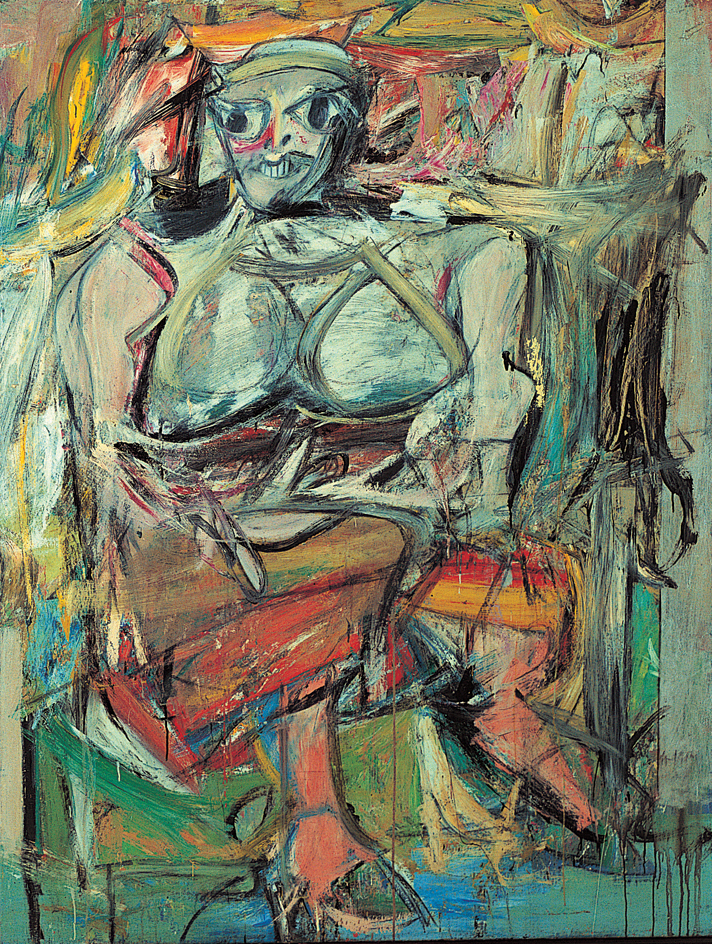
Religious subjects
dominated painting in some parts of the world for hundreds of years. A large number of all the pictures ever painted in Asia are religious. European painters of the Middle Ages and the Renaissance painted more religious pictures than any other kind.
Paintings have played an important part in religious rituals and worship. These paintings have taken a number of forms, including altarpieces and illustrations in prayer books and books of psalms. Worshipers have carried some paintings that they considered especially holy in religious processions.
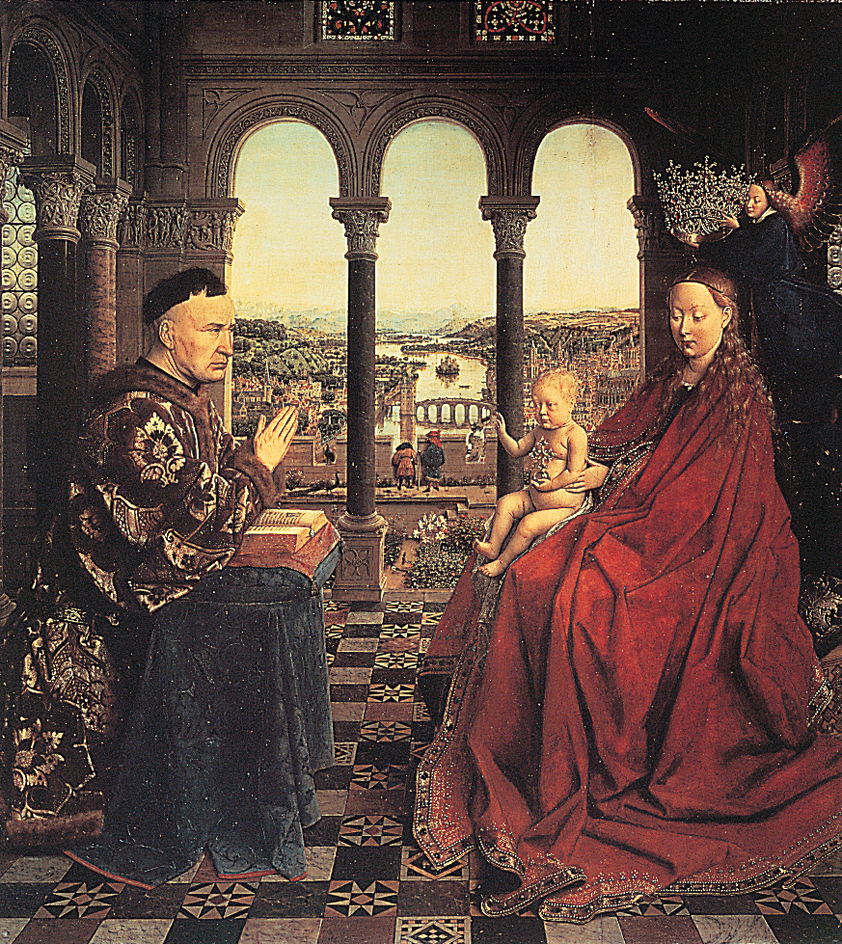
Paintings can also portray the lives of gods and holy people. Many paintings commemorate the birth, ministry, Crucifixion, and Resurrection of Jesus Christ. Examples appear in the Jesus Christ article. Religious paintings can also teach moral lessons. Michelangelo’s The Last Judgment shows the eternal happiness that rewards the faithful and the horrors of hell that will be the punishment of sinners.
Landscapes and seascapes
depict the appearance, power, and atmospheric effects found in nature. The American artist Fitz Hugh Lane recorded the effects of light and space on a clear, calm morning on the New England seacoast in Owl’s Head, Penobscot Bay, Maine.
Landscapes and seascapes also reflect the importance of land ownership and seafaring. In Gainsborough’s Mr. and Mrs. Andrews, the country estate takes up more space than the human figures, symbolizing the importance of the land to the couple. In the Netherlands during the 1600’s, seascapes were popular subjects because much of the country’s wealth and power depended on sea trade.
Chinese artists portrayed the beauty of mountains in landscapes painted in ink on paper or silk and mounted on scrolls. An example is Travelers Among Mountains and Streams by Fan Kuan. The artist intended viewers to journey slowly through the painting with their eyes. Wandering through the picture, viewers closely observe its mountain formations, waterfall, trees, village, and tiny figures of travelers. In Japan, makers of an early type of kimono called the kosode sometimes painted landscapes on the garments, such as Kosode with Plum Tree and Flowering Plants by Sakai Hoitsu.
Sometimes artists used landscape paintings as extensions of real nature. Many Roman gardens had landscapes painted on their walls to extend the real garden by means of make-believe.
Still-life paintings
are close-ups of objects. The objects can be natural, such as fruits and vegetables, or manufactured, such as bottles and rifles. Many still lifes express the bounty of nature and the harvest, or the wealth of patrons or the artist’s society. In the 1600’s, European painters often showed fish shops and vegetable stalls overflowing with goods. In the Netherlands during that time, some still-life artists painted arrangements of food called breakfast pieces. An example is Breakfast Table by Willem Claesz Heda.
Some artists have painted precise, minutely realistic still lifes called trompe-l’oeil (fool the eye). Some artists have made formal, almost abstract compositions of still lifes. One example of this is The Bottle of Banyuls by Spanish artist Juan Gris.
Because flowers and fruits eventually wither and die, artists have sometimes used them to express the passing of time and the decay of matter. In this way, the paintings remind viewers of their own aging and future death.
History paintings
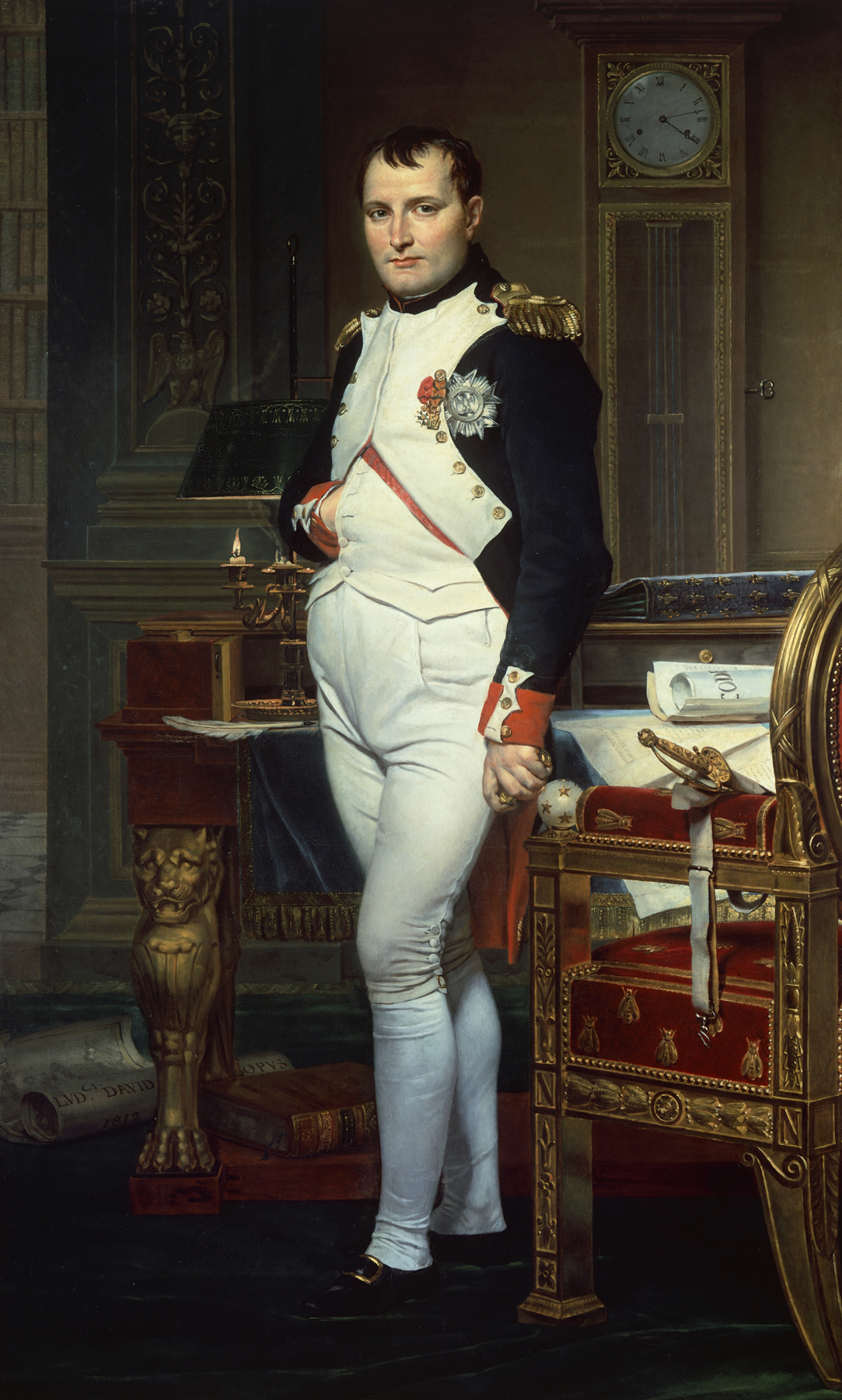
Often a ruler commissions a painting to glorify himself or herself as well as the country. Napoleon I of France made Jacques Louis David his official painter to glorify his reign.
Scenes from Greek and Roman history were popular in European painting because the Europeans considered ancient Greece and Rome the ancestors of their civilization. Sometimes, artists used subjects from ancient times to make a moral or patriotic statement addressed to the viewers of their own day. An example is David’s The Oath of the Horatii. The painting portrays three brothers vowing to their father to fight for the Roman Republic, even though their decision will bring sorrow to their families. The artist is telling the viewer that public duty, self-sacrifice, and patriotism are more important than an individual’s or a family’s personal interests, safety, or happiness.
Mythology paintings
tell stories of gods and goddesses. For example, an ancient Greek artist known only as the Dinos Painter painted a mythological scene on a dinos, a large bowl for holding wine. The god Triptolemos, in the center, is about to depart in his winged chariot drawn by a snake to teach humanity how to cultivate grain. He and the goddess Demeter hold stalks of wheat. At the right, Demeter’s daughter Persephone offers a bowl of wine in honor of the god’s departure.
Social expression
has been a common theme throughout art history. Many artists have painted pictures that express political beliefs or attack social ills, such as war and poverty. The Spanish artist Francisco Goya protested the cruelties of war in such works as The Executions of 3rd May, 1808. The painting shows civilians being executed by a military firing squad.
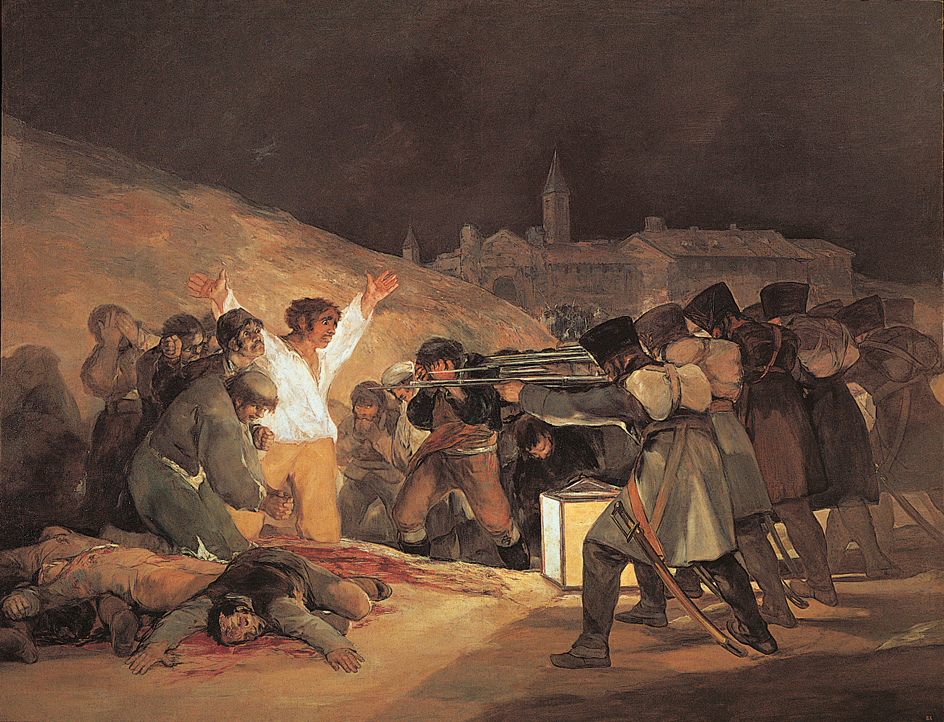
Decoration
has been an application of painting since prehistoric times. Almost all ancient Greek paintings that survive are those that decorate pots, vases, and other ceramics. For centuries, people have hung paintings on the walls of homes as decoration. Wallpaintings decorated the interiors of many palaces and public buildings during the Renaissance in Italy.
Abstract painting
deliberately omits recognizable subject matter. Instead, the artist explores form, color, design, pattern, and texture. Some abstract paintings still express a meaning, even without identifiable subject matter. The American artist Robert Motherwell painted Elegy to the Spanish Republic LV. The abstract painting is one of a series that expresses the artist’s sorrow over the Spanish Civil War (1936-1939). Many abstract paintings, on the other hand, have no meaning. An abstract picture called Mountains and Sea by the American artist Helen Frankenthaler has no significance other than the artist’s interest in color and texture.
The elements of painting
Paintings consist of many artistic elements. The most important elements are (1) color, (2) line, (3) mass, (4) space, (5) texture, (6) composition, and (7) light and shade. These artistic elements are as important to a painter as words are to an author. By stressing certain elements, a painter can make a picture easier to understand or bring out some particular mood or theme. For example, an artist can combine certain colors and lines in a painting to produce intense excitement. The same artistic elements can also be combined in a different way to create a feeling of peace and relaxation.
Color
is one of the most versatile elements of painting. The Spanish artist Pablo Picasso and the French artist Raoul Dufy used blues to create contrasting moods. Picasso evoked a sense of sadness and loneliness in The Old Guitarist. Dufy produced a cheerful, airy scene in Le Haras du Pin.
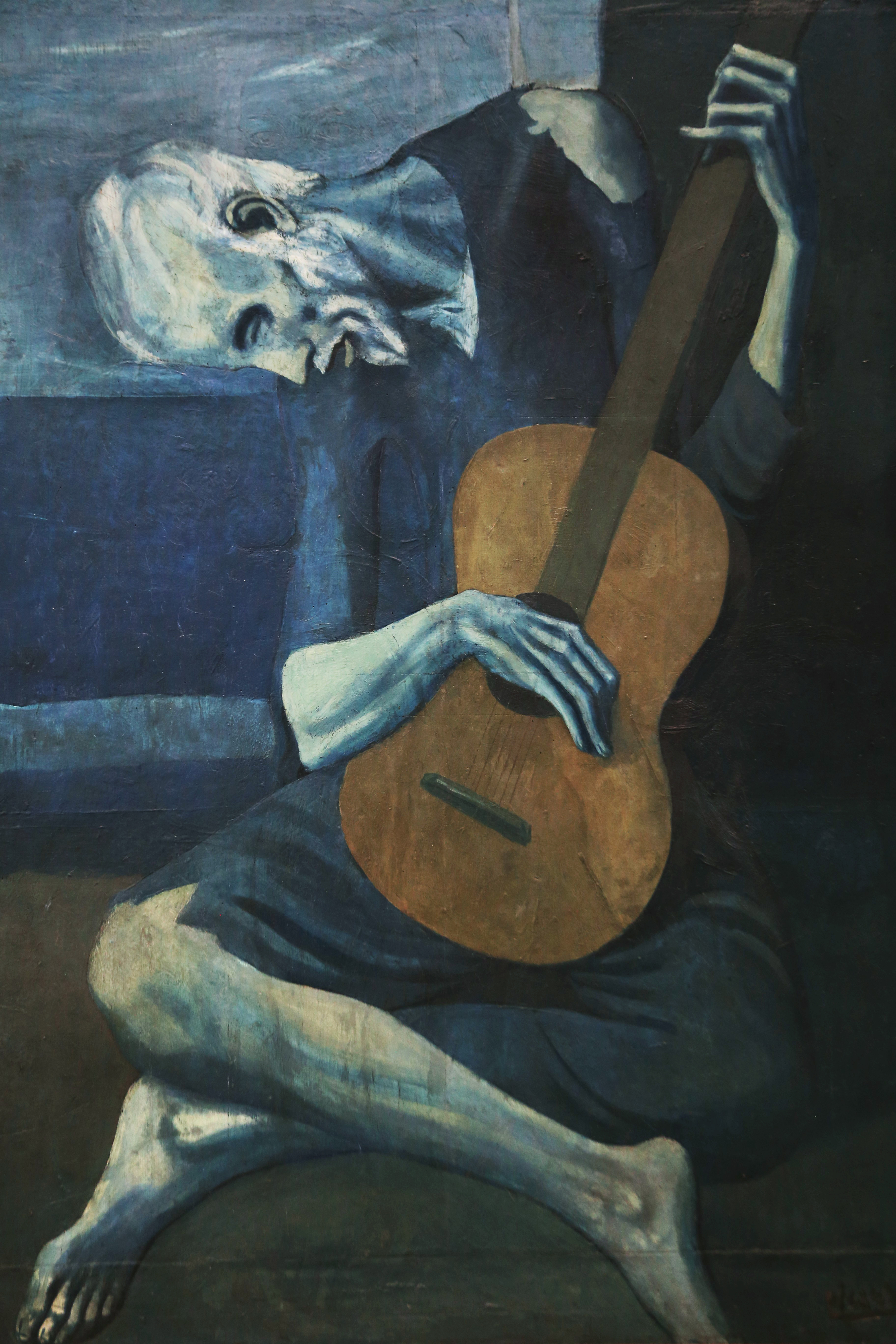
Line
is one way in which artists build up forms in their paintings. Line also defines space and creates perspective, the illusion of depth and distance. Some paintings, such as Chinese landscapes, are composed almost entirely of lines. The Dutch artist Piet Mondrian used lines to define shapes in such abstract paintings as Composition with Red, Yellow and Blue.

Mass
allows an artist to express the feeling of weight in a painting. Mass helps the viewers believe they are looking at three-dimensional objects even though the picture is two-dimensional. The German-born artist Richard Lindner created a sense of power and threatening strength by painting the female figure in Disneyland with a massive lower body.
Space
is the arrangement of lines and colors to create the impression that the flat surface of a painting is actually a window into a three-dimensional world. An emphasis on empty space in a painting can carry emotional meanings. The American painter Andrew Wyeth created a sense of loneliness and abandonment through the skillful rendering of space in Teel’s Island.
A painting with a restricted amount of space can establish a closed-in feeling. The Italian artist Jacopo Pontormo created a dramatic, uneasy feeling through the use of confined, distorted space in Supper at Emmaus.
Texture
refers to the appearance of the painting’s surface. The paint may be thin and smooth or thick and rough. The Dutch artist Vincent van Gogh painted The Starry Night with thick, swirling brushstrokes to portray a sensation of excitement and agitation.
Composition
refers to how elements are arranged in the painting. The artist can choose to compose a flat abstract painting, such as Robert Motherwell’s Elegy to the Spanish Republic LV, or the artist can create three-dimensional space, as in Las Meninas by the Spanish painter Diego Velázquez. Composition determines how the painter wants a viewer to “read” a painting. Sometimes the composition emphasizes the most important people or elements by putting them front and center or on a larger scale. The Italian artist Piero della Francesca directed the viewer’s attention to the risen Jesus Christ by placing Jesus at the top of a pyramid-shaped composition framed by trees. On the other hand, a painting may be composed to allow the viewer’s eye to wander through the picture, as in a Chinese landscape.
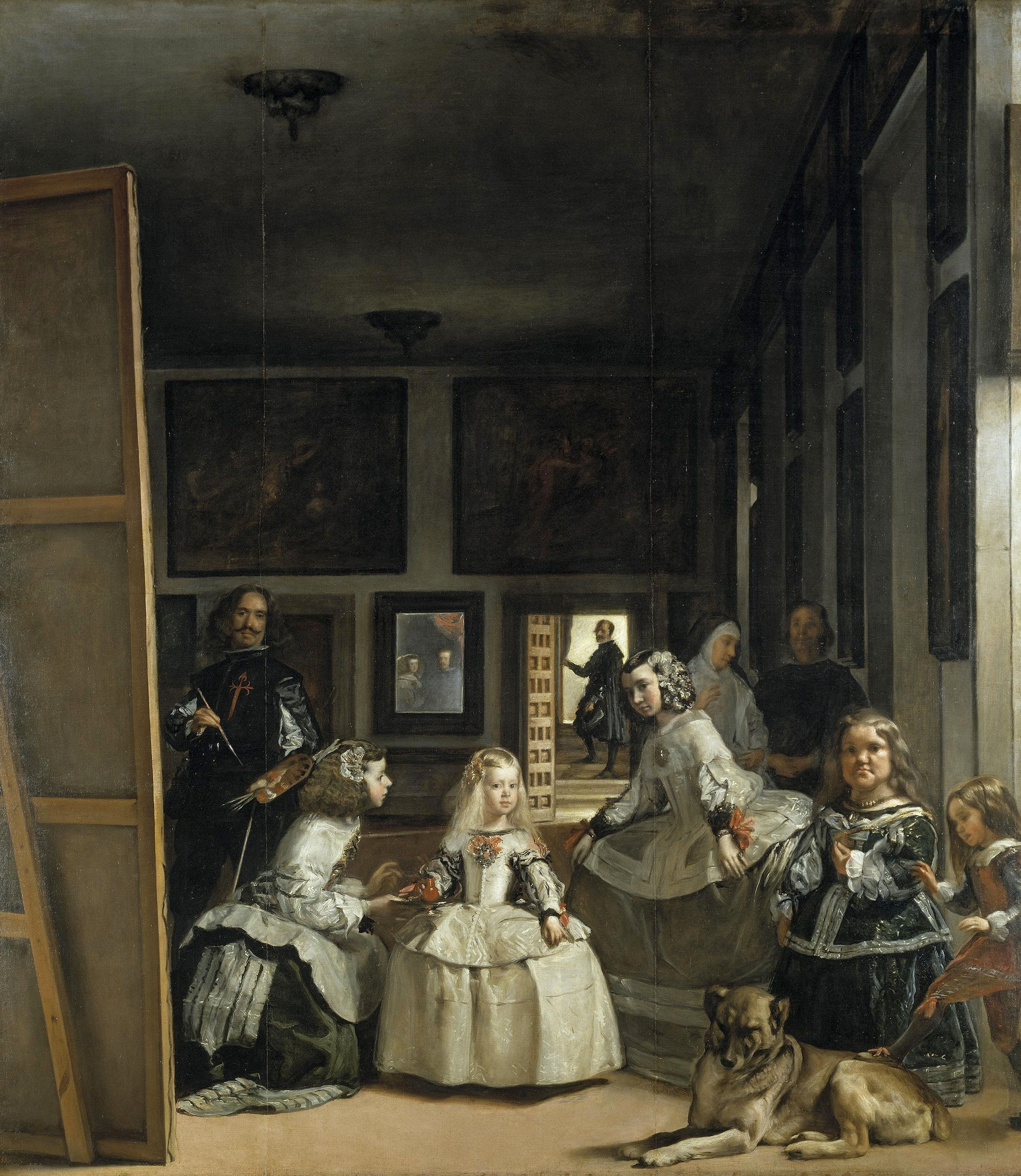
Composition can contribute to the mood of a painting. The Canadian artist J. E. H. MacDonald composed his landscape The Elements to evoke a feeling of nervous intensity. In contrast, the French artist Claude created a feeling of calm order in his landscape The Father of Psyche Sacrificing at the Temple of Apollo.

Light and shade
can be used to define form and mass, to direct the eye within the composition, to create space, and to change colors. The French artist Claude Monet created a series of paintings of Rouen Cathedral in France. In this series, the angle and intensity of the light at different times of day determine how the viewer sees the architectural forms of the cathedral.
The Dutch painter Rembrandt skillfully used bright light and deep shadow to establish a tragic mood in The Descent from the Cross. Light or its absence can have a symbolic meaning. In The Oregon Trail by the American painter Albert Bierstadt, a wagon train travels into a brilliant afternoon sun. The glowing light symbolizes hope for the pioneers. In Motherwell’s Elegy to the Spanish Republic LV, the darkness of the abstract forms symbolizes death, while the white background represents life.
Materials and techniques
From prehistoric times to the present day, the painting process has remained basically the same. Artists use powdered color called pigment combined with a binder that holds the particles of pigment together. The artist may thin the paint, usually with water or turpentine, so it can easily be applied with a brush or brushlike implement onto a support. The support is a surface that could range from a prehistoric cave wall to a modern piece of canvas.
The process of painting has not changed over time, but the materials and techniques have changed greatly. Today, artists have many more pigments available to them than they did in ancient times and a much wider variety of binders, thinners, brushes, and supports. Depending upon what choices the artists make among these materials, they can achieve an almost limitless variety of effects.
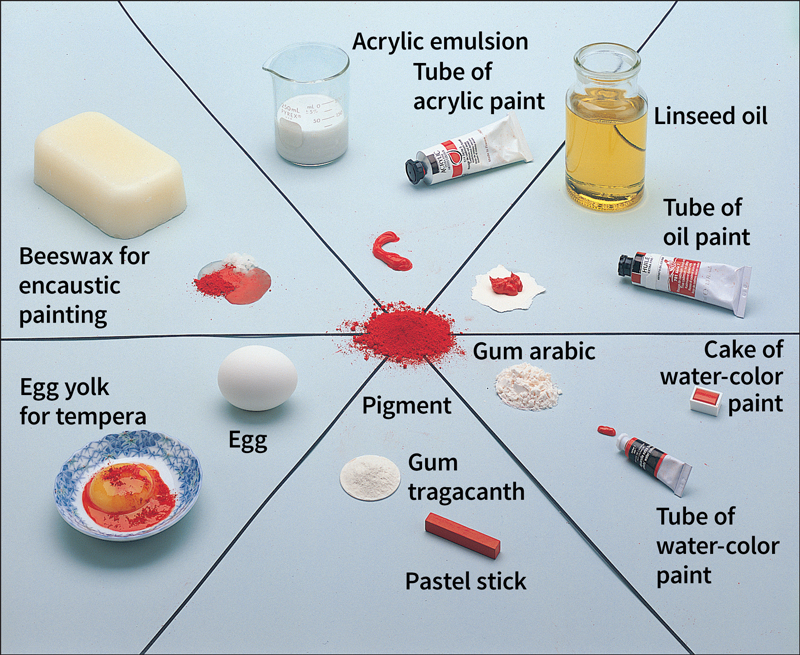
Pigments.
Good painting pigment should be permanent. It must be capable of withstanding normal changes in atmospheric conditions, including light, temperature, and even pollution.
During the Renaissance of the 1400’s and 1500’s, Italian artists processed iron oxides to produce a range of red, yellow, and brown pigments. They also produced green pigment from copper dioxides. In the late 1800’s, artificially produced pigments began to replace the less stable and increasingly rare natural colors. Today, synthetic pigments are the most common color elements in paint.
Binders
protect the pigment from changes in atmospheric conditions and serve as an adhesive to anchor the paint to the support. Common binders include vegetable gum arabic and linseed oil.
Different binders have different characteristics. Some dry quickly and others more slowly. Some create an almost transparent paint, while others are opaque—that is, they cannot be seen through. The same pigment used in water color, for example, will look different in oil paint because the binder in each possesses different degrees of transparency.
Thinners
reduce the viscosity (thickness) of a paint so the paint can be more easily applied to the support. Different binders require different thinners. Water is used to thin water color and paints made of synthetic resins. But because oil and water do not mix, water cannot thin oil paint. Instead, painters commonly use turpentine or mineral spirits.
Most thinners are flammable. Many are toxic (poisonous), capable of causing minor skin irritations or even permanent damage to the lungs, liver, heart, and brain. Painters should wear goggles and gloves when handling most thinners. Many artists use protective creams under their gloves. The use of thinners requires adequate ventilation. The studio must be cross-ventilated with a minimum of two open windows and an exhaust fan.
Supports.
Almost any surface can serve as a support for a painting—a wall; a piece of bark; a panel of wood; or a sheet of fabric, paper, metal, or glass. For much of the history of painting, walls and ceilings were the primary supports. But such surfaces have a basic limitation. The painting, once in place, cannot be moved.
By the 1400’s, artists began to paint on supports that were small, light, and portable. They first painted on lightweight wood panels, and later on canvas stretched tightly on a wooden frame. Paper also became an important support. The Chinese, who invented paper more than 2,000 years ago, first painted on it. The material became widely available in Europe in the late 1400’s. Paper is fragile, but its porous character makes it the preferred support for water color.
Grounds.
Most supports are too absorbent to allow the easy application of paint. Artists usually prime (pretreat) a support with one or more coats of a special paintlike material called a ground. The only exception is paper for water colors, because the paper’s absorbency is right for the paint. Grounds also make the support surface smoother or more uniform in texture. Many grounds, especially white grounds, increase the brightness of the final picture. The three most common grounds are (1) oil ground, (2) glue gesso, and (3) polymer gesso.
Oil ground is made with white pigment, often white lead, in a binder of linseed oil thinned with a small amount of turpentine. After drying, normally in about three days, the oil ground is lightly sanded and a second coat is usually applied. White lead is toxic, so painters should use extreme caution in preparing white lead oil ground. Artists prefer oil ground when they paint on canvas.
Glue gesso is a mixture of white chalk and glue dissolved in hot water. It forms a brittle plasterlike surface that tends to be too stiff for canvas. Glue gesso is used most widely on wooden or wall board panels.
Since the mid-1900’s, acrylic gesso has become increasingly popular. It provides a ground of brilliant white that retains flexibility. It does not, however, form a ground suitable for oil painting. Oil paint becomes increasingly brittle with age, while acrylic gesso retains its flexibility. If the two were used together on large oil paintings on fabric, the paint might separate from the ground.
Other materials.
When painting with oils or oil-based paint on fabric, the artist must size the support before applying the ground. The size is a solution of glue, thin enough to penetrate the pores of the support and cover it with a continuous, even film. The size separates the canvas or paper from the oil to protect the support. If oil comes into direct contact with canvas or paper, the support will rot.
Artists apply paint with brushes and painting knives. Brushes come in many sizes and shapes. Bristle brushes are made from the hair running down the spine of a hog from neck to tail. Sable brushes are made from the hair of ermine, martens, and weasels.
Painting knives come in almost as many sizes and shapes as brushes. They are used particularly to apply paint in thick, bold strokes. Areas of thickly applied paint are called impasto.
The artist mixes paint on a palette. Almost any flat surface can serve as a palette. Traditionally, palettes have been made of wood, but glass palettes have become increasingly popular because they are easy to clean.
Encaustic painting
is made by combining pigment with a hot wax binder—pure beeswax is preferred. Encaustic is one of the oldest techniques in painting. It was widely used in ancient Greece, though few paintings from that period survive.
The encaustic process is demanding. The artist must work quickly, with short brushstrokes, because molten wax hardens soon after it is removed from heat. Colors are difficult to blend because one will have hardened as the other is prepared. However, some blending is accomplished in a burning-in process in which the painted surface is reheated. The brushstrokes can be blended at this point. The burning-in process also allows the wax to stick to its gesso ground.
Although encaustic was virtually abandoned for centuries, the invention of electric heating elements in the 1900’s made the technique more practical. Modern painters can use an electric frying pan as a palette and a heat lamp for the burning-in.
Fresco painting
is a wallpainting technique. The artist applies pigment to a lime plaster wall. When the paint, mixed with water, is applied to a freshly plastered wall, the process is called buon fresco (good, or true, fresco). When paint is applied to a dry wall that has been moistened, it is called fresco secco (dry fresco). In buon fresco, the fresh lime plaster absorbs the wet pigment, and the painting becomes part of the wall. In dry fresco, the damp plaster never blends with the paint, which has been mixed with binders such as casein, egg yolk, or glue. Over time, moisture can penetrate between the paint and the wall, causing the paint to crack and peel. See Fresco. 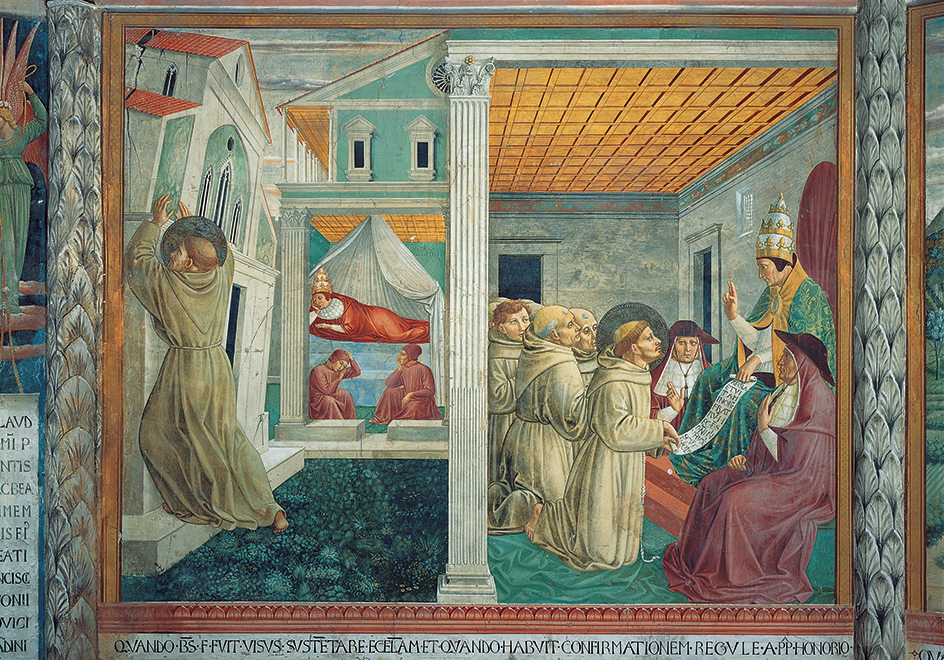
Tempera
is a technique in which dry pigment is mixed with a little water to make a paste. Fresh egg yolk is then added equal to the amount of paste. The artist carefully applies the paint with the tip of a fine brush, preferably sable, to a smooth ground prepared with gesso. Tempera dries almost immediately into a water-resistant coating. Because the paint dries so quickly, colors cannot readily be blended. Effects of shading must be accomplished through short lines called hatching. The denser the lines, the darker the shaded areas will be.
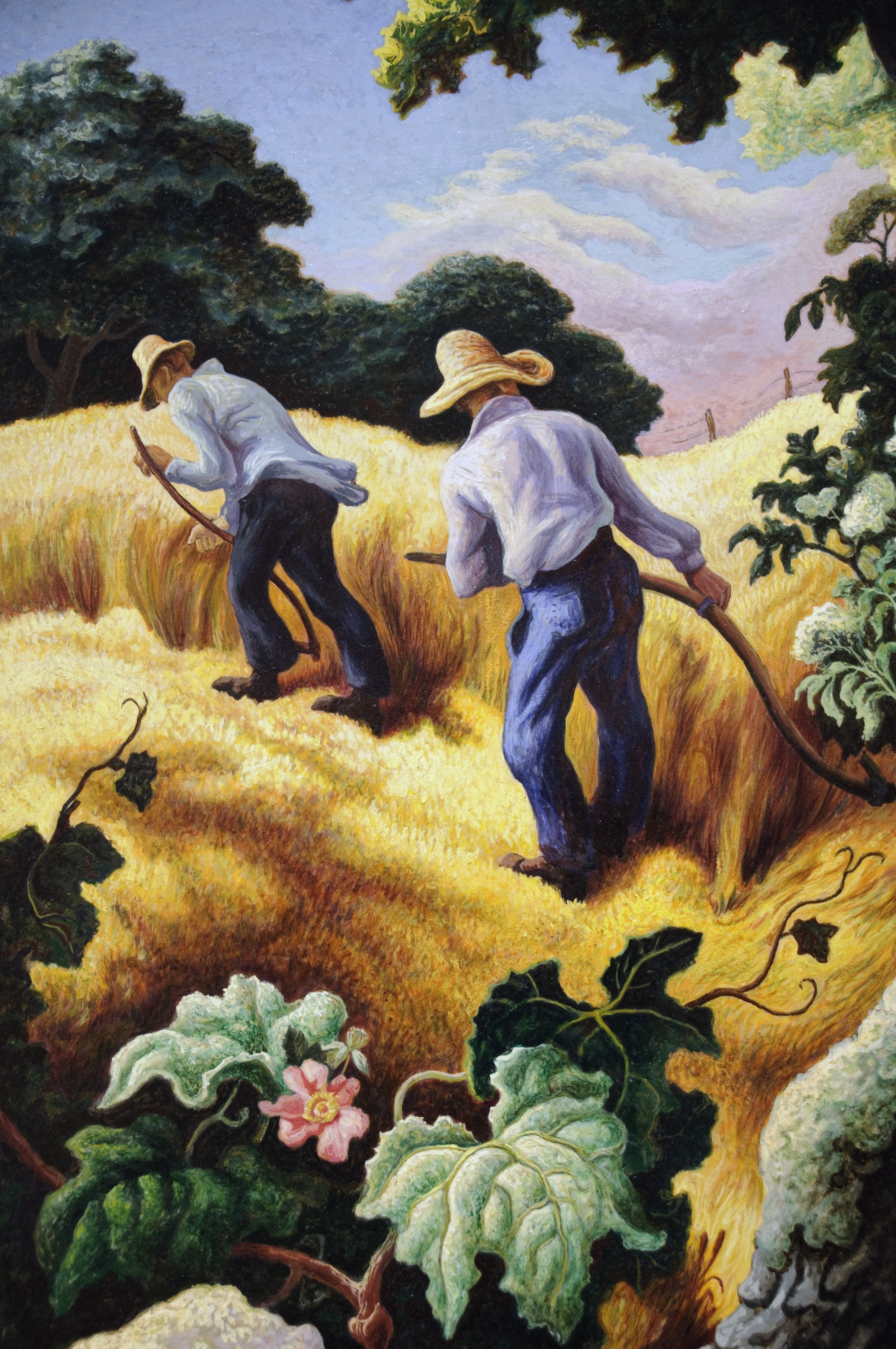

Tempera painting uses fine, crisp brushstrokes that produce detailed images of extreme clarity and precision. The gesso used as a ground is fully absorbent. When it combines with the tempera, it creates a durable surface that seems to glow. Tempera painting was largely replaced in the 1500’s by oil painting. However, several modern artists, including Ben Shahn and Andrew Wyeth, have adopted tempera to take advantage of its characteristic soft, warm light.
Oil painting.
Unlike tempera, oil paint can be blended on the painting surface to create a continuous scale of tones and hues. Many shades, especially darker ones, were impossible before the invention of the technique. Using oil paint, the artist can render subtle changes in light and achieve realistic three-dimensional effects. Even more important for the artist, oil paint dries slowly, allowing the artist to work almost endlessly to perfect the image.
Oil paint is made by mixing powdered pigments with a binder of vegetable oil, usually linseed oil. The pigment can be thinned by adding a solvent, such as turpentine. This solution can make thin films of almost transparent color that glaze the painting’s surface. The glazing lends a luminous sense of reality to the images.
In oil paint, artists are free to express their personalities through their brush marks. The trail of the brush’s path across the painting surface is almost like the artist’s autograph. This is especially true when the artist brushes new paint into the undried surface so that it mixes freely with what has previously been painted. The painter’s emotions can be detected in the intensity of the brushwork.
Pastel
is the painting technique closest to drawing. The artist uses a colored chalk pastel stick. Holding the stick like a pencil, the artist can work rapidly to create broad strokes of color or short, crisp lines.
Pastels are made of pigment held together by a weak, nonliquid adhesive binder such as gum tragacanth. Pastels are labeled soft, medium, or hard, depending upon how much adhesive is used. Because the pigment is diluted by increased quantities of adhesive, the harder the stick, the less intense its color. Artists seeking brighter colors must work with the fragile softer sticks. Because there is no liquid binder to hold the pigment to its ground, pastel colors rub off easily. To protect the colors, a solution of glue or resin called a fixative can be sprayed over the finished picture.
Water-color painting
is made by applying pigments suspended in a solution of water and gum arabic to a ground of dampened paper. The paint is transparent. The more water added to the paint, the greater its transparency and the softer its tone. Water color readily spreads through the fibers of the paper, making the edges of the broad painted areas, called washes, characteristically soft and fluid. Harder and more precise lines can be achieved by applying relatively undiluted color with a pointed brush, or even by drawing on the painting with a pencil or with pen and ink.
Water color is one of the oldest painting techniques, used by ancient Egyptians to illustrate papyrus scrolls. However, artists did not begin to explore the expressive potential of the medium until the 1800’s. Artists found that water-color equipment was light and easy to use outdoors, and the paintings dried quickly. As a result, the technique was especially suited to making quick, sketchlike studies of nature.
In one variety of water color, called gouache, white pigment or chalk is added. Gouache paintings are characterized by broad, flat areas of color.
Synthetic resins.
Starting in the 1930’s, painters began to experiment with binders made of synthetic resins. Mexican mural painters pioneered in the development of synthetic resin paints. Painting outdoors, the muralists worked first in fresco and then oil paint, but the sun, rain, and humidity of Mexico jeopardized their works. In 1936, muralist David Siqueiros organized a workshop in New York City specifically to experiment with synthetic paints. One of the first synthetic paints he used was pyroxylin, commonly known as Duco, a lacquer developed as an automobile paint.
By the mid-1950’s, researchers in Mexico and the United States had developed a way to mix acrylic resins with water. An artist using acrylic paints can produce works that look almost identical to oil paints. Alternatively, by thinning the paint with water, the artist can create works that resemble water colors. Because there is no chemical reaction between an acrylic resin and its ground, artists can paint with acrylics on unprimed supports.
Acrylic paint can be used on almost any surface. It dries rapidly and is extremely durable. Painters seeking a longer drying time to simulate some of the effects of oil painting add retarders to the paint. But even then the paint normally dries within an hour. Because acrylic paints are water-based, they are far less toxic than oil paints and safer to use in closed environments.
Early painting
Prehistoric painting.
The earliest known paintings date from about 30,000 years ago, during the Paleolithic Period, also known as the Old Stone Age. Prehistoric paintings are found on the walls of caves in Australia, France, Italy, Portugal, and Spain. Archaeologists believe that Aboriginal people of Australia may have made cave paintings even earlier than 30,000 years ago.
The earliest paintings show animals, human beings, and arrangements of lines and other abstract signs. The artists used earth pigments such as manganese and ochers for red, yellow, and brown; and charcoal for black. They drew directly onto the walls with lumps of these pigments; or they mixed finely ground pigments with water and daubed, brushed, or blew them on. By chance, the pigments, mixing with the moisture in the cave walls, bonded chemically with the limestone to produce the first frescoes.
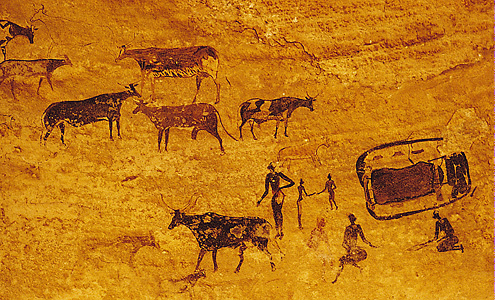
The most common subjects of cave paintings are large animals—horses, cattle, bison, deer, and mammoths. Many paintings show close observation, with subtle shadings of color, producing a startling realism. Some of the most famous cave paintings were discovered in a cave in Lascaux, France.
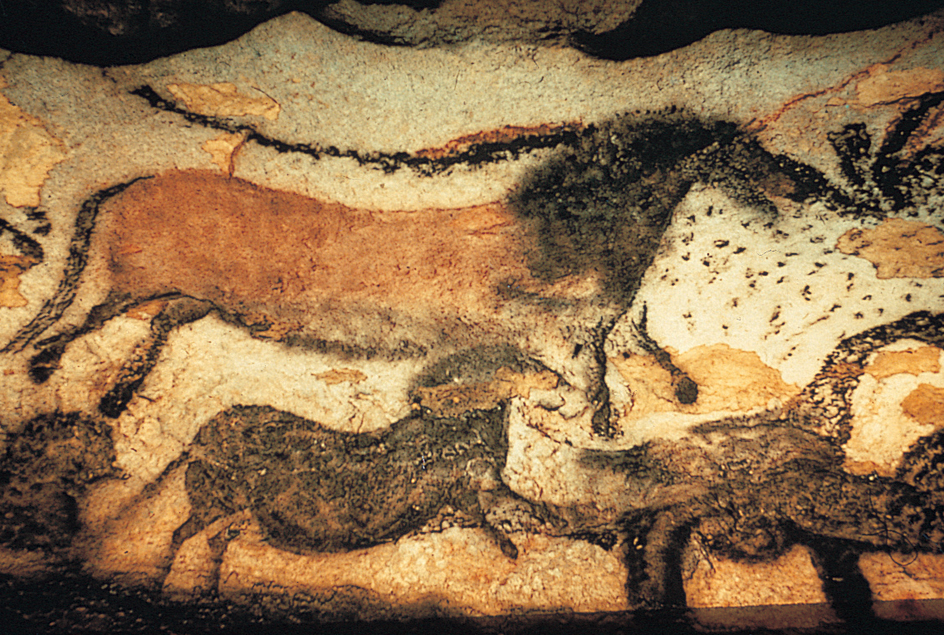
No one knows exactly why artists painted pictures on cave walls. Scholars agree, however, that cave paintings were not just decorative. Most paintings are in dark and nearly inaccessible parts of caves, difficult places to paint or see the pictures. The art may have served as magical aids in hunting or fertility, as part of initiation rites, or in other ways that were important to early peoples. Between about 8000 and 3000 B.C., during the Neolithic Period, or New Stone Age, artists painted pictures for the first time on the walls of religious chambers or shrines, and on objects, such as pottery.
Egyptian painting.
Most Egyptian painting that survives comes from papyrus scrolls and the walls of tombs. The earliest paintings were simple designs, dating from about 3000 B.C. During the time of the Old Kingdom (about 2650 to 2150 B.C.), Egyptian artists normally carved scenes in low relief on tomb walls and then painted the reliefs. The scenes depicted Egyptian deities and daily life. The Egyptians believed these subjects were necessary to ease a person’s journey to the land of the dead and to provide for that person in the afterlife.
From the Middle Kingdom (about 1975 to 1640 B.C.) through the New Kingdom (about 1539 to 1075 B.C.), artists covered the limestone walls of the tombs with a fine layer of plaster and painted the scenes of deities and daily life directly on the plaster. Painters used few colors, primarily black, red, yellow, brown, blue, and green. They mixed their colors in a binder to make them stick to the dry plaster. By applying the colors thinly or thickly, or by mixing them with black and white pigments, the Egyptian artist could achieve a great range of colors and values.
The Egyptians wanted their tombs and paintings to last for eternity, especially paintings of important people, such as nobles and pharaohs. Artists developed a highly stylized way of showing these important people. They showed each part of the body in its most recognizable form. For example, they drew faces, feet, and legs in profile. They showed the eyes, shoulders, and torso from the front.
Egyptian artists painted figures in flat colors without shading. They used dark red or brown for the flesh of men. They painted women’s flesh in yellow, white, or pale brown.
Nobles and pharaohs sat stiffly or stood solidly on lines representing the ground. Egyptian artists often made members of the nobility larger than other figures in a scene to show their greater importance. The artists portrayed less important people, such as workers, servants, and enemies, in more natural poses and more comfortable movement.
The rigid style conventions of Egyptian painting relaxed slightly during the period of the New Kingdom, reflecting the influence of cultures that flourished on Crete and the nearby islands and shores of the Aegean Sea. An example is the more casual pose seen in the tomb painting Fowling in the Marshes. When Egypt came under Roman rule, starting in 31 B.C., portraits of the dead on mummy cases followed the style of Roman painting. Painters posed the bodies in three-quarter view, with the faces nearly frontal. The forms are subtly shaded, using fine strokes of dark and light. However, most tomb paintings from the period of Roman rule followed the style of the period of the Old, Middle, and New Kingdoms.
Aegean painting.
The term Aegean is used for the civilization that flourished between about 3000 and 1100 B.C., during the Bronze Age in and near Greece. This civilization was made up of four cultures. The Minoans inhabited the island of Crete. The Cycladic people lived on islands in the Aegean Sea. The Mycenaean culture, also called the Helladic culture, developed on the Greek mainland. The city of Troy, in what is now northwest Turkey, was a center of western Anatolian culture. Most surviving Aegean painting comes from ceramic vessels and the walls and floors of palaces, villas, and shrines.
Aegean artists painted subjects from nature, including scenes of plants and animals of both land and sea. Many paintings add scenes of religious processions and festivals, along with images of goddesses. Mycenaean and Cycladic painting includes scenes that depict warfare.
The best Aegean wallpaintings come from the Palace of Minos at Knossos on the island of Crete, but these paintings have survived only in fragments. The most complete Aegean paintings come from the Cycladic island of Thira (also spelled Thera). These paintings show scenes of festivals, animals, battles, sports, and religious ceremonies. One shows a landscape. Many scholars believe that all these paintings had religious significance. 
Aegean art emphasized some of the same conventions used in Egyptian art. For example, Aegean artists normally painted faces in profile, with a frontal eye. They contrasted the skin of males and females by color. However, Aegean artists applied their colors more thinly and freely than Egyptian artists and more often painted on wet plaster in the true fresco technique. Figures painted by Aegean artists are also more active than Egyptian figures. They move comfortably and are often shown in profile. Figures painted life-sized usually stand close to the front of the picture and are set against a neutral background. However, other figures inhabit complex landscape and architectural settings. Aegean artists indicated distance by placing some figures and buildings higher on the wall.
Greek painting.
The earliest Greek painting dates from the 1000’s B.C. and is found on vases. Early painters preferred pure ornament, such as lines, circles, and other patterns. They drew figures in black silhouette but based the figures on geometric shapes. The period from about 900 to 700 B.C. is known today as the geometric style.
In the 600’s B.C., vase painters created scenes from mythology as well as from everyday life. Artists still drew figures in black silhouette. But painters in the city of Corinth cut fine lines into the black silhouette to show detail, and artists in Athens often painted figures in outline to achieve more precise form. Basically, however, artists still showed figures in the old Egyptian style. They painted male figures black, but left female figures in the light color of the clay or painted them white.
About 625 B.C., artists in Athens adopted the black-figure technique invented in Corinth in the early 600’s. In black-figure painting, the figures are painted in black silhouette. Artists cut details into the surface or added them in red and white. Athenian black-figure vases are the best examples of Greek painting of the 500’s. The vases show scenes from Greek mythology as well as simple scenes of daily life that provide some of the most important visual documents of the time. Achilles and Ajax Playing Checkers by Exekias is an example.
About 530 B.C., Athenian painters invented the red-figure style. In red-figure painting, the figures are left in the natural red color of the clay, and details are painted in black with a brush. The red-figure technique freed artists to experiment with a new realism. Almost immediately, artists began to depict figures twisting and turning in space. By the mid-400’s B.C., artists were placing figures on different levels of the vase’s surface to indicate relative distance.
The 400’s and 300’s marked the great age of Greek wallpainting, but none of these paintings has survived. Artists also painted simple scenes of figures on gravestones and more complex ones on the walls of monumental tombs, especially in the historical region of Macedonia in northern Greece. Superb paintings from the 300’s decorated royal tombs in the ancient city of Vergina. The painter placed the action within a landscape setting. The figures are shaded, and almost all are shown in three-quarter view to emphasize the depth of the space in which they act. The artist placed some figures higher on the surface than others in order to further indicate depth.
Etruscan painting.
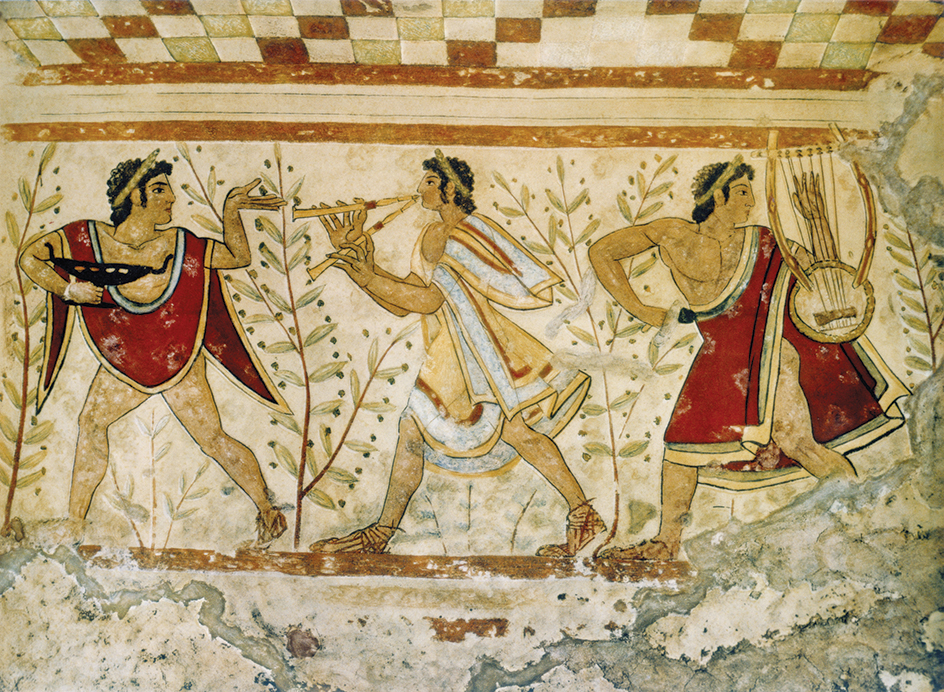
Roman painting.
By the late 100’s B.C., Rome had conquered Etruria and Greece, incorporating both regions into the Roman Empire. From these conquered lands, Rome inherited traditions that formed the foundation of its artistic style. The Greeks and Etruscans had limited large-scale painting to public buildings and tombs. However, the Romans used painting primarily to decorate the walls of their houses.
Roman painting is best known from the cities of Pompeii and Herculaneum. Both were buried and preserved by the volcanic eruption of Mount Vesuvius in A.D. 79. Additional Roman paintings have survived from the villas near the mountain. Based on the discoveries at Pompeii and Herculaneum, scholars have generally divided Roman painting into four Pompeiian styles based on the decorative scheme of the wallpaintings.
The first style (late 100’s to 80 B.C.) featured modeled stucco in relief to imitate large, neatly cut stone blocks. Artists often painted these simulated blocks to imitate colorful marble or other costly stone.
The second style (80 to 15 B.C.) created the illusion of monumental architecture. Artists employed perspective, shading, and shadows to make paintings of columns and other architectural elements that fool the eye with their realism.
The third style (15 B.C. to A.D. 63) rejected the illusion of depth. Instead, artists painted the walls as solid surfaces enlivened with delicate decorative detail.
The fourth style (A.D. 63 to 79) is the best-preserved style. It mixes features of the second and third styles in its real-looking architecture combined with solid areas, rich colors, and decorative detail. An example is Landscape with Polyphemus and Galatea from a villa near Pompeii that was buried in the Vesuvius eruption.
From the second style onward, walls in Roman houses became picture galleries displaying the strong influence of Greek master paintings. In the second style, the wall became the picture itself. In the third and fourth styles, artists painted panels that seem to hang on the walls. Many of these paintings illustrated Greek myths. Others were still lifes and genre scenes.
Roman artists did not merely copy Greek paintings. They reinterpreted them to Roman tastes, often emphasizing landscapes. Artists reduced the size of figures and focused instead on depicting craggy rocks and turbulent seas, delicate foliage, and airy skies. Roman artists also added new subject matter, especially during the second style, when they painted lifelike gardens behind their real-looking architectural scenes.
Roman artists also made technical innovations. They introduced the concept of achieving depth by diminishing the size of figures meant to be farther away. They developed atmospheric perspective, the technique of showing distant objects as hazier and more blue in color than objects nearby. After the decline of the Pompeiian styles and until about A.D. 400, portraiture was the predominate subject of Roman painting.
Asian painting
Asian paintings have been created by many cultures that differ from each other in time, geography, and social values. There are three main artistic traditions in Asian painting. One developed in southern Asia, especially India, but also in Indonesia, Sri Lanka, Nepal, and Tibet. Another tradition emerged in east Asia, primarily China, Korea, and Japan. The third comes from the Islamic countries that range from Spain to central Asia and northern Africa.
Indian painting
is primarily religious art that deals with themes and beliefs related to the main religions of India—Buddhism, Hinduism, Jainism, and Islam. The earliest paintings in India developed in response to Buddhist needs to communicate religious ideas to the faithful. Paintings of deities and of stories associated with Buddhism covered the walls of temples and monasteries, as well as palaces and mansions.
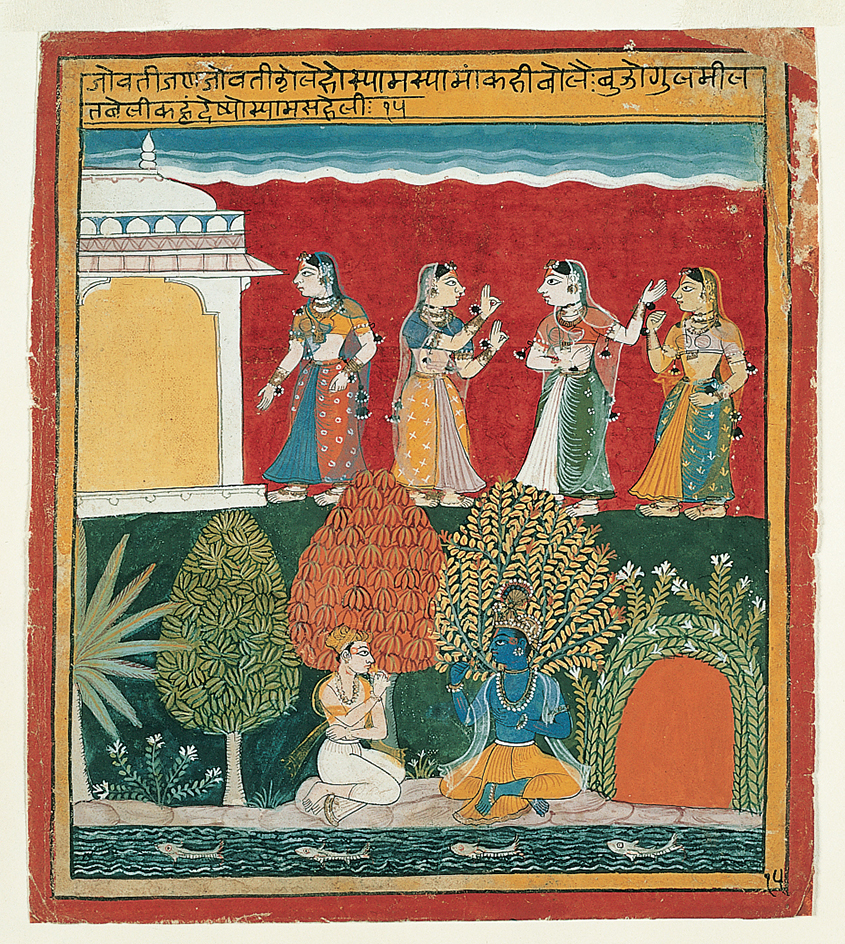
The great Buddhist cave paintings at Ajanta in western India are the best existing examples of the early wallpaintings. Most of them were painted in the A.D. 400’s, during the Gupta dynasty, an era known for great poetry, drama, and dance as well as the visual arts. The paintings provide information on court life as well as religious imagery.
Most Indian painting was later done on palm leaves and still later on paper. This painting dates from the late A.D. 1000’s. For the next 700 years, Indian painting was essentially an art of book illustrations, meant to be held and examined at close range. Painters used natural vegetable and mineral pigments and even added parts of insects to their paintings, all according to formulas passed down from master to pupil.
From the time of the Ajanta wallpaintings, Indian painting evolved in a direction that favored flat planes of vivid color, angular movement, and wiry line. By the early 1500’s, this style, with large flat areas of bold color and simple compositions, was associated with the Rajput courts of northwestern India. These courts followed the Hindu religion. The painters in the Rajput courts chose stories of gods and mythical heroes for their themes. The life of the god Krishna was popular in every period of Rajput art. Krishna was the ideal child, lover, hero, and religious teacher, as well as the model for masculine behavior.
The ancient Hindu epics the Mahabharata and the Ramayana were also popular subjects. Another common subject was a collection of Indian musical compositions called ragas. Painters transformed poetic descriptions of these musical melodies, each with its own mood, into visual images called ragamalas.
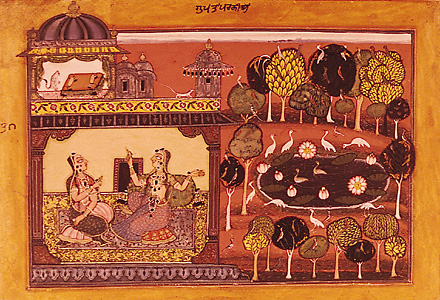
The Muslim Mughal (or Mogul) dynasty conquered India in 1526 and reigned until the mid-1800’s. Painters working in this dynastic period introduced new subjects—illustrated histories, literary works, and portraits. The scene A Ruler on Horseback Leading an Army Across a Battlefield, from an illustrated history, reflects a new concern for detail and setting. This concern led to more complex compositions, subtle and varied color, and individual characterizations of figures.
Artists found continuous employment at Mughal courts. Under the Mughals, both Indian and Persian artists created a distinct style of manuscript illustration. The style combined Indian intensity and feeling for nature with Persian technical refinement and European realism. Knowledge of European art came from prints and paintings introduced by merchants and by Jesuit missionaries sent to India to convert the people to Christianity.
Some Mughal painting turned away from manuscript illustration to the production of individual pictures, such as portraits and studies of animals and flowers. These pictures were mounted in decorated borders and bound in albums.
Chinese painting
is closely linked with the older art of writing and evolved directly from it. The Chinese have long considered beautiful handwriting, called calligraphy, to be the highest form of art. Chinese artists used the same tools for calligraphy and painting—a flexible brush, a silk or paper support, and an ink stick. The Chinese had begun painting word pictures on silk as long ago as the Shang dynasty (1766-1045 B.C.). The smooth surface of silk inspired painters to also create other kinds of pictures, such as those of people, animals, and spirits. Paper became another popular surface for painting, soon after it was invented in China in the 200’s B.C.
The quality of the ink is important in Chinese painting. Artists make ink by mixing oil or soot produced from burned pinewood with glue and then drying it into a stick. This ink produces a lustrous black that, when diluted with water, creates a full range of tones from deep black to pale gray. To make liquid ink, the artist rubs the stick on a stone that has an indentation to hold a small pool of water. Brushes have an absorbent core and a flexible tip that create both flowing strokes and bolder, rugged lines of varying widths.
During the Han dynasty (2066 B.C. to A.D. 220), great masters of calligraphy appeared, and writers composed essays devoted to calligraphy as an art form. The craft of beautiful writing was given prestige beyond its usefulness for communicating information. The flexible brush used for calligraphy could transmit the hand movements of the writer, which led to the belief that one could interpret character and personal qualities through calligraphic forms.
Gu Kaizhi was one of the earliest and greatest of the ancient painters. He lived during the A.D. 300’s. He was famous for painting figures and portraits, but he also painted landscapes. The most famous work attributed to him, but probably a copy, is the hand scroll Admonitions of the Instructress to the Court Ladies. It consists of texts that alternate with illustrations of figures set in a plain background. The painting conveys the character of the early Chinese painting style in the vitality, delicacy, and firmness of the brushstrokes, as well as in the faces that display character and emotion.
Records tell of many great painters who lived during the Tang dynasty (618-907). Tang artists painted portraits, animals, and scenes of court life, but none of their works has survived. Literary sources report that the palaces and temples of the capitals were covered with magnificent wallpaintings. Such paintings in tombs near Xi’an suggest the high quality and dignified character of this Tang art. Cave paintings from western China convey the Buddhist imagery of the period.
The most important development in Chinese painting was the appearance of landscape as an independent subject and not merely as a background for figures and human action. A philosophy called Neo-Confucianism was responsible for making nature a proper subject for art. The philosophy flourished during the Five Dynasties and Ten Kingdoms (907-960) and the following Song dynasty. Neo-Confucianism taught that nature is infinite and eternal and can be studied and understood.
The Song (or Sung) dynasty became one of the classic periods of Chinese painting. Historians have divided the dynasty into the Northern Song (960-1127) and Southern Song (1127-1279). Beginning with the Song dynasty, great masters frequently distinguished themselves in both painting and calligraphy. The high esteem given to calligraphy carried over into calligraphic painting.
The earliest surviving Chinese paintings are funeral banners on silk from the 100’s B.C. However, the most important Chinese painting formats are the horizontal hand scroll, which is read from right to left; the vertical hanging scroll; and small paintings that served as leaves for albums.
During the Northern Song era, landscape came to dominate painting. Painters used calligraphic brush technique to represent rugged mountains and flowing streams, and also to reflect Chinese attitudes toward the natural world. They worked solely in tones of black ink and used brushstrokes to create mass and texture.
Artists painted large compositions on horizontal hand scrolls and vertical hanging scrolls, such as Fan Kuan’s Travelers Among Mountains and Streams. This work is typical of the monumental landscapes of the time that portray an ideal, permanent, and ordered vision of the world. It is carefully organized and filled with complex detail.
Beginning with the Song period, the Chinese distinguished between amateur and professional ideals in painting. Amateurs were scholars or government officials who turned to painting as a means of self-expression. These painters were not concerned with realism and artistic technique, but with the expression of individual character. Chinese art criticism from the mid-1300’s to the early 1900’s supported the scholar-painter ideal as the only acceptable one.
The ideal of the scholar-painter became dominant during the Yuan period (1279-1368), a major era in Chinese painting. The art of the Yuan period reached its peak with the work of the “Four Masters”—Huang Kungwang, Ni Tsan, Wu Chen, and Wang Meng.
Through the influence of the Yuan painters, painting came to function less as an image of nature than as an expression of style. For the amateur painters, the subject, whether it was landscape, bamboo, or an orchid, was a means through which they could reveal their personality. Inscriptions came to play a large role in their paintings. The artists wrote poems on the paintings as a further expression of their feelings. These calligraphic inscriptions formed part of the overall design.
Song painting, especially that of the Southern Song Academy, an art school in Hangzhou, represented the conservative current in Chinese painting. Unlike the extremely personal work of the painters of the Yuan period, Ma Yuan and other masters of the Southern Song Academy expressed a yearning for the simple and the restrained.
Several major painters were associated with the Chan sect of Buddhism, known as Zen in Japan. These painters worked in monasteries near Hangzhou. They painted subtle, refined pictures of great spiritual intensity. The rapid brushwork of the great Chan painter Liang Kai appears in his hanging scroll Hui Neng, the Sixth Patriarch, Chopping Bamboo at the Moment of Enlightenment.
The Song artists divided the picture surface into dense and empty areas. They defined rocks and tree trunks by contour lines and texture. They sometimes added light, translucent color. They painted decorative bird and flower pictures in ink and opaque colors. This style was carried to Japan in the 1400’s by Buddhist monk-painters such as Sesshu and became the foundation of Japanese ink painting.
The Manchus invaded China in the mid-1600’s, taking power and establishing the Qing dynasty (1644-1912). The Manchus looked back to the Yuan period for artistic inspiration. They gave official support and recognition to the traditionalists, those painters who carried on the tradition of the Yuan painters. However, the greatest painters of the Qing dynasty were called individualists because they could not be classified. The finest Qing painter, Dao-Ji, declared that he had no style and that he studied past masters only to transform them.
Japanese painting.
Japan’s long cultural interaction with China affected the entire history of Japanese art. Painting began to flourish with the coming of Buddhism from China and Korea in the mid-500’s. During the late 500’s and the 600’s, Buddhist monks from the Asian mainland brought both painting and artists with highly developed styles and techniques.
The Chinese-inspired style was transformed to more Japanese tastes in Buddhist painting of the Heian period (794-1185), named for the capital of Heian-kyo (now Kyoto). Exquisite color and gold leaf enhanced the painting surface, creating an impression of restrained elegance. This style reflected the tastes of the aristocratic culture of the Heian period.
With a rich tradition of forms and materials derived from China, Japanese artists began during the 900’s to create works that expressed a truly national artistic experience. This distinctively Japanese-style painting was known as Yamato-e. The style used mainly nonreligious subjects, especially landscapes, and was also associated with the Heian court aristocracy. This national style is closely linked to classical Japanese literature and to its poetic response to the changing seasons and the beauty of nature.
Yamato-e hand scrolls also illustrated Japanese tales. These paintings reflect the elegance and refined taste of the Heian court. Painting of the time reached its peak in scrolls narrating The Tale of Genji, a novel by the court lady Murasaki Shikibu in the 1000’s. The novel is perhaps the greatest work of Japanese fiction. Professional artists painted the scroll in court workshops. The artists sought to capture the emotion and mood of the novel rather than depict it literally. The paintings have a strong abstract design and a lyrical color sense. 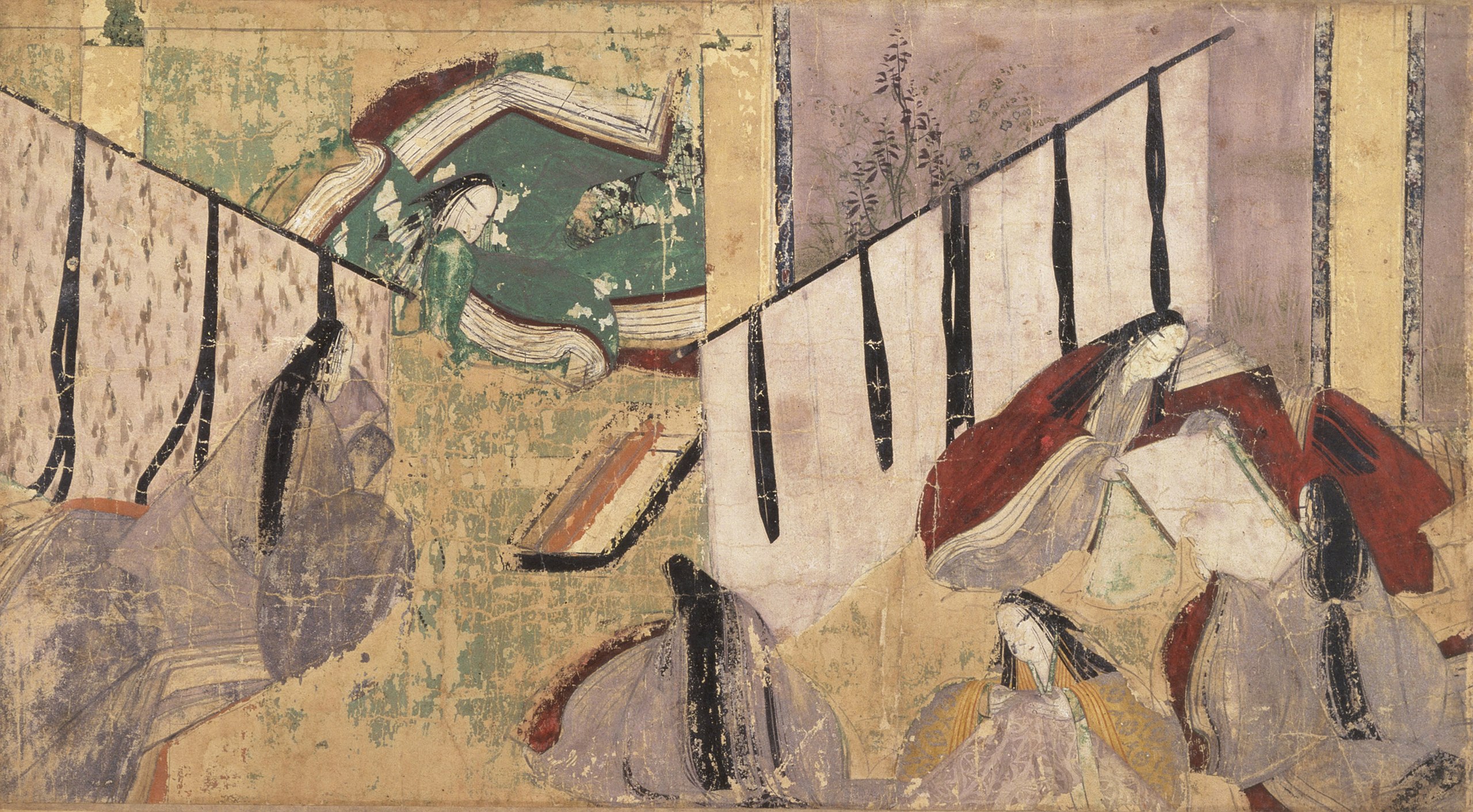
Both religious and nonreligious narrative hand scrolls flourished in the late Heian period and the Kamakura period (1185-1333), named for its capital, Kamakura. These inventive visual narratives include action tales presented in uninterrupted pictorial sequences.
A new style of painting arrived from Song and Yuan China in the late Kamakura period in the form of monochrome (single color) ink paintings. This style was brought to Japan by Chinese monks coming to work in Japanese Buddhist monasteries. In addition to ink painting, the monks introduced Song polychrome (multicolored) realistic portraits into Japan.
Monochrome ink painting dominated Japanese painting well into the 1500’s. Early Japanese monk-artists depicted the founders of their faith as well as animals and plants, such as the tiger and the orchid, which had symbolic meanings. The painters’ colleagues and friends often inscribed poems in the Chinese style on the upper part of the paintings.
Ink paintings became a truly Japanese form with the work of two monk-painters of the 1400’s—Tensho Shubun and his pupil Sesshu. After traveling to Korea in 1423, Shubun introduced a more sweeping landscape style. He painted on screens and scrolls, using ink washes and fine black lines. Sesshu traveled to China in 1467, where he came into contact with classical Ming painting. On his return in 1469, he worked in a variety of styles and techniques, a diversity shared by many later Japanese painters. Sesshu created technically superb and powerful compositions in both ink and color. After Sesshu, ink painting emerged as a nonreligious style no longer associated with the Buddhist community.
The Kano school, founded by Kano Masanobu in the late 1400’s, became one of the most powerful artistic groups in Japanese art for centuries. Kano Motonobu, his son, was the school’s principal teacher. Kano school artists painted traditional Chinese themes in a style of balanced composition and sharply defined line. Beginning in the 1500’s, Kano paintings included Japanese subjects depicted in color. Motonobu’s grandson Kano Eitoku created a new style in which he reduced forms to bold and simplified shapes that could be understood at a glance. In paintings such as Cypress, Eitoku created a new style. He departed from the previous Kano emphasis on delicate, single-colored paintings. Instead, he painted large works in a flat, bold-patterned style using gold leaf and color. He painted Cypress on the large surface of an eight-panel folding screen. His new monumental style glorified the power of his patrons, who were military warlords.
An artistically rich period emerged during the Edo era (1603-1867), named for Edo (now Tokyo), the political center of Japan. This period is also called the Tokugawa, after the name of the ruling dynasty of shoguns (warrior rulers). Artists drew on various traditions—Japanese, Chinese, and Western. This interaction of traditions gave artists access to a large artistic vocabulary. The Kano school continued to prosper as the official painters of the Tokugawa shoguns. The basic style of Edo painting came from the Kano school together with that of the Tosa school, which took its subjects and techniques from classical Yamato-e. The later Edo period also produced realistic landscapes painted in color. 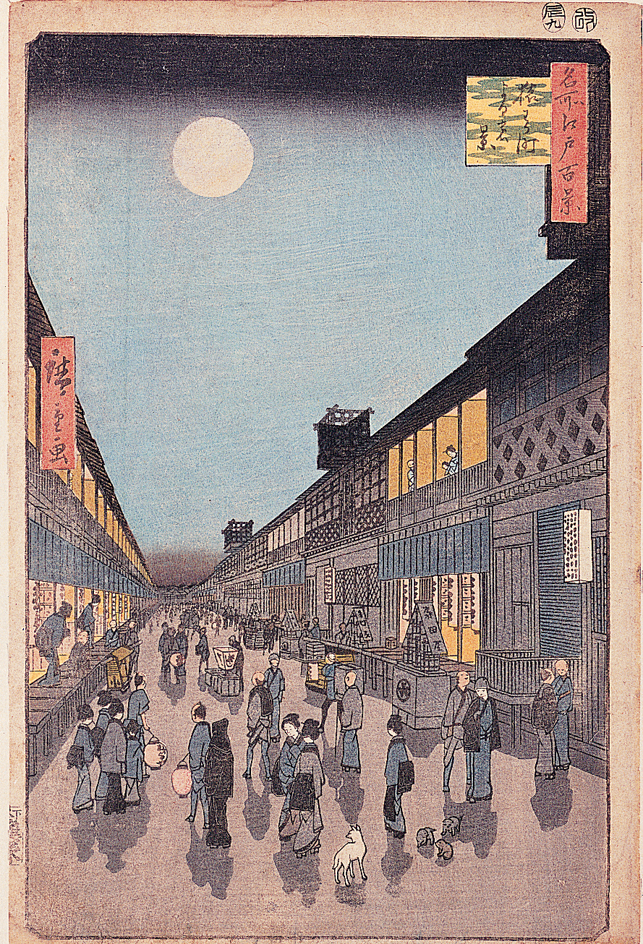
The building projects of the shoguns were important training grounds for painters and craftworkers and provided many opportunities for professional artists. Artists painted screens and other works that decorated the new buildings. The growth of castle towns enhanced patronage for regional painting styles. The aristocracy living in Kyoto was the official patron of Tosa school painting, but wealthy merchants also supported it.
In the early 1700’s, the growing middle class provided new patrons whose tastes ran from elegant and refined paintings to simple folkish art. This period is more familiar to the Western world through the multicolored woodblock prints called ukiyo-e (pictures of the floating world). Ukiyo-e depicted the theater and other urban amusements. The Japanese referred to these passing scenes of city life as the “floating world.”
Islamic painting
is art associated with the religion of Islam, first preached by Muhammad in the A.D. 600’s in what is now Saudi Arabia. Calligraphy is the supreme art in the Islamic civilization because the Islamic holy book called the Qur’ān was written in the beautiful script of the Arabic language. Muslims believed that calligraphy carries the divine message of the Qur’ān in the form of the writing as well as in the meaning of the words. 
Islamic art reflects a complex attitude toward the representation of living forms. Islam prohibits the depiction of animal and human forms in all art related to the religion. As a result, religious art often combined calligraphy with floral or geometric designs. However, Muslim princes inherited a liking for paintings of human beings and animals from the cultures that Islam had conquered. Throughout the history of Islam, privately owned nonreligious paintings include lifelike images.
The best-known Islamic paintings are book illustrations. Many of these paintings illustrate classics of the literature of Persia (now Iran), beginning in the 1200’s. One popular subject for painters was the Shah-Namah (Book of Kings). This long work was written by the poet Firdausi and completed about 1010. The Shah-Namah ranks as the national epic of Persia, consisting of episodes from Persian history mingled with myths and legends. An illustration from the epic called Bahram Gur Hunting the Wild Ass was painted by an artist in the city of Tabriz. His painting shows the exquisite drawing and jewellike color that characterizes much of Islamic painting.
Medieval painting
Historical background.
The Middle Ages began in about the A.D. 400’s, with the end of the Roman Empire in western Europe, and ended with the emergence of modern nations in the 1400’s. The Middle Ages overlapped with the early years of the Renaissance in Italy.
The end of the Roman Empire was a time of chaos and invasions. Europe became divided into small territories controlled by a military aristocracy. The economy was based on agriculture, and most people lived in self-sufficient villages. In western Europe, kings and powerful landholding nobles gave other nobles the use of land in exchange for their allegiance. Eventually, as times became more peaceful and prosperous, trade increased, craftworkers organized into guilds, and villages grew into towns.
The Christian church replaced the Roman Empire as the dominant organization in Europe. The most powerful political and religious leader in the West was the pope. The Byzantine Empire controlled much of the East, and Eastern Christians belonged to one of the Eastern Orthodox Churches. Muslims eventually controlled the Near East, north Africa, and southern Spain.
Former Roman provinces became dioceses of the church. Monasteries and convents served not only as religious institutions but also as hospitals, schools, and cultural centers. For centuries, monks and nuns created the finest medieval art and architecture.
Most people during the Middle Ages lived in relatively isolated communities. The Christian church, however, remained an international organization ruled by the pope from his headquarters in Rome. The church encouraged people to travel, either on religious pilgrimages to the shrines of saints or by joining a Crusade. The Crusades were a series of military expeditions, a number of which between 1096 and the late 1200’s were aimed at seizing and defending Jerusalem and Christian holy places in Palestine from the Muslims. Crusaders and pilgrims brought new ideas and art back with them. Medieval art reflects the contrast between regionalism, which consisted of local styles and techniques, and internationalism, which reflected a wider knowledge and view of the world.
Artists worked for the church or for royal and noble families. Most of the art made for aristocrats has been destroyed. Because art was preserved in the churches, most medieval painting that survives is religious art. Church leaders were conservative in their taste in painting. Artists were required to make good reworkings of earlier art, not create something new. Originality and individuality in art were not considered important, and few artists even signed their work. Thus, artistic change came slowly.
Medieval paintings were either small or very large. The small paintings included illuminated (decorated) manuscripts along with images of Christ and the saints known as icons. Most large paintings were murals. Painters also designed tapestries and mosaics that decorated walls.
Early Christian and Byzantine art.
In the 300’s, Christianity became the official religion of the Roman Empire. Eventually, Christianity divided into two main branches, the Western Church in Western Europe and the Eastern Orthodox Churches in the East. 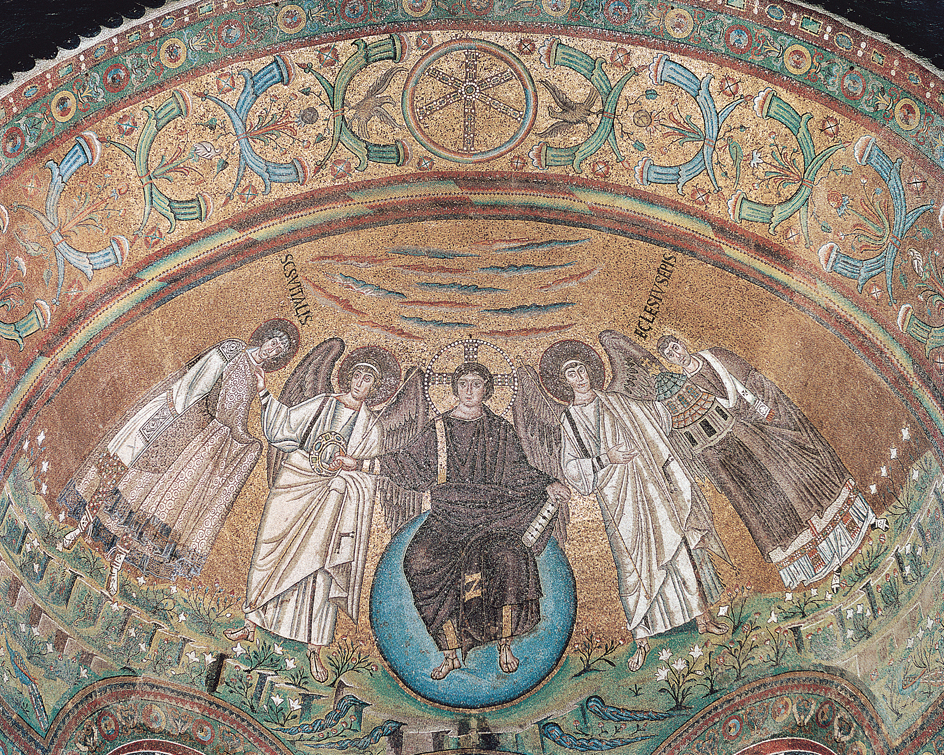
The earliest Christian art in the West can be seen in the catacombs, which were burial chambers in Rome. The early Christians painted symbols of their faith, images of Christ, and stories from the Bible on the catacomb walls. After Christianity became the official religion of the empire, Christian artists continued to decorate the walls of funeral chapels with paintings as well as mosaics.
The art made for the Eastern Orthodox Churches is called Byzantine art after Byzantium, the original Greek name of Constantinople (now Istanbul, Turkey), the capital of the Roman and then of the Byzantine empires. Byzantine artists painted murals and richly colored illuminated manuscripts as well as icons.
Worshipers were taught to venerate (show deep respect for) icons and looked at them when they prayed. The icon Virgin and Child Enthroned with Angels and Saints shows Mary holding the infant Jesus on her lap. The warriors Saint Theodore and Saint George stand guard as two angels look toward heaven. The Christ child and the angels are portrayed in an almost realistic style. The saints and the Virgin are flat and stylized. The warriors stare ahead with wide open eyes. Their bodies disappear under their patterned silk cloaks. Mary becomes a throne for her child rather than a living mother. 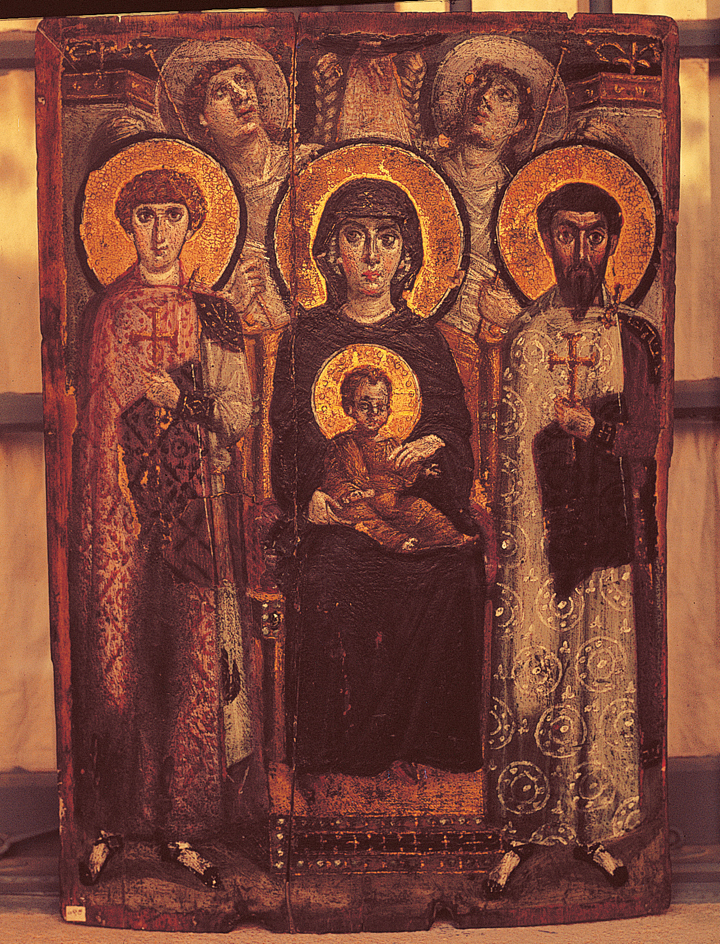
Early medieval painting in the West.
From the 300’s to the 1000’s, Western European art flourished in important and wealthy monasteries. Missionaries carried illuminated Gospels and other Christian art to new territories, spreading painting styles from place to place.
In what are now the United Kingdom and Ireland, Celtic and Anglo-Saxon monks made some of the most beautiful books ever created, notably the Book of Kells. This work is a Gospel book—that is, a book containing the four Gospels. Celtic artists decorated pages of the Book of Kells with complex combinations of letters, spirals, animals, and sometimes highly stylized human figures. The drawings are filled with bright, clear colors that make the page resemble a piece of enameled goldwork or an intricately woven carpet. 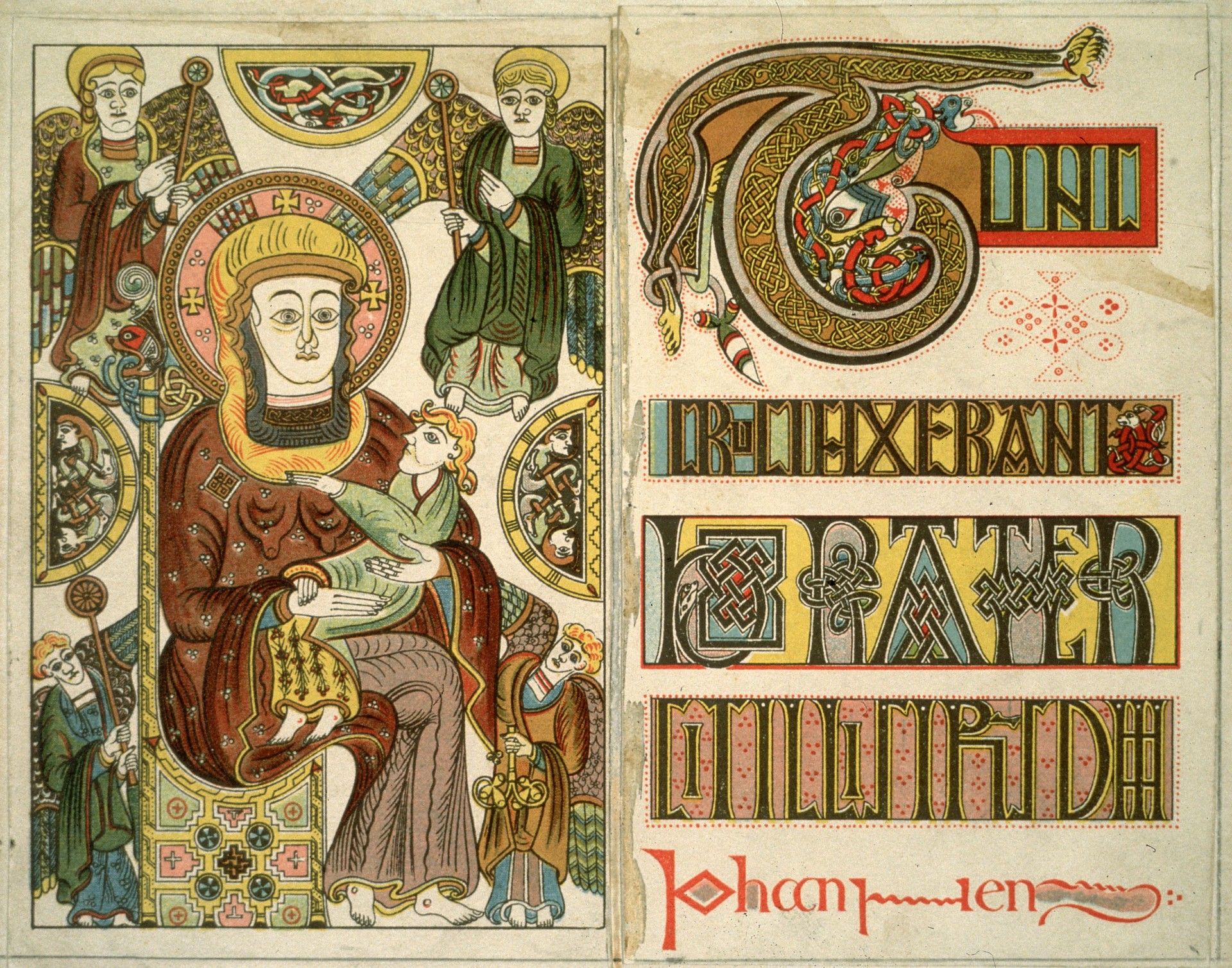
About the year 800, the great leader Charlemagne united much of Western Europe. He sponsored an educational and cultural program as well as political and economic reforms. He understood the importance of education and set up schools and scriptoria (writing rooms in monasteries) throughout his empire. The art created in Charlemagne’s empire is called Carolingian. The richness and variety of Carolingian art are reflected in the illuminated books made especially for the churches and monasteries that Charlemagne established.
An example of Carolingian illumination is the Gospel book made for Archbishop Ebbo in a monastery near Reims, France. The illumination shows Saint Matthew, one of the Gospel writers, seated on a large red cushion with his feet on a footstool. He leans on his desk as he writes with a quill pen and holds a horn filled with ink. He is inspired by an angel, who appears in the upper right corner. The landscape, Matthew’s togalike robe, and his furniture are copied from early Christian art. The artist used a fine brush to create a picture that looks almost like a pen drawing. The lines have so much energy and movement that they suggest the saint is caught up by intense religious feeling and the importance of his work. His hair is wild, and his clothes and body are twisted. Such linear energy resembles the complicated geometry of Celtic painting. See Carolingian art. 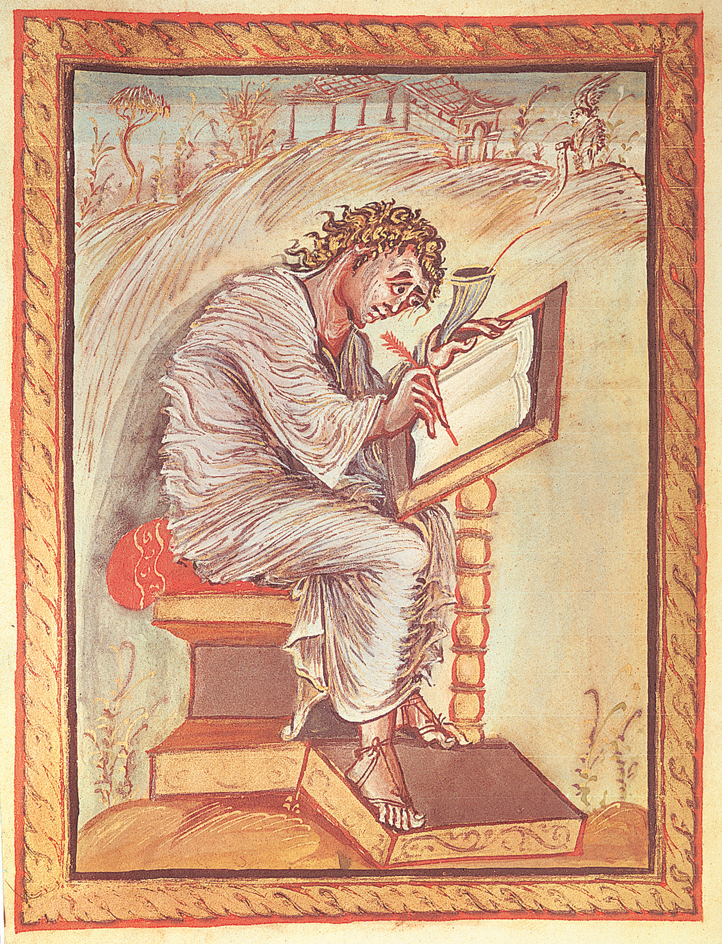
Romanesque painting
flourished in Western Europe beginning about 1050. This art is not Romanlike, as the name suggests. The name was given to the style in the 1800’s by historians who related the architecture of that period to the round arches found in Roman buildings.
During Romanesque times, wealthy monasteries became the most important patrons of the arts. Many churches were built, and old buildings were enlarged and redecorated. Mural paintings became important.
The wall behind the altar at the Church of San Clemente of Tahull in Spain was painted with a huge figure of Christ of the Apocalypse. He sits on a rainbow with His feet on the world, holding an open book inscribed “I am the light of the world.” He raises His right hand in blessing. Around Christ, fitting the curve of the wall, are the four authors of the Gospels. They hold their books and the animals that symbolize them. Paintings of the Virgin Mary and the apostles appear on the wall below Christ.
The San Clemente artists did not try to make the figures look like living people. Instead, they followed the traditional way of representing the images. The different sizes of the figures established an order in which Christ, the most important figure, is the largest. All the figures are flat and stylized. They have heavy dark outlines, simple geometric shapes, and bright colors that would be easy to see even in a dark church lit by candles.
Gothic painting.
The Gothic period lasted from about 1150 to about 1400. Kings gained greater control over lords and established more centralized nations. Cities with merchants and craft guilds became more important than agricultural villages. Universities replaced monasteries as centers of learning and culture. Professional painters and scribes, not monks and nuns, painted illuminations.
Gothic painters looked at all of the world, not just human beings. At first, they studied the details of nature, including leaves, flowers, animals, and insects. Gradually, they painted human beings acting out stories that suggest the natural world.
In the illumination Abraham and the Three Angels, the Biblical patriarch Abraham meets three young men, who are angels, under an oak tree. He invites them home and gives them food. The painting shows Abraham and the angels twice. First, they meet on the left side of the painting. Then, on the right, Abraham kneels in front of the table as his wife, Sarah, stands in the doorway of their home. To Christians, the three angels symbolized the Trinity as well as the Biblical story of Abraham and Sarah’s generosity. 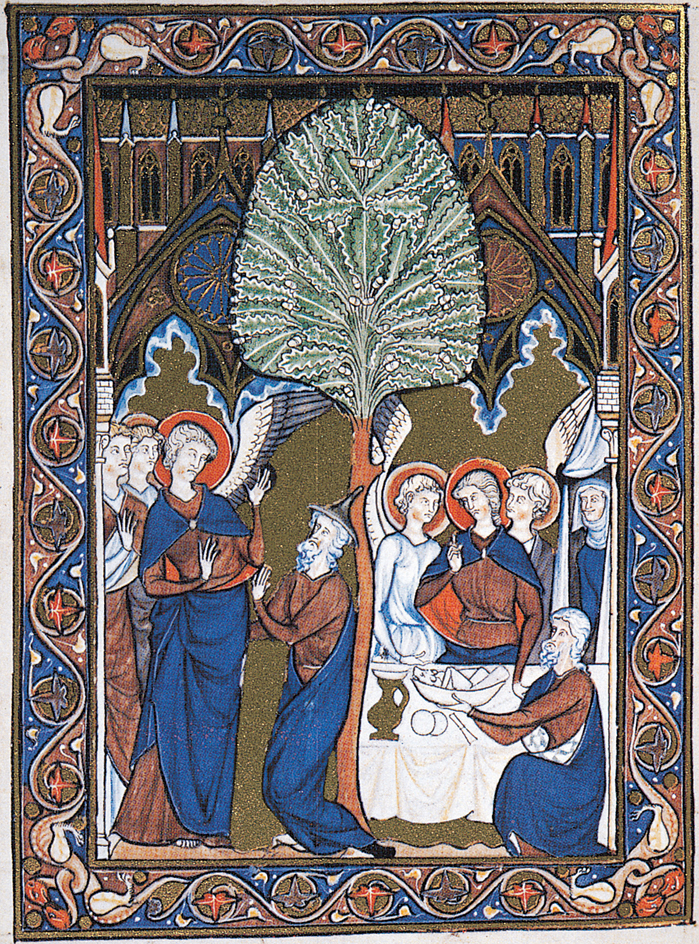
The figures in the illumination look more like real people than Romanesque figures, but they are still stylized. The figures are tall and slender and stand in elegant poses. Their faces are idealized. Although they gesture vigorously, their graceful bodies seem to disappear under the elegant drapery patterns. Their long fingers seem too delicate to grasp anything, and the figures appear to take up no space against the gold background. Even the table with the dishes and food becomes a flat pattern. Yet the artist has begun to look at the world around him. The oak tree has an important position in the center of the painting, and its leaves and acorns are carefully shown. The architecture that frames the scenes is copied from a real building, La Sainte Chapelle in Paris.
Some Gothic artists painted on a large scale, making pictures called cartoons for weavers to copy for tapestries that covered church and castle walls. Artists also painted huge stained glass windows.
Especially beautiful illuminated books were created in the late 1300’s and early 1400’s for the Duc de Berry, a brother of the French king, Charles V. The duke collected manuscripts and employed a number of painters, the most famous being the three Limbourg brothers, Pol, Herman, and Jean.
The Renaissance
The Renaissance was a great cultural movement that began in Italy in the early 1300’s and spread to other European countries. The word Renaissance comes from a Latin word meaning rebirth. What was actually reborn during the Renaissance was an interest in classical antiquity, the culture of ancient Greece and Rome.
The 1300’s.
By the 1300’s, such Italian writers as Giovanni Boccaccio, Dante Alighieri, and Petrarch were studying Roman literature and the world around them. They began a movement called humanism, which stresses the importance of human beings (see Humanism). Humanism had a profound influence on painting. Painters began to look with new interest at the art of ancient Greece and Rome and at their fellow human beings.
The change from medieval to Renaissance painting can be traced in the styles of Giovanni Cimabue and his pupil Giotto. A comparison of Cimabue’s Madonna Enthroned with Angels with Giotto’s Madonna Enthroned with Saints shows the difference between Cimabue’s late medieval style and Giotto’s style, which was a forerunner of Renaissance painting.
Cimabue’s painting achieves an otherworldly appearance. The artist placed an abstract network of gold lines on the Madonna. The lines seem to make the figure flatter and almost transparent, as if the gold were shining through her. Giotto’s composition occupies a more natural physical space. He used white highlights on Mary’s lap and chest to suggest physical bulk and presence. Giotto’s concern with solid forms and real space demonstrates an interest in the natural world that was strikingly different from the formulas of medieval painting. 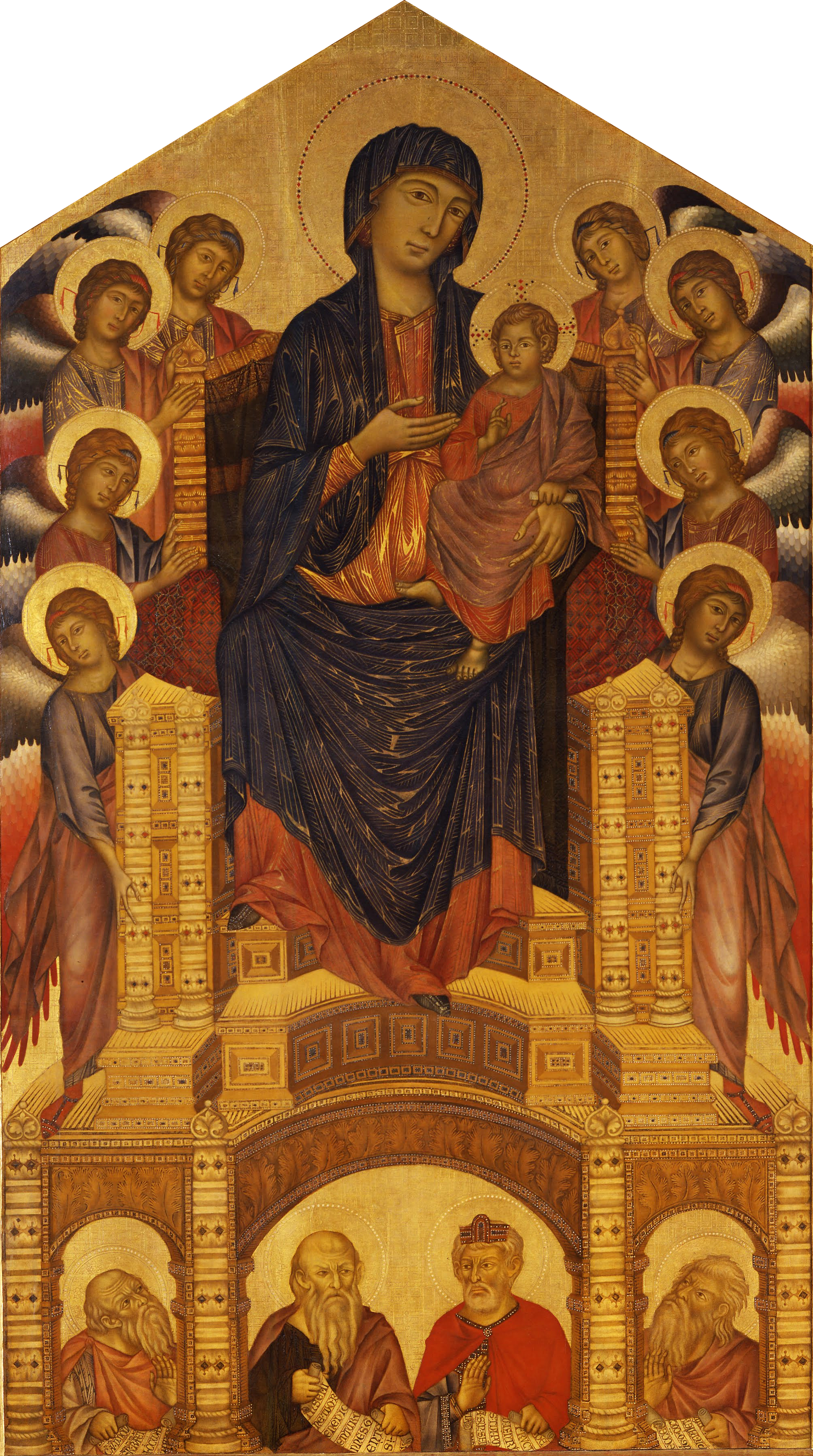
Giotto was one of the most remarkable painters in art history. Giotto’s subjects were Biblical stories and the lives of saints, but he was interested in how people looked and acted. His work indicated a change from symbolic art of the Middle Ages, which concentrated on religious ideas, to the more humanistic art of the Renaissance.
As Giotto studied people, he copied their gestures and expressions in paintings like Joachim with the Shepherds. The scene is also known as Joachim Takes Refuge in the Wilderness. Joachim is downcast because he and his wife, Saint Anne, have no children. The shepherds seem worried and curious. A dog jumps up to greet a stranger, an angel who will announce to Joachim that his wife will become the mother of the Virgin Mary. Giotto painted the shepherds’ hut and the rocks and trees of the landscape in three-dimensional forms, not the flat medieval style. He even painted blue sky instead of the gold background that Gothic painters used. Giotto emphasized the human characteristics of his figures, portraying the weight of their bodies under heavy drapery by modeling in light and shade. 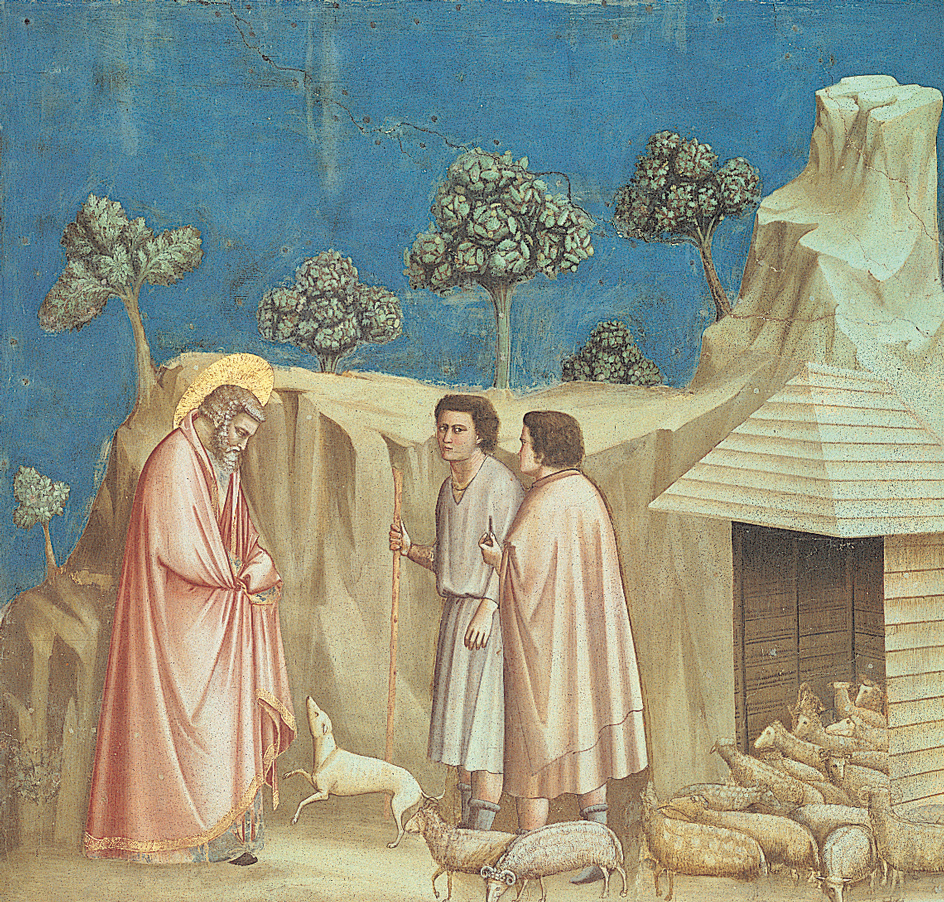
As artists became more highly trained in painting techniques and the ideas of humanism, they altered their styles. There was a greater demand for realistic images. Artists made discoveries that led to new ways of portraying the human form, pictorial space, color, gestures, and the placement of figures. For example, Renaissance painters rediscovered the rules of linear perspective, a mathematical system for showing depth on a flat surface. The technique had been largely abandoned during the Middle Ages. 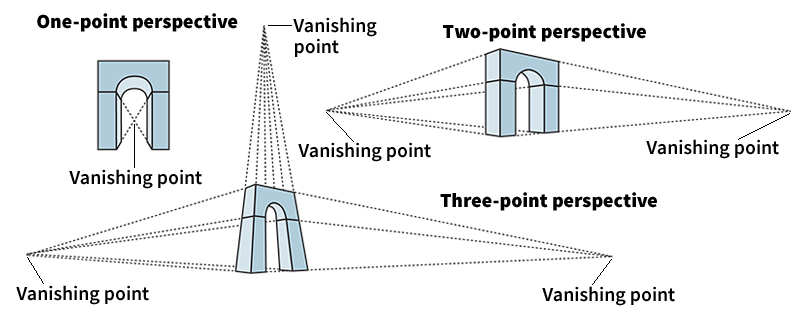
The center of early Renaissance painting was the city of Florence. In 1348, a terrible outbreak of plague called the Black Death killed many Florentines. Only a few artists in the city survived. The destruction caused by the plague reduced interest in the arts and inhibited developments in painting initiated by Giotto. As a result, further developments in Renaissance painting did not occur until the 1400’s.
The 1400’s
in Renaissance art history are sometimes called the Quattrocento, an Italian word that means four hundred. This century was a period of intense political, economic, military, religious, and artistic activity.
An early masterpiece of the Quattrocento is Masaccio’s The Tribute Money, a fresco painted in a church in Florence. In the painting, Masaccio demonstrated many of the stylistic innovations that characterized Renaissance painting. These innovations included linear perspective, anatomical accuracy, and evenly spaced figures. 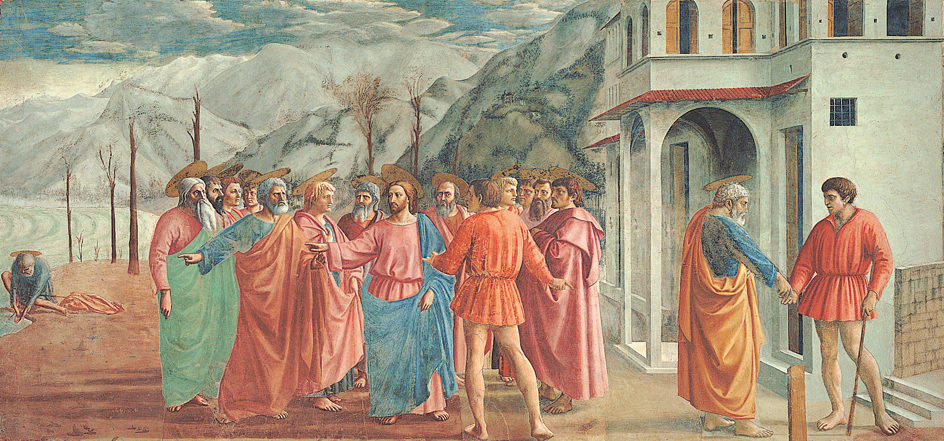
Masaccio’s fresco tells a story from the Bible. Jesus and His disciples have gathered near a town controlled by the Romans. A Roman official demands that the group pay the tax necessary to enter the town. Although the disciples protest, Jesus orders Peter to look in the mouth of a fish, on the left, where the disciple finds the money to pay the tax collector, on the right. The perspective establishes a horizon line at about the level of the heads of the grouped figures, with Jesus in the middle. The poses of the bodies follow the laws governing human anatomy, and the gestures are simple and clear.
Fra Angelico worked about the same time as Masaccio, but in a simpler style, as in his fresco The Annunciation, painted in a convent in Florence. Fra Angelico understood perspective and used it in his painting, but he did not follow Masaccio’s interest in anatomical accuracy and forceful gestures. The Madonna sits modestly as she hears the Angel Gabriel announce that she will become the mother of Jesus. Gabriel kneels in a position that shows great respect. The angel appears quiet and devoted, and his clothing falls in neat, simple folds. 
In northern Italy, Andrea Mantegna produced masterworks of Renaissance art. Mantegna learned much from the Renaissance sculptor Donatello, who revived classical ideas of physical beauty by sculpting the first large nude figures since ancient times. Mantegna also studied the ancient ruins of Italy. In Saint Sebastian, Mantegna revealed his interest in anatomy, the ideal figure, and antiquity. Sebastian was an early Christian saint. After the Romans discovered he was a member of the outlawed Christian faith, they shot him with arrows. Mantegna may have chosen Sebastian as a subject because it gave him the opportunity to portray an ideal human figure bound to a classical ruined arch. The painting’s realistic anatomical detail and the heroic character of Saint Sebastian make it typical of the interest in nature and humanism popular in Italy.
Sandro Botticelli absorbed the technical accomplishments of earlier Renaissance artists and added a personal poetic style. Botticelli cared less about realism than he did about decorative effects. His Birth of Venus shows Venus, the Roman goddess of love and beauty. She has just arrived on shore, blown there by gods of the wind called Zephyrs, on the left. Venus is attended by another mythological deity called an Hour, on the right, who is about to cloak Venus’s naked beauty. The painting has a fine delicacy created by the emphasis on V-shaped waves and flowing clothing and hair. The figure of Venus stands in a curved, almost unnatural pose. The result is a painting less realistic than was common for the period. 
In contrast to Botticelli, Leonardo da Vinci almost never experimented with decorative or ornamental effects. Instead, he concentrated on what he thought was a scientific and rational approach to art. At the same time, he was interested in conveying feelings with his art.
Leonardo’s Madonna of the Rocks represents Jesus and John the Baptist as infants, the Virgin Mary, and an angel in a dark landscape. Leonardo’s understanding of the human body and his interest in new lighting effects appear in the painting. Unlike Masaccio and Mantegna, Leonardo did not put his figures in a clear atmosphere so the viewer could see all the details of the human forms. Instead, he blurred and darkened his outlines with shades of color in a technique called sfumato (smoky). The sfumato submerges the figures and landscape in shadows that help create a peaceful mood. The dusky light reveals the protectiveness of Mary, the sweetness of the children, and the gentle gracefulness of the pointing angel. The arrangement of the figures in a pyramid is typical of many Renaissance paintings and adds to the painting’s sense of stability and calm. 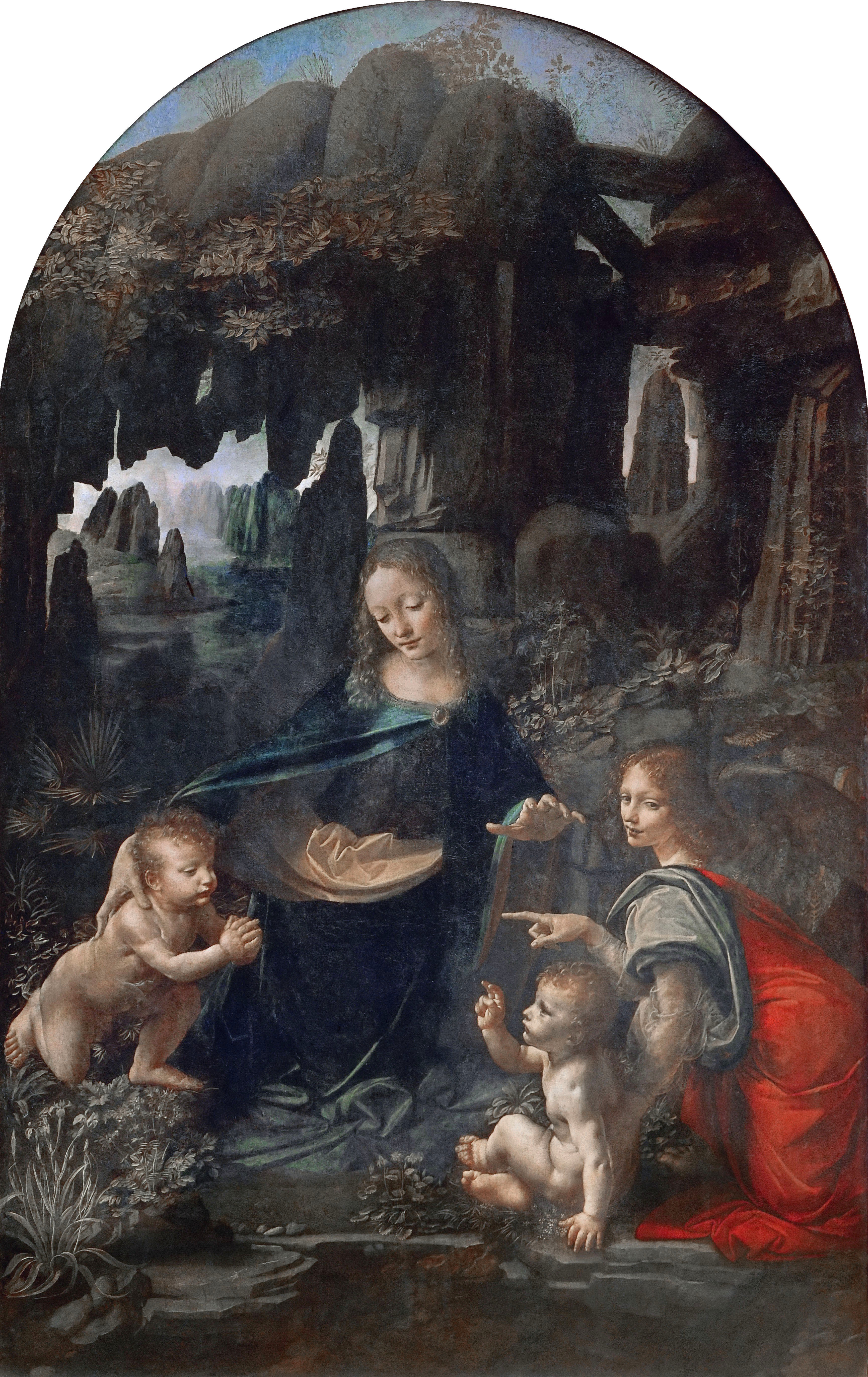
The High Renaissance
is the term given to the years from about 1500 to 1525 in Italian painting. This period reached its peak through the powerful patronage of Pope Julius II and the work of such artists as Michelangelo and Raphael.
Painters of the High Renaissance continued and even emphasized elements of earlier Renaissance art. These elements included the realistic treatment of space, an understanding of the human body, the clear use of colors, and formal compositions. But differences did emerge. Figures in High Renaissance paintings have a strong presence not often seen earlier. Figures portrayed as stiff and immobile in the works of the 1400’s were shown twisting and spiraling in space. Artists stressed anatomy. Gestures became broader, and facial expressions stronger and more commanding. Compositions that had been shallow grew deeper, and painters tried to make the space more convincing.
Michelangelo.
Among the early masterpieces of the High Renaissance were Michelangelo’s frescoes for the Sistine Chapel commissioned by Pope Julius II. The chapel is next to St. Peter’s Basilica in Rome. The pope considers the Sistine Chapel his own private chapel. In addition, the Sacred College of Cardinals meets there to elect new popes. Michelangelo worked over a period of about four years on the ceiling frescoes. He chose scenes from the Book of Genesis that illustrate events from the Creation to Noah and the Flood. 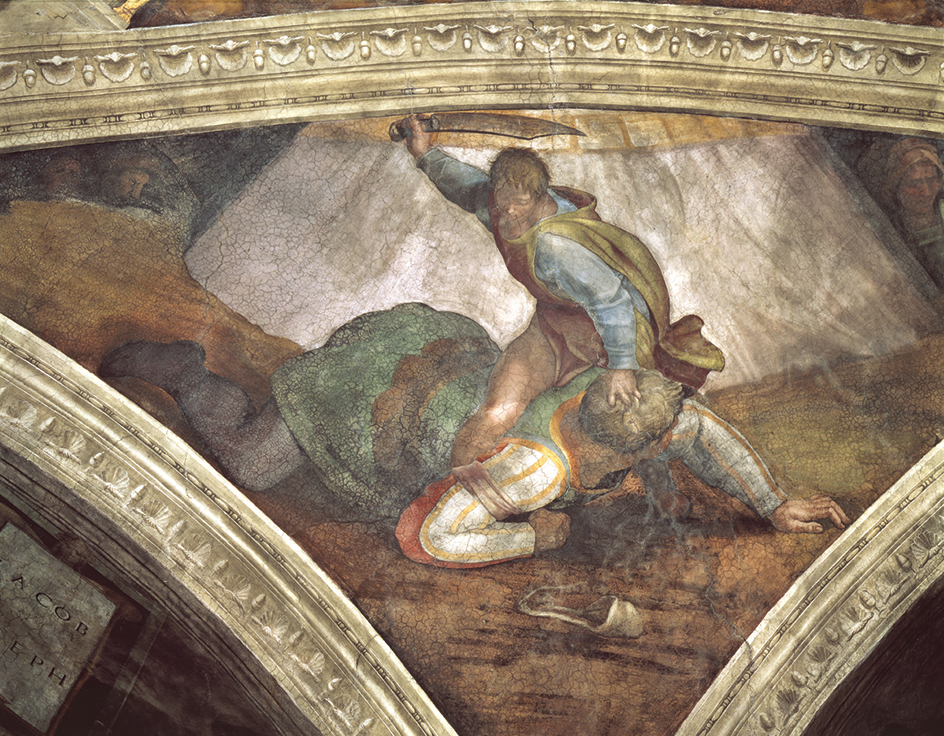
Michelangelo’s fresco The Creation of Adam from the chapel ceiling is characteristic of Renaissance humanist attitudes. In the painting, God, portrayed as an elderly man, hurtles with great force and speed toward the passive, awakening Adam. Adam is already alive, even before God touches his finger. The creation about to occur may be the birth of human potential, the enabling of Adam to choose whether to ascend to greatness or decline into sin.
Michelangelo’s figures are strongly three-dimensional, well muscled, and anatomically accurate. Adam is already physically perfect, an ideal male nude. Michelangelo’s powerful rendering of the human form enhances a quality called terribilita (awesomeness), for which the artist became noted. The “awesomeness” refers to the barely contained energy of the figures.
Raphael.
While Michelangelo was working on the Sistine Chapel, Raphael was painting the School of Athens in a nearby room in the Vatican. Many historians see the School of Athens painting as the fundamental expression of the High Renaissance. It shows the ancient Greek philosophers Plato and Aristotle acting out their individual philosophies. Plato, pointing upward, represents the tradition of philosophy concerned more with ideas than with particulars, which finds its truth descending from above. Aristotle gestures outward to indicate his reliance upon evidence that can be found in the real world. Arranged near Aristotle are the scientists and mathematicians of earlier ages. To Plato’s right are philosophers, who draw conclusions from logical assumptions and pure reason rather than actual experience. 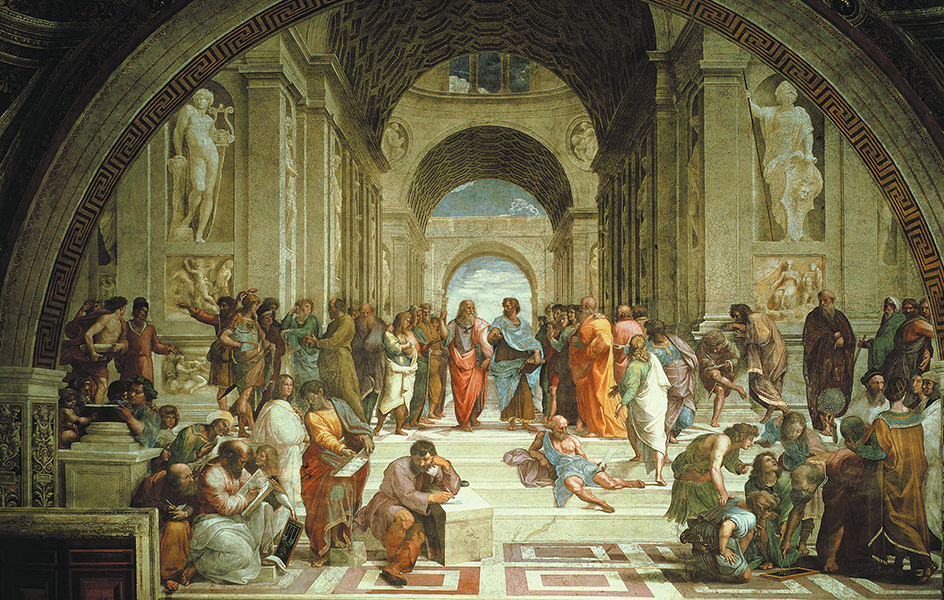
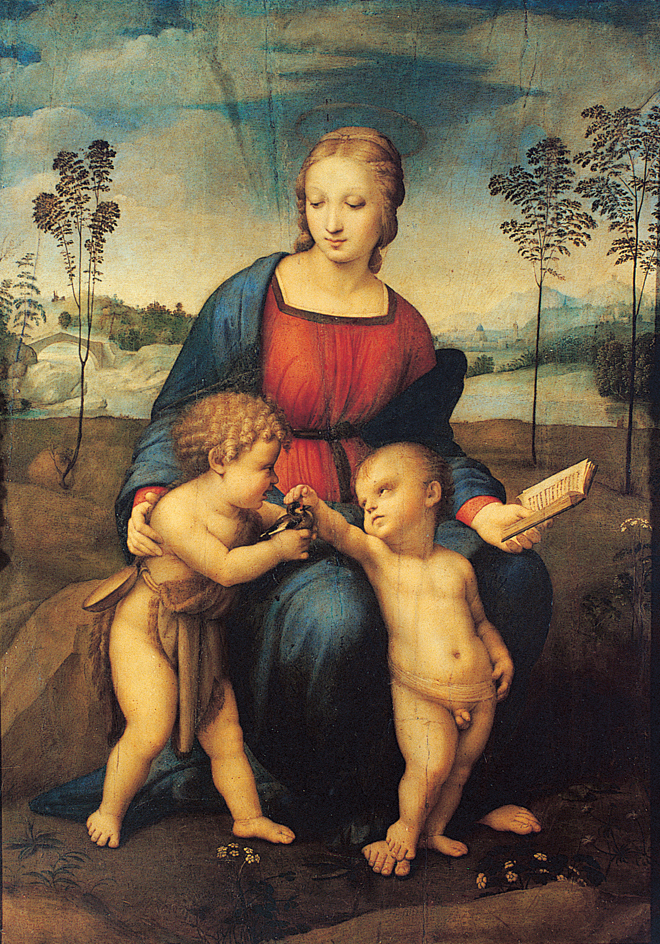
Raphael arranged the figures in the School of Athens in a deep circle. The lighting is clear and even. The space is generous and rational. The figures are evenly spaced. Everything is calm, centered, logical, and visually understandable.
Raphael achieved a more intimate grace with his Madonna of the Goldfinch. Mary sits calmly with the Christ child and His cousin John the Baptist. Raphael placed this tranquil family in a peaceful landscape of clearly outlined forms that represents the Renaissance ideal of harmony and balance.
The Renaissance in Venice.
The Renaissance painters of Rome and Florence were concerned with telling stories and portraying religious scenes. The painters of Venice stressed a poetic mood and the mystery of nature. Giorgione’s The Tempest depicts a dramatic landscape. In The Tempest, the colors of the vegetation are rich and deeply green. A storm dominates the center of the composition. Historians do not agree on the meaning of this painting. It may simply be an expressive scene of a young woman nursing a child while a man stands nearby.
Sebastiano del Piombo was a Venetian painter whose early works were strongly influenced by Giorgione’s style. However, Sebastiano gained his greatest fame after moving to Rome in 1511. The finest paintings of his Roman years are portraits, notably Portrait of Pope Clement VII. Sebastiano painted the pope as a man of grave and compassionate appearance and character. The pope, a member of the powerful Medici family in Florence, was a patron of such artists as Michelangelo and Raphael.
Venetian artists loved color. Titian’s Crowning with Thorns shows a traditional religious scene, Jesus being tormented by Roman soldiers as they push a crown of thorns on His head with long poles. Titian’s painting is troubling and emotional. The scene portrays great suffering and passion. Titian evoked emotion by setting the figures in a darkly lit passage. He painted the figures loosely, brushing on bold strokes of color, so the figures have an incomplete, nightmarish quality. By blurring the edges and using rich, dark colors, the artist created a vague and threatening feeling.
Paolo Veronese used the coloristic tradition of Venice to paint scenes of spectacular beauty. His enormous painting Feast in the House of Levi was originally condemned by church officials who thought it was a painting of the Last Supper. The officials complained about the presence of “buffoons, drunkards, dwarfs, Germans, and similar vulgarities” at the final meal shared by Christ and His disciples. Veronese then changed the painting’s title to reflect an episode in which Jesus brought His message to sinners. Whatever the actual subject of the work, it portrays an exuberant, festive joy of life. The setting is magnificent, the scale huge, and the background typical of Venice in the 1500’s. All the figures, including the dog and cat, enhance the atmosphere of color and delight.
Mannerism
is the name given to a new style that emerged about 1520 in central Italy. The term Mannerism comes from an Italian word that means style or manner. Mannerist painters directly flouted Renaissance principles of rule, order, and design. Instead of harmony, the Mannerists sought strain and discord. They created puzzling variations in scale and space, and emphasized unbalanced compositions and harsh colors.
By challenging artistic tradition, Mannerism may have represented some crisis of the time, such as a loss of faith in traditional values. However, it seems more likely that the Mannerists were interested primarily in experimenting with style and inventing something new in painting.
Mannerism came to Venice late in the 1500’s in the art of Tintoretto. His bold and dramatic Last Supper contrasts with most previous versions of this scene. In the upper room of a Jerusalem inn, Jesus meets for the last time with His disciples and tells them of His coming betrayal and death. Tintoretto placed the supper table on a diagonal, drawing the viewer backward into deep space. The light illuminates individual heads but creates no general clarity. Phantom angels sweep into the room and circle about the lantern suspended from the ceiling. 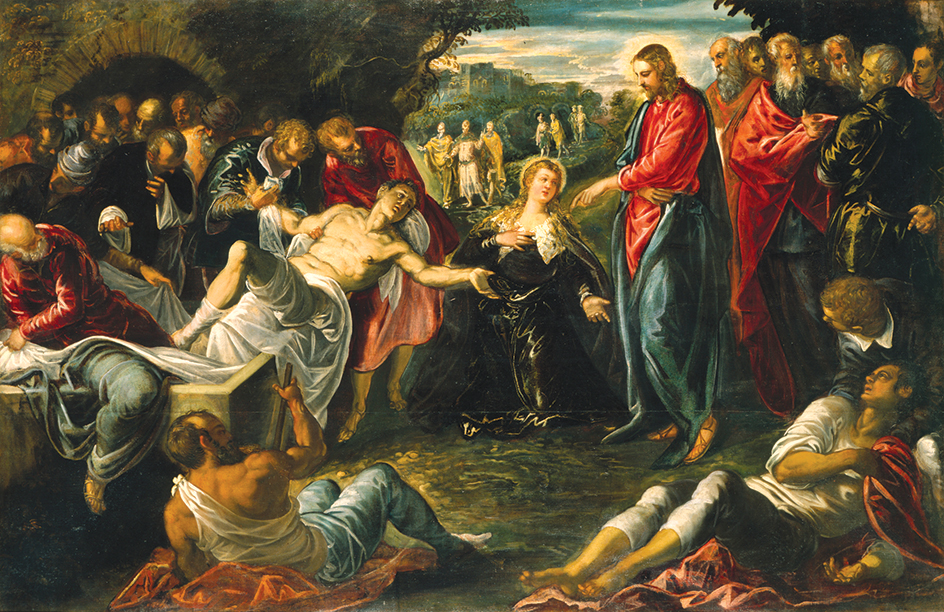
Like Veronese, Tintoretto included a number of details, such as the cat sticking its head into a basket of dishes. However, the overall effect is threatening. The exaggeration of space, the distortion of lighting effects, and the excitement of some of the gestures mark this painting as a late Mannerist work. It also has many stylistic characteristics associated with the next age of European painting, the Baroque.
The northern Renaissance.
Italy was the home of the Renaissance, primarily because so much classical tradition of ancient Greece and Rome survived there. But northern Europe also produced a rich and fascinating art during the 1400’s and 1500’s. The center of this culture was an area in northern Europe called Flanders, which lies primarily in modern France and Belgium. Germany also produced great Renaissance painting.
People from Flanders were called Flemish. The Flemish painters cared less than the Italians about a mathematically accurate technique for perspective or a classical sense of the human form. Instead, they concentrated on building their paintings through precise details and a sense of the light falling across the picture.
The Flemish artist Jan van Eyck painted The Annunciation, a work with a vast variety of detail and symbolic meaning. Van Eyck was among the first European artists to work entirely in oil paint. The technique lent itself to painting highly detailed images. The precision of detail appears in the glass windows as well as in the floor patterns. Van Eyck represented every strand of the brocade on the Angel Gabriel’s cloak. The light coming through the windows behind Mary has been observed so carefully that the individual panes of the window all differ from one another.
For van Eyck, the entire range of details and colors in the visible world was significant. An Italian artist would suppress “unnecessary” details, but van Eyck attempted to capture all the particulars of a scene. These details express meanings. For example, the single top window suggests the single God of the Old Testament. The three windows below symbolize the Holy Trinity of the New Testament.
The most prominent in the next generation of Flemish painters in the 1400’s was Rogier van der Weyden. While van Eyck was objective, van der Weyden was deeply subjective. His The Descent from the Cross pushes the figures close to the viewer. The figures, nearly life-sized, produce an eerie effect because they look like painted statues in a wooden box. Emotions range from grim despair to heartbreaking anguish. Tears roll down Mary’s face as she faints in sympathy with her Son’s suffering. 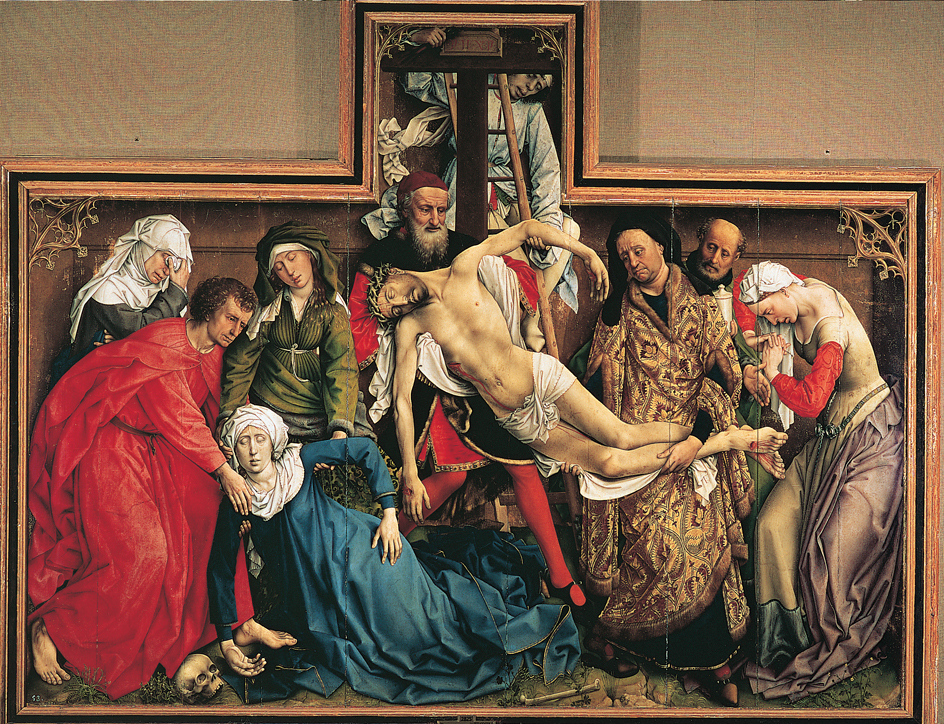
Both van Eyck and van der Weyden remained largely free of the influence of Italian art. However, by the 1500’s, the Italian Renaissance style had spread throughout Europe. One Flemish artist of the 1500’s stood apart from the prevailing Renaissance styles and worked in an individual manner. Pieter Bruegel the Elder produced no school or following, other than the art of his own children. His reputation ranks high today, but for many years after his death in 1569, he was often considered as simply a painter who poked fun at the peasants of his day. However, modern historians generally see a more serious, almost philosophical side to Bruegel’s art.
In his Landscape with the Fall of Icarus, Bruegel portrayed the Greek myth of young Icarus. The boy’s father, Daedalus, fashioned wings for his young son from bird feathers and wax. Daedalus warned Icarus not to fly too close to the heat of the sun. The boy ignored the warning and flew so near the sun that the wax in the wings melted. Thus, as a consequence of his pride and foolhardiness, Icarus plunged to his death in the sea.
Bruegel’s figures are relatively simple and round. He painted his landscape viewed from above, and his perspective is difficult to analyze. Bruegel saw the story as if it were occurring off the coast of Flanders, while a typical Flemish peasant plows his land. Nearby a ship sails. Two legs sticking out of the green water at the lower right provide the only evidence of Icarus’s death. The drowning seems almost insignificant in the larger scheme of things. In the humanistic tradition of Italian art, the central event in a story almost always was placed at the center. But in Bruegel’s painting, greater forces seem at work. Human beings, despite their pride, play only a small part in the world.
Albrecht Dürer
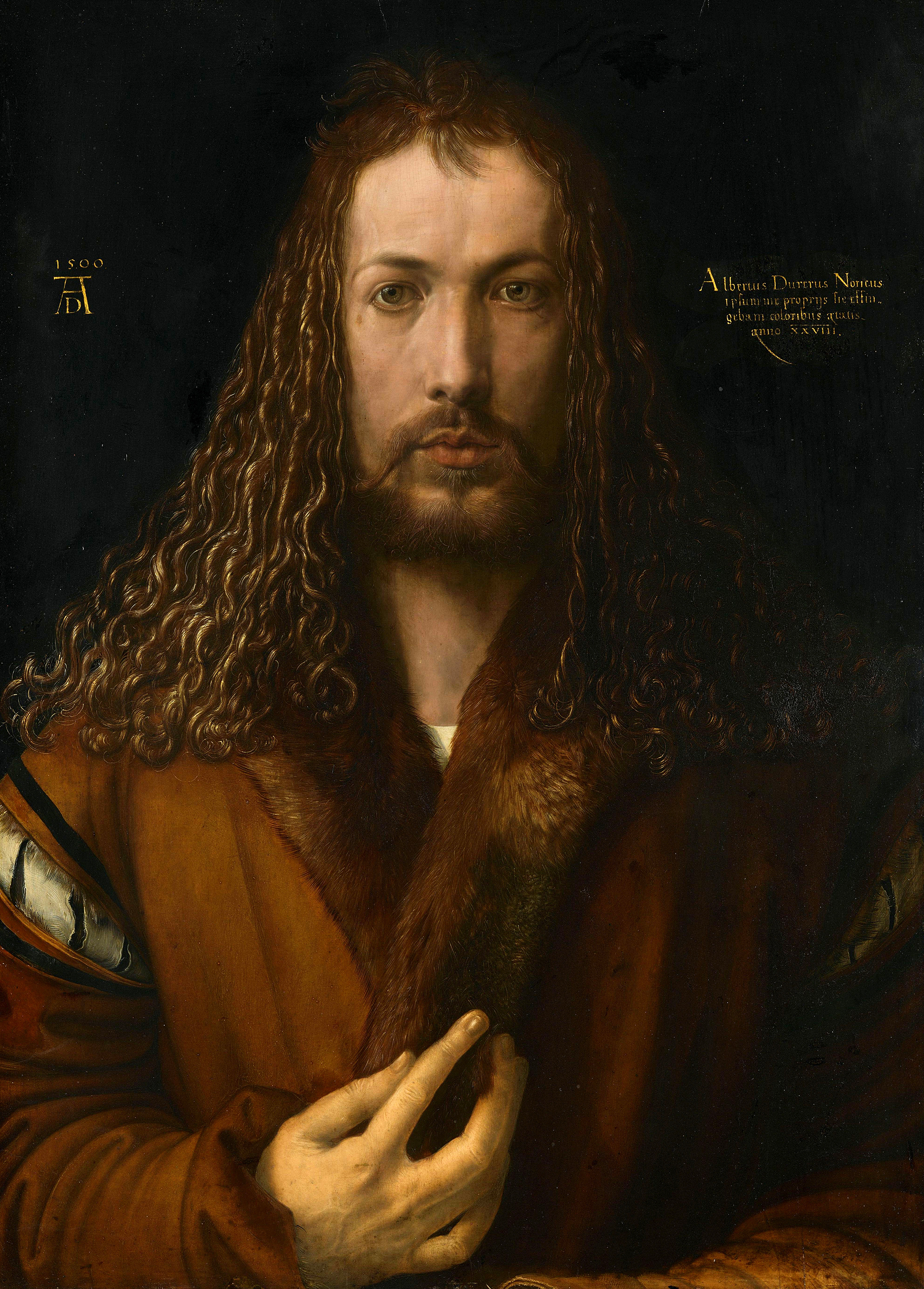
In the art of the 1500’s, the portrait was a document that recorded the social position, class, occupation, or other significant aspect of the sitter. In Dürer’s Self-Portrait, the artist made himself look like Jesus Christ. Dürer showed himself formally from the front. The portrait depicts a Christlike image, with wide staring eyes and long hair and beard. In this self-portrait, Dürer compared artistic ability with the creative power of Christ. The painting reflects the Renaissance idea of the artist as a genius. See also Dürer, Albrecht.
The 1600’s and 1700’s
Baroque
is a term that originally described art that developed in Italy about 1600. The movement lasted until about 1750 in areas of Germany and Austria. The term was first used in an unfavorable way to describe the showy, extravagant art that followed the High Renaissance. However, the term lost its negative meaning and now refers loosely to all European art and architecture of the 1600’s.
Applied to painting, Baroque refers to the works of a varied group of artists in Western Europe. The works of these artists reveal distinctive national styles. These styles were supported by the Roman Catholic Church in Italy and Flanders, monarchies in France and Spain, and the powerful middle class in the Netherlands.
Despite the distinctive stylistic characteristics associated with each country, some unifying features exist in Baroque painting. In general, Baroque artists painted large-scale works of dynamic subjects that are realistic and emotionally intense. Artists expressed these qualities through active figures arranged diagonally within the composition. Strong colors and sharp contrasts of light and shadow heighten the theatrical presentation of the subject matter.
Baroque painting began in Roman Catholic countries where the church was confronting the effects of the Reformation. The Reformation was a religious movement that led to the establishment of Protestant churches. The Reformation prompted the Catholic Church to seek new ways to reach the faithful through art. In Catholic Italy and Flanders, artists produced works that taught religious doctrine in an easily understood fashion. Magnificent altarpieces proclaimed church beliefs clearly and directly. These two qualities are evident in the paintings of the foremost Italian Baroque artist, Michelangelo Merisi da Caravaggio.
Caravaggio.
Baroque characteristics that visually promote and defend the Roman Catholic faith appear in Caravaggio’s Conversion of Saint Paul. The painting portrays the moment when Saul falls from his horse, converts to Christianity, and adopts his new name, Paul. The startling event occurs in the foreground of the pictorial space. Caravaggio intensified the drama by using abrupt contrasts of light and shadow, called tenebrism. The unidealized presentation of Paul, his attendant, and the horse spoke directly to the faithful. They would respond instinctively to the natural, convincing conversion of a sinner into a saint. Some artists and patrons of the time considered the realistic portrayal of such religious themes too natural. Church patrons rejected Caravaggio’s altarpieces as vulgar and unsuited to a religious environment.
Caravaggio worked alla prima—that is, he painted directly onto the primed canvas in one layer, without preparatory painting underneath. His spontaneous method of creating his compositions differs from the deliberate approach of High Renaissance artists.
Artemisia Gentileschi
was an Italian painter who became one of the most influential followers of the style of Caravaggio. She employed realism and contrasts of light and shadow called chiaroscuro to portray powerful, determined heroines, especially from the Bible.
The Carracci family
revived the Renaissance tradition of painting based on life drawings, sketches of nature, and models from antiquity. The three Carracci were Lodovico, the eldest, and his cousins, the brothers Agostino and Annibale. In 1585, they established an academy of art in Bologna, Italy. The conservative teachings of the school’s leader, Annibale, continued the traditional style of the Italian Renaissance and offered an alternative to the radical art of Caravaggio. Annibale painted murals illustrating the classical approach to art by presenting a theme in a rational, controlled composition.
Peter Paul Rubens.
The conflicting directions in Italian Baroque painting merge in the work of the Flemish artist Peter Paul Rubens. Although he lived in Flanders, Rubens obtained many commissions from both public and private patrons throughout Europe. His popular paintings incorporate a balance of traditional classical idealism with the dramatic realism of his time. 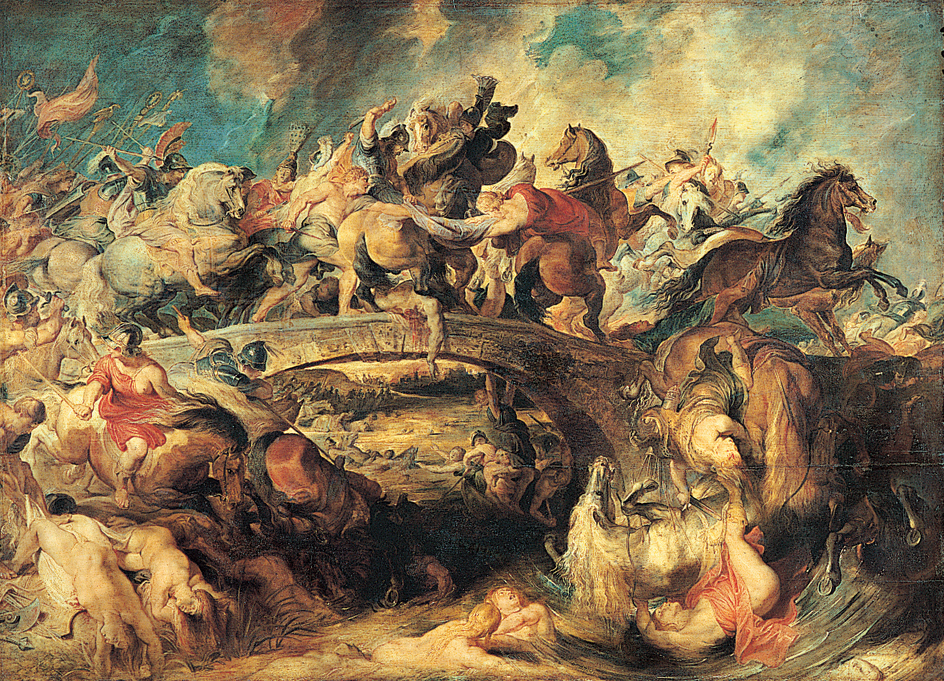
In Rubens’s Battle of the Amazons, the idealized nude figures are classical in origin, while the composition exhibits the active elements of Caravaggio’s style. Like Caravaggio, Rubens conveyed the drama of the scene by placing moving figures diagonally throughout the composition and incorporating strongly contrasting areas of light and shadow. Rubens also applied vivid, rich colors inspired by his study of Venetian painting. He painted broken, agitated brushstrokes, emphasizing the energy of the battle. In his choice of subject matter, Rubens shared with Caravaggio an interest in showing the climax of the story. Baroque painters tried to stimulate viewers by portraying dramatic, exciting action.
Sir Anthony Van Dyck.
Rubens operated a large studio in Antwerp and directed a crowd of apprentices and assistants. Among the talented young artists who worked at his studio was Anthony Van Dyck. Van Dyck had already become an accomplished painter when he joined Rubens in 1618 and began producing classical and religious works in imitation of his master. However, Van Dyck wanted to avoid competing with Rubens in the area of history painting, so he turned to painting portraits. Van Dyck moved to Italy in 1621 and dedicated himself to the perfection of court portraiture.
Following a brief return to Antwerp, Van Dyck moved to England in 1632, where he worked for King Charles I in London. Van Dyck established the characteristics of refined court portraiture by stressing the elegance and splendor of the royal family. In Van Dyck’s paintings, figures wear lavish costumes and are surrounded by the marks of power and luxury.

Classicism.
The Roman Catholic Church established the dramatic Baroque style in public religious art. In contrast, many private patrons and scholars in Italy and France preferred works that exhibited a balanced, orderly presentation of classical and religious themes. King Louis XIV of France officially embraced this style, known as Classicism. It became officially approved and encouraged with the establishment of the French Royal Academy of Painting and Sculpture in 1648. Two French artists, Nicolas Poussin and Claude, developed and popularized Classicism both in France and in Italy, where they lived and worked.
Poussin differed considerably from the Baroque master Caravaggio in his choice of subject matter and style. Caravaggio’s dramatic paintings appealed immediately to the viewer’s emotions. The composed art of Poussin spoke to the mind and required an intellectual response. Poussin believed the only suitable subjects for art were serious, uplifting stories from classical mythology, ancient history, and Christianity.
Poussin read extensively about his subject matter and then considered how best to tell the story through a painting. He proceeded methodically by carefully preparing sketches and elaborately arranging small wax figures to determine the composition.
Poussin’s formal Classicism appears in scenes from antiquity as well as in Christian subject matter. In his Holy Family on the Steps, Poussin organized the figures in a triangular arrangement on a stairway. The balanced effect of this composition emphasizes the calm, dignified content of the painting.
Poussin and Claude also stimulated an interest in landscape. The classical French presentation of nature is evident in Claude’s The Father of Psyche Sacrificing at the Temple of Apollo. The landscape overwhelms the small, unimportant figures in the foreground and points to the establishment of pure landscape as an acceptable subject for painters. The natural lighting and atmospheric conditions in Claude’s landscape paintings are partly based on nature studies in the Italian countryside. However, Claude carefully planned the composition. He refined any imperfections or irregularities in the actual views in his search for an idealized scene.
The Dutch masters.
During the 1600’s, the northern Netherlands, called Holland, prospered as an independent Protestant nation. Holland was a democratic country governed by wealthy bankers, merchants, and traders. Without the patronage of the church or a royal court, Dutch artists depended on the wealthy middle class to buy works of art on the open market.
The Dutch middle class looked for small paintings suitable for private homes, rather than large-scale religious, historical, and mythological works. Local artists responded to the new market demands by specializing in a particular subject, such as still lifes, seascapes, cityscapes, portraits, or genre scenes. Frans Hals perfected portraiture in Haarlem, and Jan Vermeer became a master of genre painting in Delft. Rembrandt painted a wide range of subjects in Amsterdam.

Hals’s imagery reveals the interest of Dutch artists in truthfully capturing the natural appearance of the world. This attention to realism is also evident in the still-life images of Willem Claesz. Heda and the landscape paintings of Jacob van Ruisdael. Heda’s Breakfast Table is a so-called breakfast piece, which featured painstakingly rendered but informally arranged food and dishes. Heda created a sense of luxury through the silver plates, the ornate goblet, and the richly detailed pie.
In his small landscape paintings, Ruisdael recorded recognizable buildings, roads, and landmarks such as windmills. In The Mill at Wijk and other works, Ruisdael included anonymous figures engaged in everyday activities to emphasize the commonplace beauty of the setting.
Jan Vermeer focused on scenes of everyday life in Delft. Like many other Dutch artists of the 1600’s, Vermeer could not earn a living by selling his paintings. He worked as an innkeeper and art dealer to support his family and painted in his deliberate, precise style when he could find time. His small number of works show women at work and play in rooms illuminated by a soft, encompassing light. Sometimes the women are engaged in solitary household chores, such as lacemaking. In other paintings, they entertain visitors in scenes of music making or casual conversation.
In Young Woman Reading a Letter, Vermeer exhibited his interest in the visual effects of light on various surfaces ranging from the creased map on the back wall to the soft, blurred hair surrounding the woman’s face. Although Vermeer’s paintings seem to record ordinary life, many of his scenes have deeper symbolic significance. For example, maps often refer to the outside, male-dominated world of business in contrast to the interior woman’s world of household concerns. The realistic objects in Dutch genre paintings often have hidden symbolic meanings.
Judith Leyster, like Vermeer, specialized in scenes of everyday life. In particular, she painted boisterous scenes of tavern life and pictures of women quietly performing domestic tasks. Leyster’s quick, vivid brushstrokes show the influence of Hals, while her use of chiaroscuro reflects the style of Caravaggio.
Rembrandt is the greatest Dutch artist. As a young man, he established his reputation as a portrait painter. At the same time, he depicted scenes from the Bible, classical history, and mythology in Dutch settings. Like Caravaggio, Rembrandt updated the past by showing historical figures in scenes and costumes of his time. As a careful observer of reality, Rembrandt looked to the world around him for his subjects. The resulting realistic scenes were considered crude, vulgar, and unacceptable by many critics.
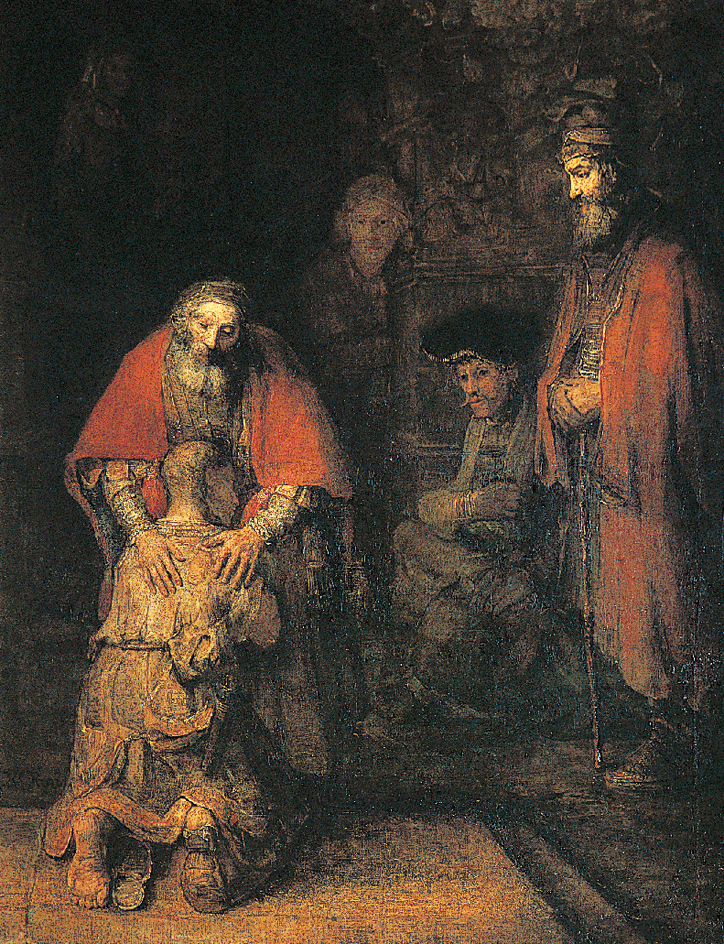
The Spanish masters.
The classical themes favored by many Italian and French artists do not appear in the varied production of Spanish painters of the 1600’s. Both Jusepe de Ribera and Francisco de Zurbaran depicted religious subjects for the Roman Catholic Church. The most famous Spanish painter, Diego Velázquez, painted royal portraits after an early interest in still life and genre pictures.
The influence of Caravaggio appears in the art of Ribera. He worked in Naples, which was controlled by Spain in the 1600’s. There he quickly learned the dramatic realism of Caravaggio’s style by studying the Italian’s altarpieces in Naples. Ribera depicted the heroism and conviction of ordinary people caught up in extraordinary events. Many of his paintings show Christians becoming martyrs or other intensely powerful images of suffering and hardship.
In the art center of Seville, Francisco de Zurbaran developed a style that incorporated Caravaggio’s realism with a native Spanish interest in mysticism. The devout, enthusiastic religious orders of Seville became Zurbaran’s chief patrons.
Zurbaran painted Saint Serapion for the Mercendarian Order of Friars in Seville. The strongly illuminated figure of the saint fills the canvas as his three-quarter-length body is pushed forward toward the viewer. The solid figure of the martyr serves as a solemn and simple focus on devotion and meditation. This mystical and sober quality is Zurbaran’s contribution to painting of the 1600’s.
In the works of Velázquez, the perfection of a national and individual style appears. Early in his career, Velázquez popularized bodegones (kitchen scenes) in which half-length figures are shown eating and cooking in kitchen settings. These paintings include elements of still lifes and are usually marked by vigorous realism and tenebrism.
From 1623 until his death in 1660, Velázquez worked for the Spanish king, Philip IV. He established his international reputation with his royal portraits. Velázquez painted full-length portraits of the king; his wife and children; and his court, including servants, jesters, and dwarfs. In many portraits, Velázquez isolated the figures against a neutral background, focusing the viewer’s attention on the face and attitudes of the sitters. In contrast to Van Dyck, Velázquez included few or no attributes of power in his images of Spanish royalty. Instead, Velázquez heightened the casual, unplanned qualities of his portraits by depicting his sitters engaged in everyday activities in informal settings.
Velázquez’s mature style is revealed in his masterpiece, a portrait of the royal family in the artist’s studio called Las Meninas (The Maids of Honor). This large-scale painting is a portrait of the Princess Margarita Maria. Her royal parents are reflected in the mirror on the back wall. The painter on the left is Velázquez himself. The artist masterfully united real and pictorial space by having the princess look casually out of the composition, presumably toward her parents, who stand in the same position as the viewer. 
Velázquez conveyed a strong sense of realism by depicting figures in frozen motion. A sense of informality is created by the poised brush held by the painter, the initial movements of a curtsy by one of the maids, and the playful kick the dwarf gives the dog at the far right. The spontaneity of the portrait is enhanced by the way in which Velázquez suggested, rather than outlined, forms. His broad handling of rough, broken brushstrokes also produces a powerful sense of light and atmosphere throughout the work.
Rococo painting.
The Rococo style developed in France after the death of Louis XIV in 1715. At that time, aristocrats left the court at Versailles and moved to Paris. There, they became customers for a new style of refined, delicate art that would ornament their city homes. From France, the Rococo style spread as an international court style to Germany and Austria. The term Rococo comes from rocaille, the rock and shell designs that decorated the outdoor parks of the French nobility. In Rococo interiors, curved, organic designs provided the setting for small, elegant works of art.
Rococo painting had its beginnings in the late Baroque period. At the end of the 1600’s, the French Academy divided into two opposing groups, the Poussinists and the Rubenists. The Poussinists followed the stylistic characteristics of Nicolas Poussin. They respected classical design, careful contour lines, and uplifting and intellectual subject matter. In the 1700’s, the Poussinists were overpowered by the Rubenists, who embraced the rich, colorful, and emotional art of Peter Paul Rubens. French Rococo artists adapted the dynamic compositions and energetic brushwork associated with Rubens. These artists painted lighthearted, frivolous subjects, such as courtship, the theater, and games.
Antoine Watteau was an early supporter of the Rococo style. He established a new category of painting called the fete galante, which loosely refers to scenes of couples courting in outdoor settings. In Watteau’s The Island of Cythera (also known as The Embarkation for Cythera, a hazy landscape of pastel colors provides the setting for slender, graceful men and women. They stand on the shore of the island of Aphrodite, the Greek goddess of love. Watteau refined Rubens’s robust colors by applying a pearly white underpaint that glows through the blues, reds, and greens of his figures and landscape. Watteau’s loose handling of paint builds indistinct outlines throughout the composition, heightening the sense of light and movement. 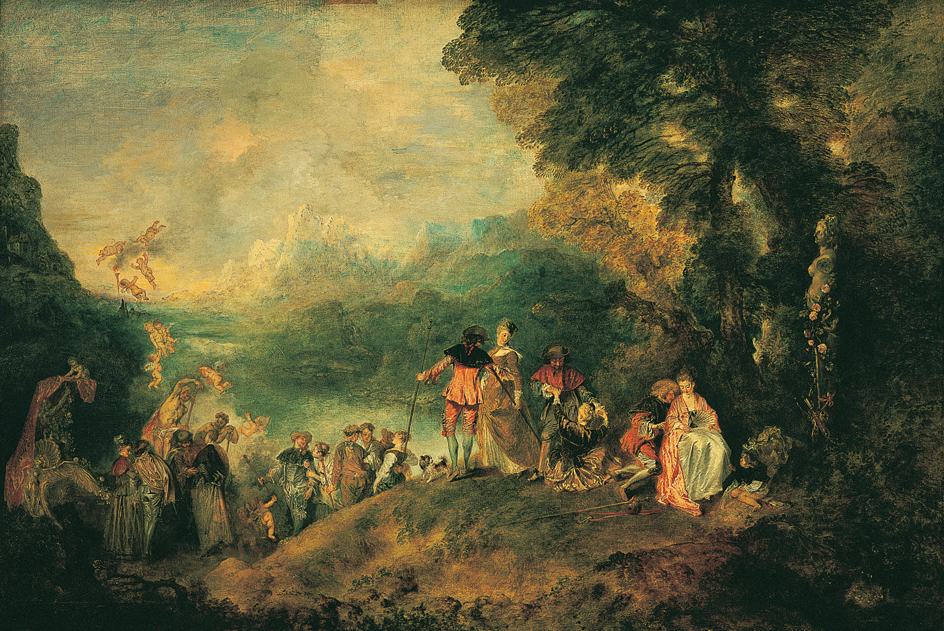
Elisabeth Vigee-Lebrun was one of the most fashionable French painters of the Rococo period. She painted attractive, flattering portraits, devoting much attention to rich fabrics and fine clothes. Vigee-Lebrun’s subjects included members of the French royal family as well as important members of French society.
Francois Boucher was Watteau’s successor. Boucher continued the Rococo style by painting cheerful mythological scenes and informal portraits for the French aristocracy. As a popular painter of the French court, Boucher depicted a wide range of themes in his graceful, delicate style.
Jean Honoré Fragonard, a pupil of Boucher, was the last great Rococo painter. Working during the mature period of Rococo art, he continued the formal characteristics of this charming style in Bathers. This painting was inspired by the colors of Rubens and the technique of Frans Hals. Bathers shows the Rococo preference for playful themes of love. Fragonard’s broken brushstrokes suggest, rather than define, the glowing bodies of nude women bathing in a frothy pond. 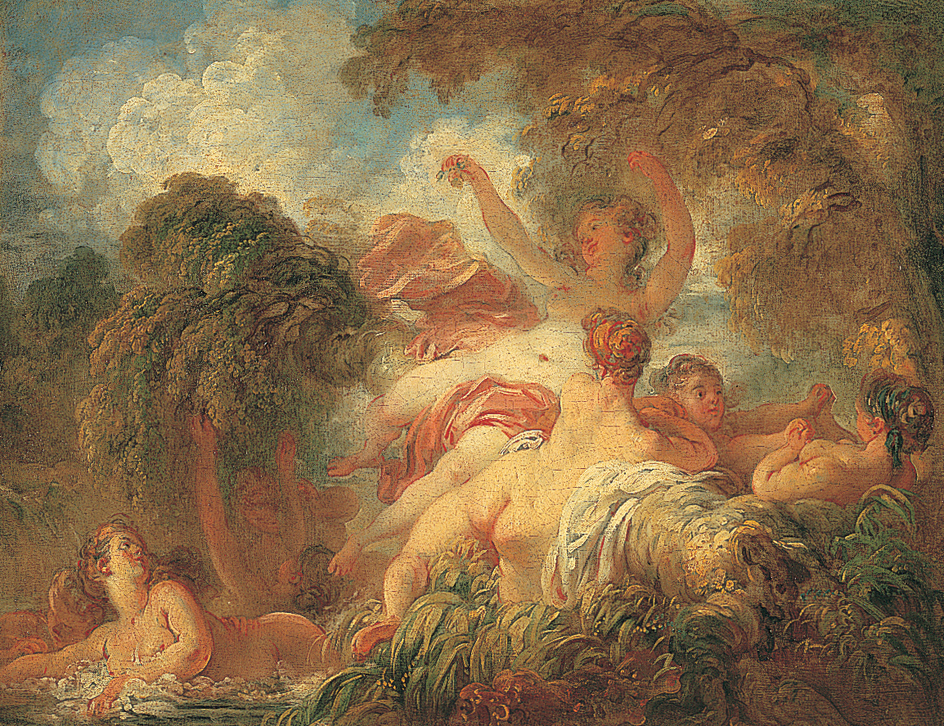
Neoclassicism
refers to a severe style that developed in France at the end of the 1700’s in reaction to the playful quality of Rococo art. Neoclassicism dominated French art from the late 1700’s to the early 1800’s. It signaled a return to the art of Poussin and the French Academy style of the 1600’s. Stylistically, Neoclassical artists valued the formal elements of line and form over color. They considered the proper subjects for art to be moralizing themes of grand historical significance.

In addition to the influence of Poussin, Neoclassical artists were inspired by discoveries at the ancient Roman cities of Pompeii and Herculaneum. The ruins of the cities were excavated in the 1700’s after lying buried in volcanic debris for hundreds of years. Excavations there revealed for the first time actual archaeological evidence of the interiors, clothing, and lifestyles of classical antiquity.
Jacques Louis David was the leader of the Neoclassical movement. He returned to the serious academic traditions that dominated French painting before the light-hearted Rococo age. In The Oath of the Horatii, David painted a straightforward story without distracting details. The clothing and architecture are based on actual historical examples from Roman antiquity. The monumental figures are arranged in rigid poses across a shallow space in imitation of sculptural decorations called friezes found in classical buildings. In the stagelike setting of the painting, the harsh lighting and cool colors emphasize the crisp, hard outlines that define the forms in the composition. The surface of the painting is smooth and highly finished, emphasizing the firmly modeled forms. Brushwork is rarely visible.
The 1800’s
By 1820, an increasing number of artists came to consider Neoclassicism old-fashioned and no longer meaningful. However, its influence lasted into the 1890’s, particularly in France. This influence resulted from the fact that many artists from Europe and the United States went to Paris to study. They enrolled at the state-sponsored Ecole des Beaux-Arts (School of Fine Arts). The school became the most important art school in the Western world and the model for most art schools in the 1800’s. Most students also received private art training in Paris. Both art schools and private teachers based their instruction on Neoclassical principles until the early 1900’s. The term academic has been applied to those artists who followed the conservative ideals taught at the art schools of the 1800’s.
Most academic teachers of art in Paris taught their students that history, including mythology and the Bible, provided the most significant subject matter. From the academy’s point of view, any other subject matter lacked important moral or political meaning. Students learned to emphasize drawing and carefully composed compositions rather than brushwork, color, and natural impulses. Adventurous artists of the later 1800’s received unfavorable reviews of their work. Exhibition juries rejected paintings by artists whose style and subject matter did not meet the rules of academic art.
Later Neoclassicism.
From the 1820’s to the 1860’s, the French painter Jean Auguste Dominique Ingres was the most famous Neoclassical artist. He departed from earlier Neoclassical ideals by rejecting the principle that art had to preach a strong message. But he did argue that artists should paint historical scenes and that all art should be based upon skillful drawing. His smoothly painted, idealized portrait Comtesse d’Haussonville demonstrates one of the many ways the Neoclassical style continued after the time of David.
A late flowering of the Neoclassical tradition occurred in England from the 1860’s to the 1890’s. Such artists as Sir Lawrence Alma-Tadema, Frederic Leighton, and Sir Edward Poynter painted romantic visions of the classical past.
Romanticism
was the major new trend in the arts of the early 1800’s. Unlike Neoclassicism, Romantic art was not linked by subject matter or style. The unifying element among Romantics was a common desire to express the individual’s innermost beliefs, feelings, or emotions. The search for a personal inner voice was often expressed in self-portraits.
The Romantics also made an important contribution to painting by popularizing landscapes. The academic system shunned landscape painting. The academic avoidance of landscape actually proved an advantage to the Romantics, allowing them to experiment in an area where few rules existed.
The German artist Caspar David Friedrich painted some of the most powerful and mystical landscapes of the Romantic period. A typical example is Village Landscape in the Morning Light. Friedrich was deeply patriotic and religious. He believed that only through landscape could he capture his most personal feelings regarding his love for his country and his belief that God was most closely felt in nature. Friedrich’s paintings are based upon careful studies of the natural world. However, his works are filled with a mysterious, otherworldly quality that goes beyond nature and demands a strong emotional response from the viewer.
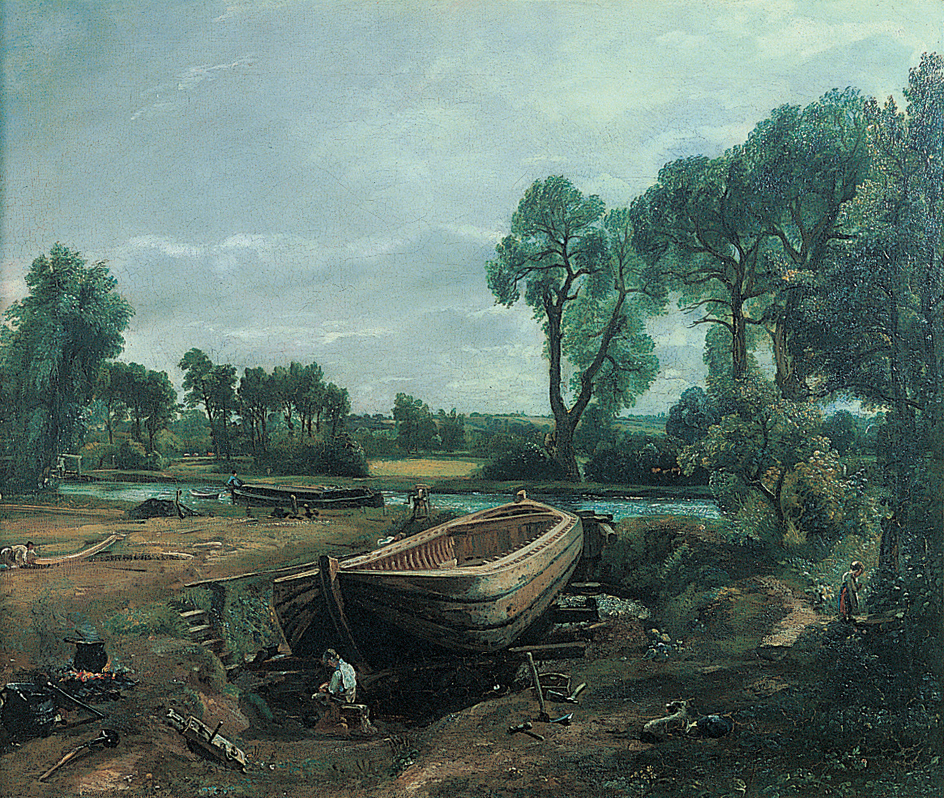
Constable’s approach to painting created a sense of real living nature that influenced Romantic painters in France, particularly Camille Corot and the Barbizon School, led by Jean Francois Millet and Theodore Rousseau. These artists captured the simple beauty of the countryside around the village of Barbizon, near Paris. Their paintings often stress the strong bonds between the peasants and their environment. Of these artists, Millet particularly emphasized the difficult but pious life of the hard-working French peasants.
In contrast to the work of Constable or the Barbizon School, J. M. W. Turner of England took a different approach to the study of nature. His late work in particular explores in a personal way the strong effects of color and atmosphere. Turner preferred warm colors, swirling paint, and light that seems to dissolve forms. He created an emotional interpretation of the power and mystery of nature that is far more troubling than the work of other landscape painters of his time. A good example of this more pessimistic vision of nature is his Snowstorm: Steamboat off a Harbour’s Mouth. For all its brilliant and beautiful effects of light, the painting presents the viewer with a vision of humanity unable to control the forces of nature. 
The Romantic notion that one must deal with one’s innermost fears and thoughts is perhaps most often found in the work of the Spanish artist Francisco Goya. As he grew older, Goya became increasingly depressed and discouraged about his own life and humanity in general. Goya was one of the first artists to persistently explore the dark side of the human mind. Some of his work evokes a disturbing nightmare full of haunting thoughts about life and war.
Romantic artists were among the first to feel it was the artist’s responsibility to respond to events of their day. After witnessing the horrors of the French occupation of Spain that began in 1808, Goya painted his famous The Executions of 3rd May, 1808. The painting shows the cold-blooded execution of several Spaniards suspected of participating in an uprising against the French. Goya portrayed faceless, anonymous French soldiers who methodically shoot the civilians. For the first time, an artist made a modern statement about war, emphasizing not heroes but helpless victims. The strongly contrasted lights and darks and the rich, loose brushwork add to the emotional impact of the work. Goya was telling the viewer that war is a senseless, brutal act. He dealt even more honestly and graphically with the darker sides of war in his series of etchings the Disasters of War. 
In France, the first two major Romantic artists were Theodore Gericault and Eugene Delacroix. Gericault’s The Raft of the Medusa deals with an event of his time, the horrible suffering of survivors of the wreck of a French ship off west Africa in 1816. In contrast to the Neoclassical style, Gericault’s brushwork, color, and lighting produce an intensely emotional reaction from the viewer.
Like many other Romantics, Delacroix was fascinated with non-Western cultures. He was particularly attracted to the Middle East, where France was establishing colonies. His The Women of Algiers is a typical Western fantasy of another culture in the early 1800’s. Delacroix portrayed beautiful women and exotic clothing, accessories, and architecture, creating a sense of mood and mystery through the use of deep shadow.
Art for a new public.
By the 1830’s, growing numbers of artists were creating works meant to appeal to a new art audience. This audience consisted of the unsophisticated but enthusiastic European middle class. These people attended art exhibitions in rapidly increasing numbers.
Some artists, such as Paul Delaroche of France, painted sentimental historical scenes. Other painters, including Sir David Wilkie of Scotland and Sir Edwin Landseer of England, concentrated on storytelling or sentimental scenes of everyday life in addition to historical painting. Landseer’s The Old Shepherd’s Chief Mourner is a typical example of pictures that appealed to the new popular taste. The painting shows a sad dog, the only mourner at the draped coffin of its master, surrounded by the remains of their humble but happy existence.
Realism.
By the late 1840’s, an increasing number of painters believed that artists should focus on the life of their day, presenting it in an accurate and objective manner. Scenes of everyday life did appear in art of the early 1800’s, but the subject became the dominant trend from about 1850 to the end of the 1890’s. Artists who specialized in creating scenes of daily life are now called Realists.
The most famous and innovative Realist painter was Gustave Courbet of France. Courbet argued that artists must paint scenes of everyday life taken only from their experiences. They should present the subjects in a style that would convince the viewer that the event had actually happened in the way the artist showed it.

The impact of Courbet in France was tremendous. Academic artists called his work crude, vulgar, and pointless. But many young painters in Paris immediately began to portray scenes of modern life in an honest and unsentimental fashion.
The Pre-Raphaelite Brotherhood
was a group of English painters founded in 1848 who were influenced by both Romanticism and Realism. They called themselves Pre-Raphaelites because they wanted to revive the purity and sincerity they saw in Italian art before Raphael. The leading Pre-Raphaelite painters were William Holman Hunt, Sir John Everett Millais, and Dante Gabriel Rossetti. Many of their works deal with everyday life, such as scenes of woodcutters, roadbuilders, poor children, and young lovers. Other works deal with the Bible and literature.
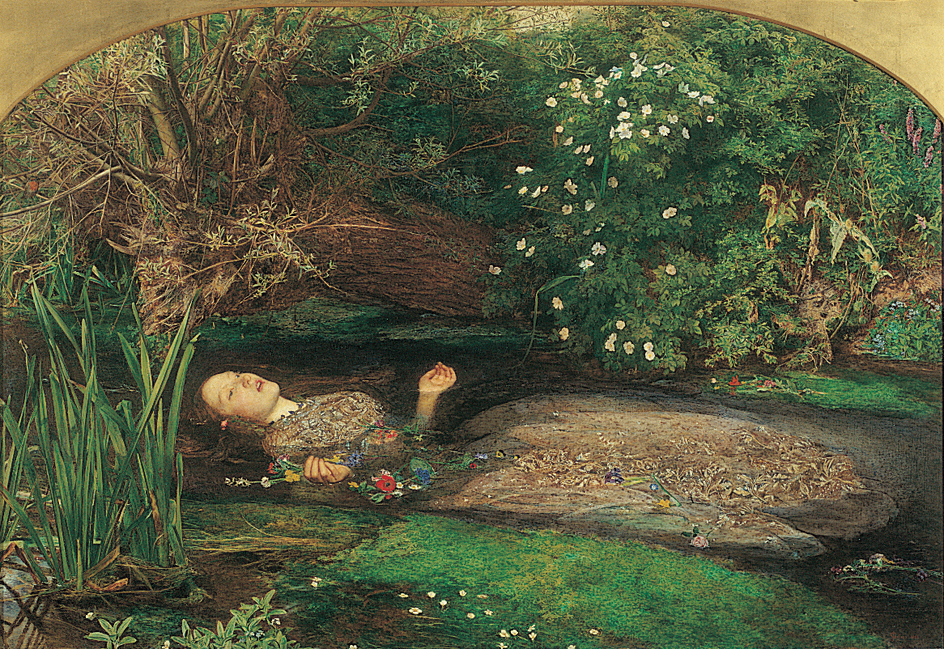
The combination of close observation of nature and imaginary events frequently gives an odd feeling to Pre-Raphaelite paintings. Inspired by Rossetti, many later Pre-Raphaelite artists, such as Sir Edward Burne-Jones, preferred to abandon the study of nature for a more dreamlike vision of the past.
Édouard Manet and the Impressionists.
The early French Realists concentrated on scenes of country life. However, beginning in the 1860’s, Édouard Manet and other French artists of his time began to focus on urban themes. Manet’s Music in the Tuileries Gardens successfully captures a sense of the newly leisured middle classes relaxing and listening to music in a park near the Louvre museum in Paris.
Manet included little detail in his paintings and did not carefully model his figures. He believed that his apparently rapid, impulsive brushwork would convince the viewers they were looking at a scene actually observed by the artist. The French art establishment attacked Manet’s everyday subject matter and his sketchy style. As a result, the public rarely saw his art during his lifetime.
Manet’s approach to art had a major influence on a group of art students of the 1860’s who later became known as the Impressionists. They agreed with Manet’s insistence that artists portray the experience of average city dwellers in a natural, unplanned style. Such a style, they believed, captured the movement and energy of their age.
The Impressionists initially included Edgar Degas, Claude Monet, Camille Pissarro, Pierre Auguste Renoir, and Alfred Sisley. They were eventually joined by such artists as Mary Cassatt, Berthe Morisot, and Gustave Caillebotte. All were influenced by French and English Romantics as well as Realists, but they admired no artist more than Manet. In the 1870’s, he in turn would be inspired by these younger artists.
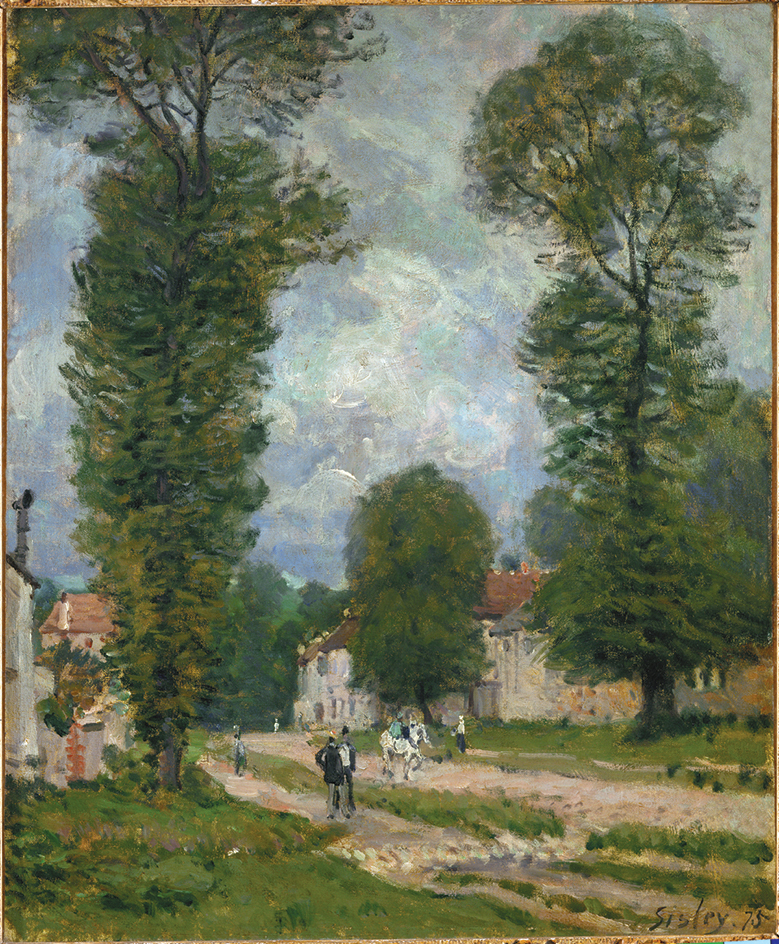
In most Impressionist pictures, the figures are ordinary middle-class city dwellers like the artists. The paintings celebrated the Paris of grand boulevards and exciting night life. Even when the Impressionists painted village and riverbank scenes, they usually showed the weekend activities of Parisians taking day trips into the nearby countryside. An example is Renoir’s The Luncheon of the Boating Party.
Some Impressionists, including Degas, Cassatt, and Caillebotte, preferred to work traditionally, basing their final paintings on drawings or studies. However, most Impressionist artists developed a revolutionary style that involved working directly from their subject, not from preparatory studies. For example, in his Two Sisters, Renoir applied the brushwork quickly and thickly. The colors are extremely bright, and the modeling of the forms is not emphasized.
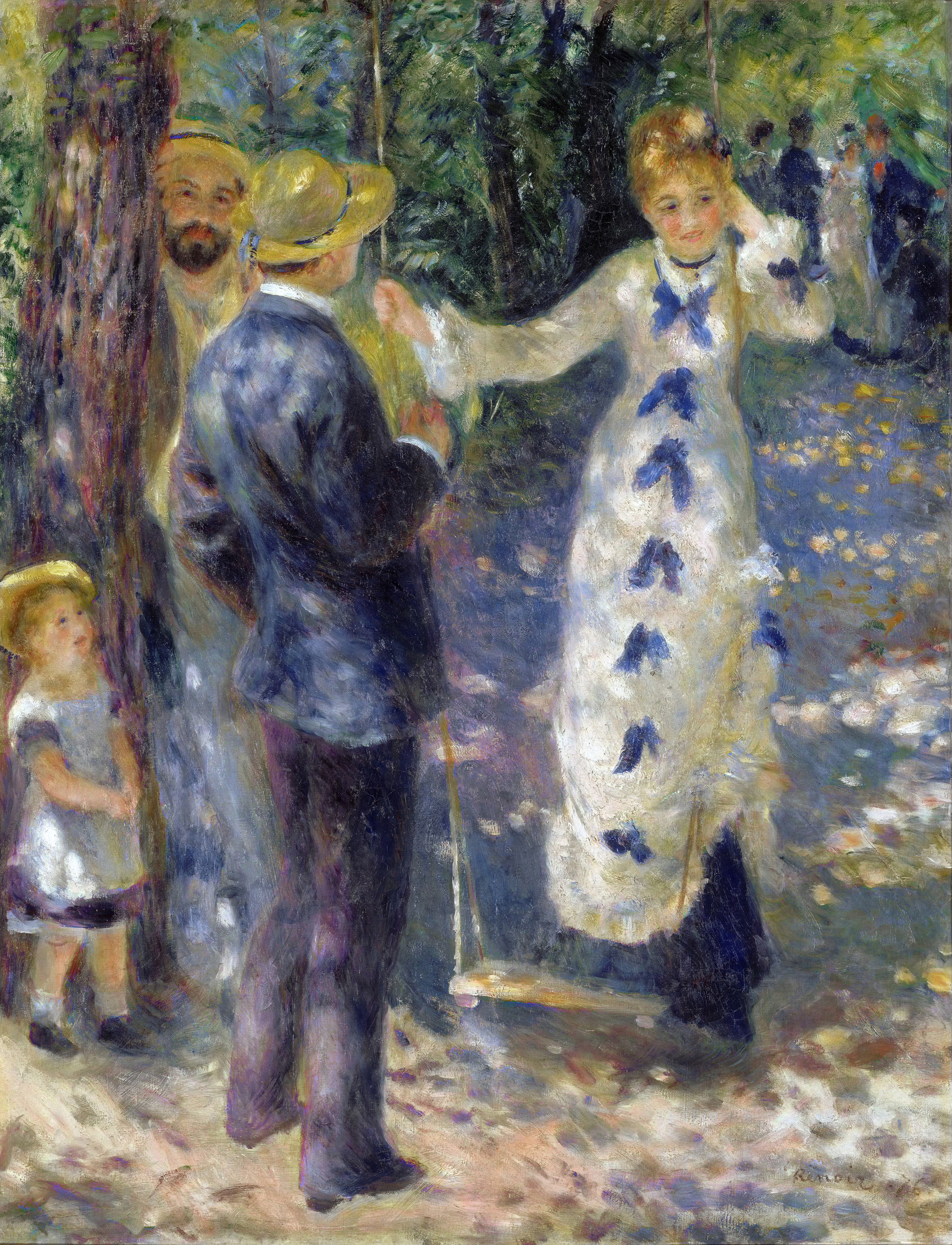
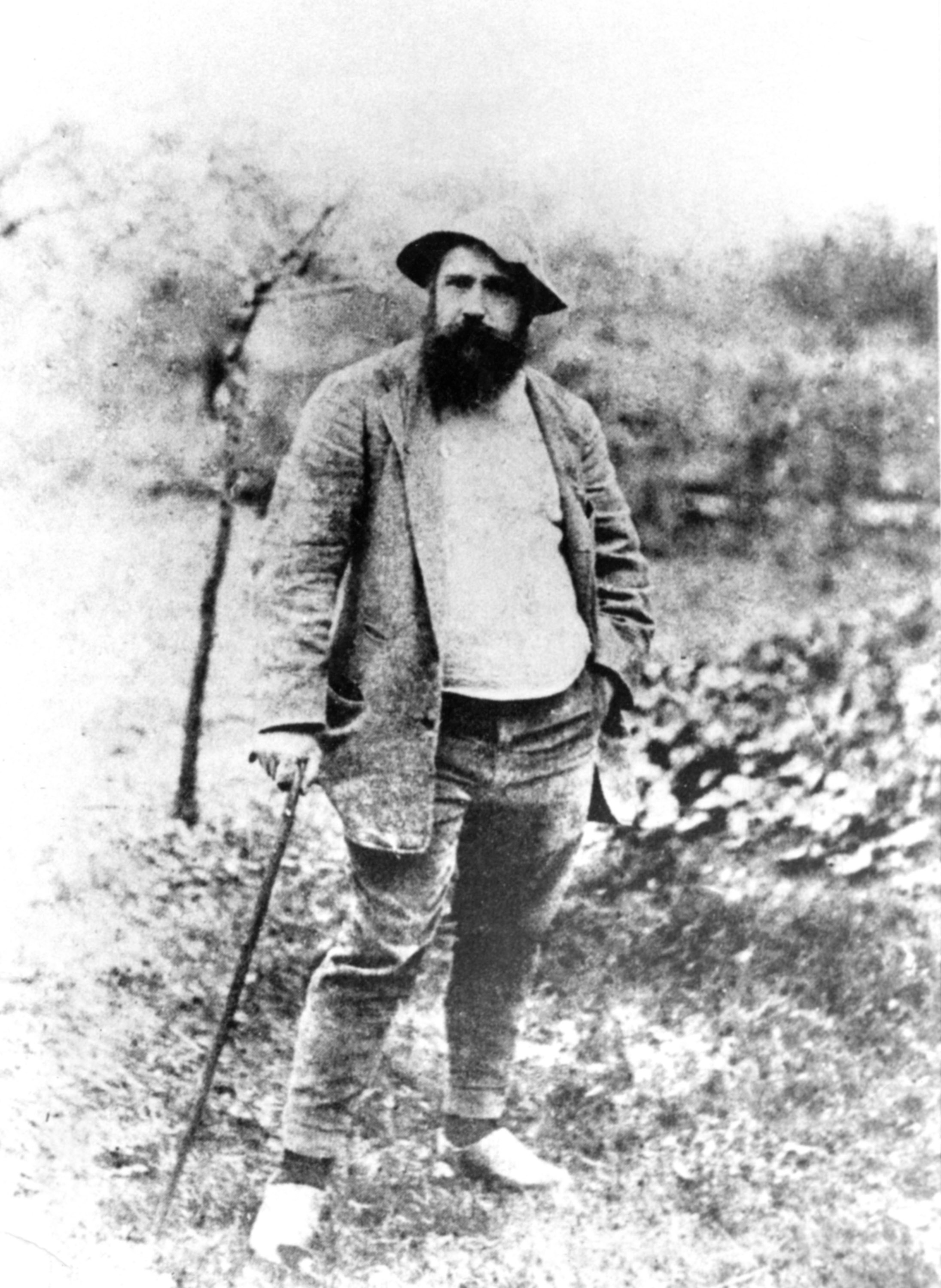
As a result of years of carefully studying nature, the Impressionists produced paintings full of sparkling light, shimmering water, and other effects never before seen in art. Whether in city or rural scenes, the human figures are portrayed in harmony with their environment. Never previously had the passing or momentary qualities of nature and human activities been captured so convincingly.
New visual sources.
The work of the French Realists and Impressionists looks far different from the paintings created earlier in the 1800’s, largely because of the impact of new visual sources. The desire to make things look “objectively real” occurred in the years just after photography became available to the public. Some of the Impressionists’ freshest and most creative ideas may have come from looking at photographs. These ideas include figures cut off at the edge of the painting, unbalanced compositions, and blurred figures. The Dancing Class by Edgar Degas is an example.

The Impressionists and other artists also took their subject matter from illustrations published in popular magazines of the day. In addition, Japanese prints, collected by Manet and other artists, played a central role in art of the later 1800’s. These prints emphasized cut-off figures and unusual compositions, scenes viewed from above, flat and unmodeled forms, and bright colors. Several of Mary Cassatt’s paintings, including The Bath, are brilliant reinterpretations of ideas she gained from studying Japanese art. The concept of looking at non-Western sources for fresh ideas would become increasingly popular during the late 1800’s and early 1900’s.
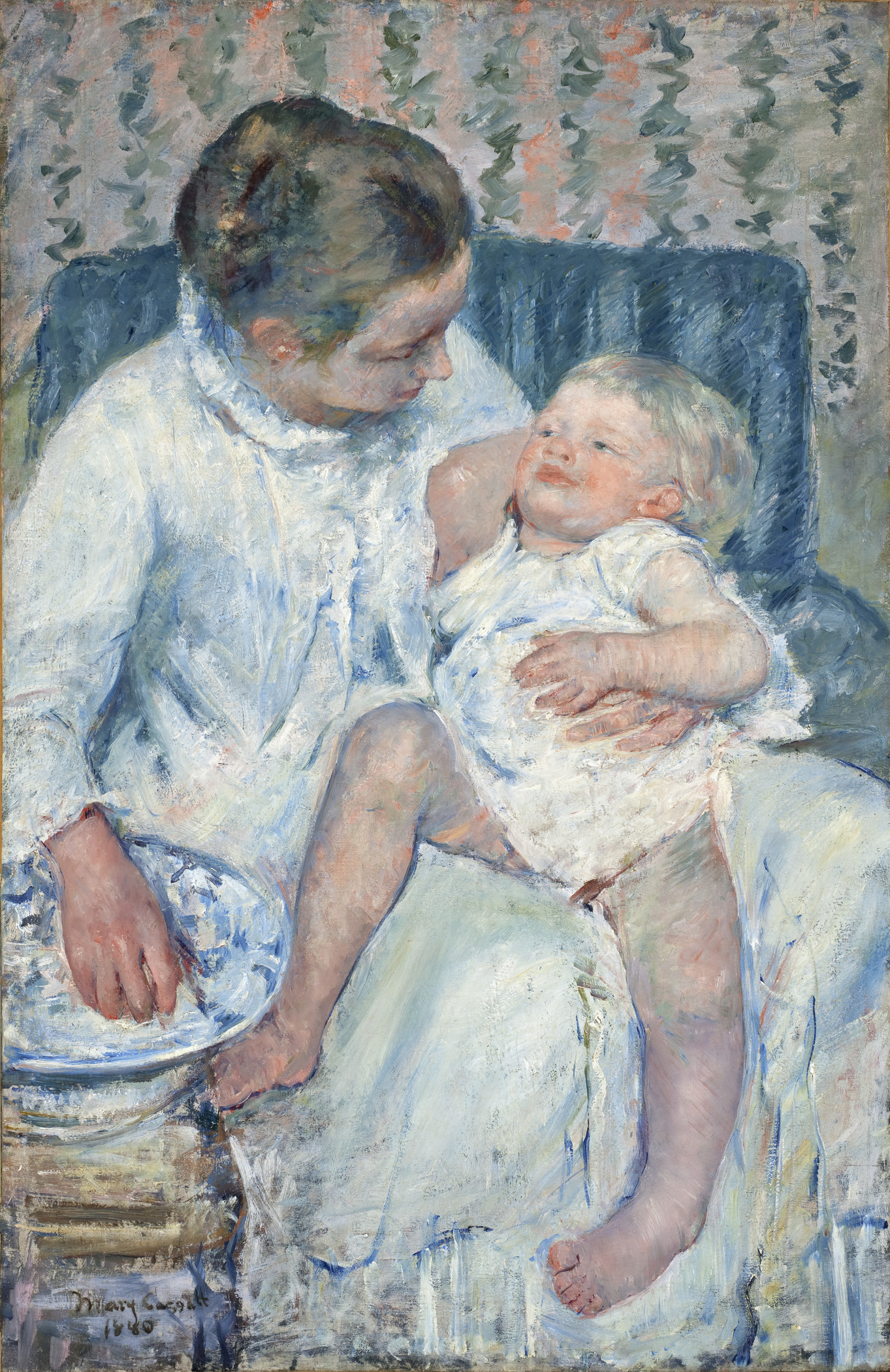
Painting outside France.
Realism was the most popular art movement from about 1850 to 1900. In England, the leading Realist painter was William Powell Frith. During the 1850’s and 1860’s, he painted vast crowd scenes that portrayed the action of people from many walks of life. Even French academic artists, including James Tissot, portrayed the life of their times. Some of Tissot’s pictures poke fun at the attitudes of the newly rich in London who were trying to learn how to act in high society.
Some Realists had important comments to make about society. In Russia, a group of artists called the Wanderers created works that toured from city to city. The paintings dealt with the chief problems of the day, including poverty, lack of education, and poor medical care. To these painters, artistic issues were secondary to their desire for reform that would correct social injustice. Many paintings of Ilya Repin portray the hard life of peasants. In England, such young artists as Sir Luke Fildes, Sir Hubert von Herkomer, and Frank Holl portrayed the difficult condition of the homeless, the elderly, and strikers. These artists are now called Social Realists.
Realism was also popular in the United States. Winslow Homer created memorable scenes of everyday life of New Englanders and Maine fishing crews. Thomas Eakins returned to Philadelphia after learning Neoclassical techniques in Paris to create powerful Realist portraits. An example is his portrait of poet Walt Whitman in the article Whitman, Walt. The African American artist Henry Ossawa Tanner, a student of Eakins, subtly captured the spiritual side of a humble family in The Thankful Poor. 
The international impact of Impressionism was not felt until the 1890’s and early 1900’s. By then, followers of French Impressionism could be found throughout the world. Besides the American-born Mary Cassatt, the most famous American Impressionist was Childe Hassam. However, many young artists did not really understand Impressionism, equating it simply with middle-class subject matter, bright colors, and loose brushwork.
The art world, 1850-1900.
During the later 1800’s, art enjoyed unprecedented popularity. Each year, thousands of visitors attended exhibitions of new artworks held in most Western European countries. The two most famous were the Salon exhibition in Paris and the Royal Academy of Arts exhibition in London. Enthusiastic visitors went to these shows to be instructed and entertained. In the days before motion pictures or television, no other medium had the impact of painting. Viewers could see history come alive in the works of Ingres and Alma-Tadema. Beautiful landscapes with happy peasants and contented animals satisfied the nostalgic needs of the city dwellers. Genre scenes by Frith or the Impressionists captured everyday middle-class urban existence in all its variety. Some paintings were so popular that railings had to be placed in front of them to keep the audiences from getting too close.
Popular artists, such as Alma-Tadema and the French academic painter William Bouguereau, became millionaires. They enjoyed fame and social status rivaling today’s movie stars. They made vast sums of money not only from their paintings but also from the sale of engravings that reproduced their work.
The profits to be made from art led to an increasingly important role for art dealers. Art critics also began to play an essential part for the first time. Many exhibition visitors felt they lacked the necessary understanding of art to absorb the thousands of works in the large exhibitions. They looked to the critics for guidance. Many critics wrote for art magazines, another popular way people learned about art.
Women artists.
Unprecedented numbers of women became painters during the 1800’s, but they rarely enjoyed the success and popularity of male artists. This inequality resulted from several factors. Women were not allowed into the best art schools, primarily because it was considered improper for women to study and paint a nude model. Thus, women lacked the necessary training to compete with men in the area most admired in the academic world, figurative and historical painting. This exclusion also kept women from making the political and social contacts necessary to succeed in the competitive art world.
The English painter Emily Osborn explored the difficulties faced by women attempting to break into the man’s world of art in Nameless and Friendless. The painting shows a poor young woman, apparently a widow, finding her art treated with disdain by a pompous male art dealer. The gaze of the two men watching at the far right implies that they admire her as a beautiful woman but do not take her seriously as a creative artist.
Young female art students believed they lived in a promising period in spite of the many difficulties they were forced to overcome. Private coeducational art schools were common, as were schools for women only. But even these schools would not allow women to work from nude models until the turn of the century. The large national exhibitions exhibited many works by women, partly because entries were submitted anonymously. By the mid-1800’s, women also began to hold their own private exhibitions.
The most significant show of women’s art in the 1800’s was held at the Chicago World’s Columbian Exposition in 1893. Mary Cassatt painted the mural Modern Woman especially for the Women’s Building. Women also showed their work by joining movements or groups of male artists who were treated as outsiders because of the radical nature of their art. For example, both Cassatt and Berthe Morisot played central roles in Impressionism when that movement was scorned by the art establishment.
The most famous woman artist of the 1800’s was the French painter Rosa Bonheur. The sale of her paintings and the engravings of her pictures enabled her to live in a grand chateau in the countryside near Paris. Bonheur specialized in animal paintings. Her best-known work was The Horse Fair. Animal themes were popular in the 1800’s, and only Sir Edwin Landseer of England was considered Bonheur’s rival. Bonheur had the ability to portray beautiful, majestic, and spirited animals. She often showed animals playing an essential part in agriculture, generally working in harmony with people, and at times displaying human emotions.
In England, Elizabeth Thompson (who later became Lady Butler) was the only woman painter who matched Bonheur’s fame. Thompson was the first woman artist to succeed in military painting. Her painting The Roll Call: Calling the Roll After an Engagement, Crimea was one of the most popular pictures ever exhibited in a Royal Academy show, and was purchased by Queen Victoria. Thompson’s subject is the aftermath of a hard-fought battle between the English and the Russians during the Crimean War of the 1850’s. She did not focus on the glories of victory. Instead, she presented a close-up look at the emotional and physical exhaustion of the soldiers as they struggled to answer roll call. Her gritty realism became immediately popular, because never before had the British public been so exposed to the true nature of war.
Today, the Impressionist painters Mary Cassatt and Berthe Morisot are the most popular female artists of the 1800’s. Both organized and participated in group exhibitions and helped sell Impressionist works to rich friends. Their art differs from that of male artists in its emphasis on the daily lives of middle-class women. Cassatt and Morisot especially painted the domestic existence of these women, often focusing on themes of parents and children. The two women also painted scenes of their summer vacations as well as their urban lives, such as riding in carriages or attending the opera.
Postimpressionism.
Unlike Impressionism, Postimpressionism was not a movement of artists working toward similar goals. The term has been used to refer to several artists who were influenced or taught by the Impressionists, but who later rejected or modified that group’s ideas. The Postimpressionist painters, with their varying styles, now are among the most admired figures in the history of art.
The Postimpressionists were little known during their lifetimes, but shortly after their deaths they had a tremendous impact on the young experimental artists of the early 1900’s. The most influential Postimpressionists were Paul Cézanne, Paul Gauguin, Georges Seurat, Henri de Toulouse-Lautrec, and Vincent van Gogh.
Cézanne painted landscapes that stressed what he felt was lacking in the Impressionist approach—form and mass. In addition, his still lifes and portraits had a huge impact on artists of the early 1900’s. For example, Still Life with Commode taught the Cubist artists Pablo Picasso and Georges Braque that space and perspective could be manipulated in any way the painter chose.
Both Gauguin and van Gogh wanted to express their innermost feelings through their art. The Starry Night shows how van Gogh achieved this goal through his use of intensely brilliant color; thick, rapidly applied brushstrokes; and expressive line. Few artists have been able to equal the passionate intensity of his paintings, which he filled with both hope and pain. Van Gogh’s choices of color and subject matter often had an emotional and personal meaning for him. He was a key influence on the Norwegian artist Edvard Munch and, through Munch, the German Expressionist painters of the early 1900’s.
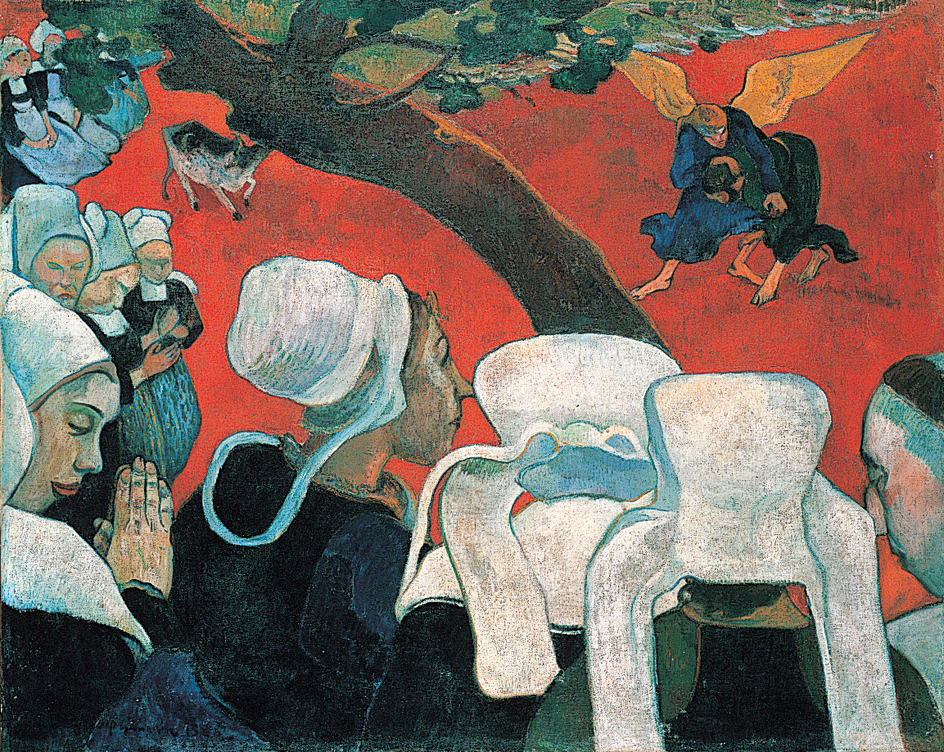
Like much of Gauguin’s work, The Vision After the Sermon provokes more questions in the mind of the viewer than it answers. Gauguin would later search for purity and simplicity in both his life and his art by settling on the island of Tahiti.
Toulouse-Lautrec is best known for his paintings and lithographs of Parisian night life in the 1880’s and 1890’s. He painted scenes of Paris cabarets and music halls as well as portraits of dancers, singers, clowns, and prostitutes. Toulouse-Lautrec was strongly influenced by Edgar Degas and Japanese prints. He was a master at capturing movement. His forms were flat with curved lines. Many of his scenes of night life were energized by bright colors, vivid lighting, and strong contours. An example is At the Moulin Rouge. He painted many of his oils on unprimed cardboard, so that the neutral whitish color of the board became part of the design. 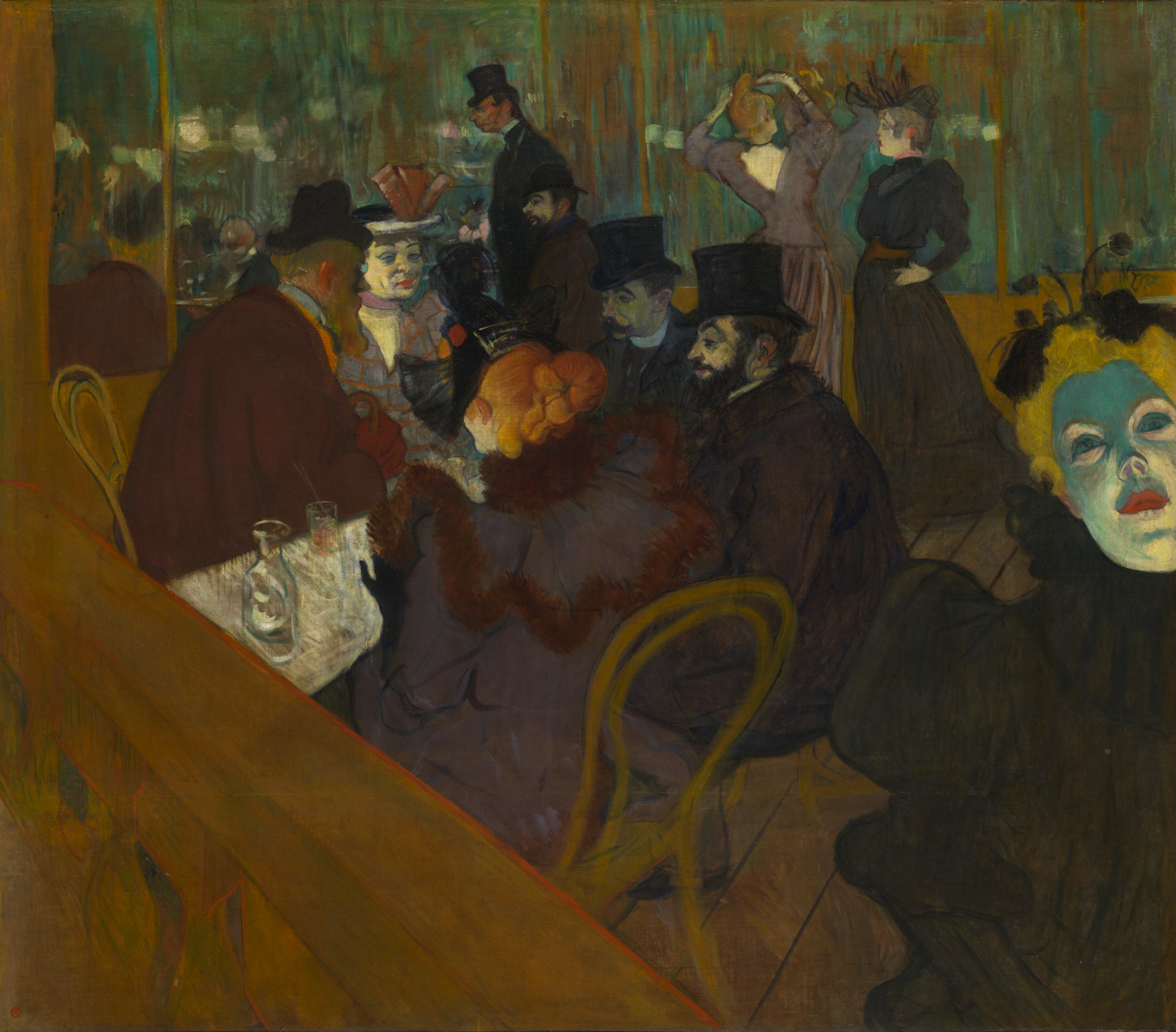

Traditionally, La Grande Jatte has been interpreted as a picture of working-class and middle-class people enjoying a Sunday afternoon of relaxation. However, some modern art historians have called attention to the fact that nobody is outwardly happy, no figure looks at any other figure, and few people interact. These historians claim that Seurat actually meant the painting to condemn the impersonal society of the late 1800’s.
Symbolism.
The Symbolists were an international group that flourished particularly in the 1890’s. Like the works of the Romantics, the art of the Symbolists varies tremendously in both style and subject matter. Generally, Symbolist painting reflects a growing demand for more spiritual, emotional, and personal approaches to art in a period dominated by Realism and Impressionism. From these viewpoints, Gauguin is often called a Symbolist, as are some other Postimpressionist artists. The writings of Symbolist authors inspired many young artists. So did the fantasies painted by such older artists as Dante Gabriel Rossetti and Sir Edward Burne-Jones in England and Gustave Moreau and Odilon Redon in France.
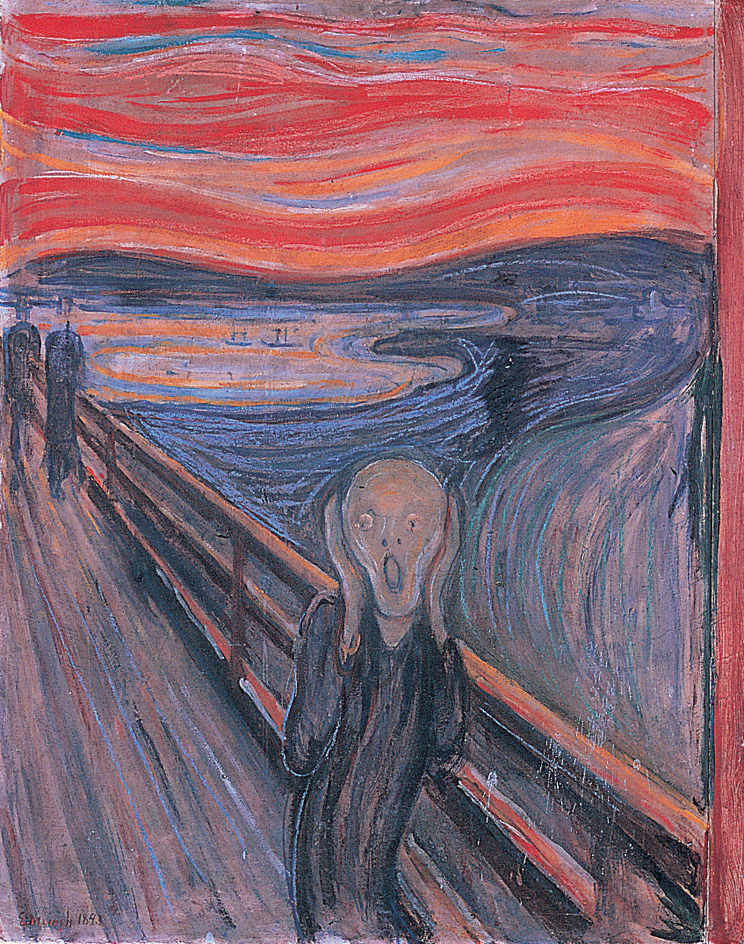
Many Symbolists were unhappy with the nature of capitalist urban society in the late 1800’s. They objected to such social ills as poverty amid great wealth, pollution, and the shallow values they saw in the middle class. They were also unhappy with how industrial development and new technologies were altering society. Because the Symbolists were displeased with the everyday world around them, they retreated inward, preferring to deal with their own personal feelings and interests. Because Symbolist art was not appreciated in conservative circles, many Symbolists formed groups and held their own exhibitions.
No Symbolist better expressed the anxieties felt during the late 1800’s than Edvard Munch of Norway. His haunting painting The Scream portrays the inner turmoil so many people felt. The painting’s composition seems to endlessly echo the isolated figure’s cry of fear and loneliness.
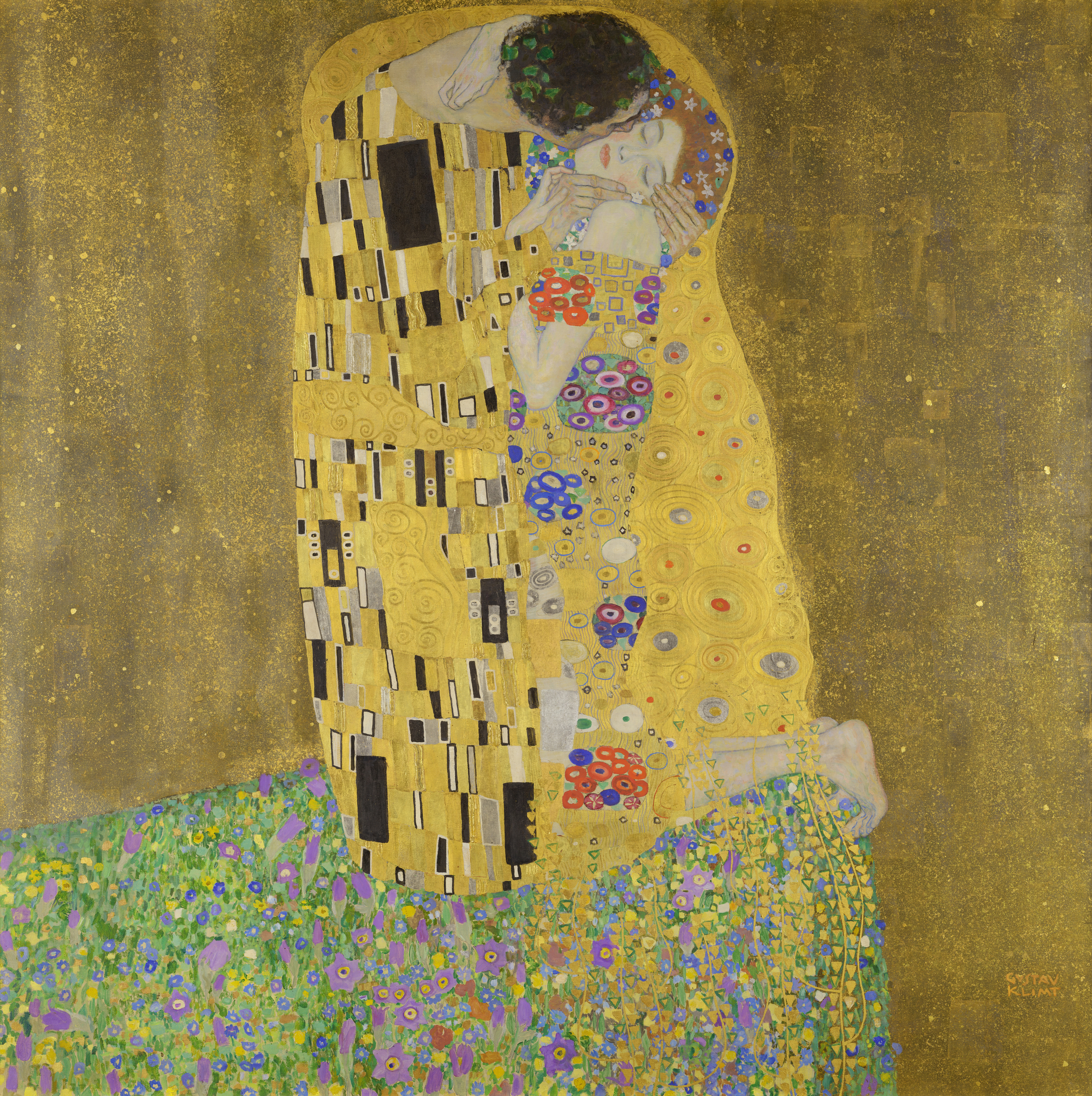
The 1890’s were also a period when many men were confused about the changing roles of women in Western society. Women were demanding and slowly gaining increased political, social, and sexual rights and power. Many men observed these changes between the sexes with fear and uncertainty. In reaction, some male Symbolist artists painted images of women who were both beautiful and dangerous, sometimes deadly, to men. An example is Judith with the Head of Holofernes by the Austrian Symbolist Gustav Klimt. The artist based the scene on a Biblical story about a woman who saves her town by beheading the leader of a besieging army.
Legacy of the 1800’s.
The art world of the 1800’s ended in great confusion and excitement. Many of the old pictorial traditions popular since the Renaissance were coming to an end. These traditions included deep logical space, linear perspective, and carefully modeled forms. Artists of the later 1800’s engaged in experiments with space, two-dimensional forms, and the personal and expressive use of color, brushwork, and line. Because of the efforts, inspiration, and doubts of many artists of the late 1800’s, the early 1900’s would prove to be one of the most important and innovative periods in art history.
The 1900’s in Europe
The Fauves.
By the year 1900, a new approach to painting had become established in France. This new approach included the work of the Impressionists and Postimpressionists. One artist who became interested in Postimpressionist painting was Henri Matisse. In the fall of 1905, Matisse exhibited a number of bold, colorful pictures at the Salon d’Automne, a famous exhibition in Paris. He was joined by several friends and colleagues, including Andre Derain, Albert Marquet, and Maurice de Vlaminck. One critic who saw this exhibition referred to the artists as the fauves (wild beasts). This term became the name of the first major art movement of the new century.
Loosely defined, the Fauve style consisted of painting that portrayed simplified views of nature filled with pure, concentrated color applied with rapid brushstrokes. There was little mixing of raw pigment and almost no modeling or shades of color.
The Fauves disbanded in 1907, and the artists continued to develop separately many of the ideas they had shared as a group. After 1907, Matisse moved away from art that represented nature into art that was more idealized and abstract. His The Dance I employs a radical reduction of all pictorial techniques. There is less attention to drawing, spatial construction, and surface texture. What does emerge in The Dance I is the intense color, which became exaggeratedly expressive as Matisse abandoned the brushwork of his earlier Fauve canvases. 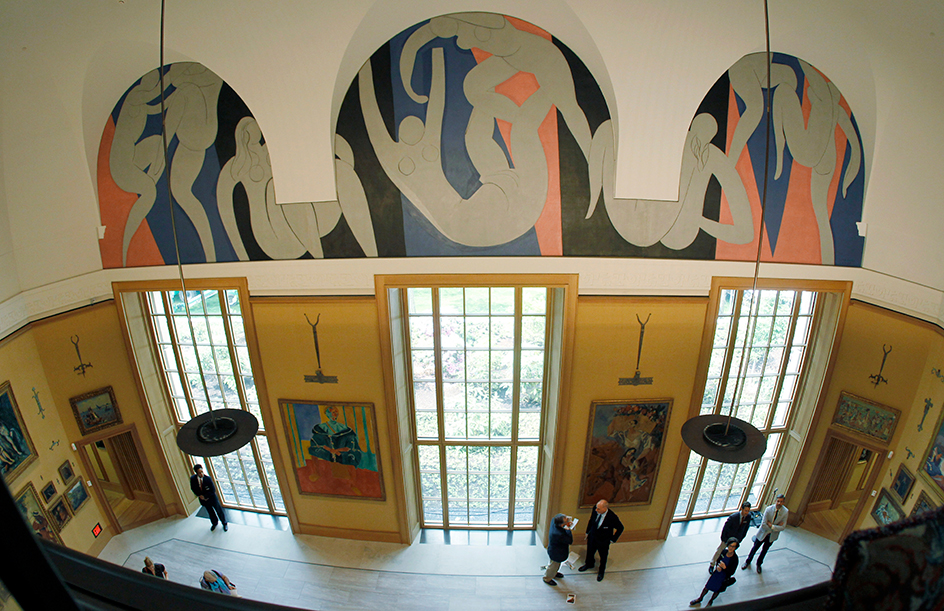
Cubism,
like the Fauves, was a movement that grew out of the influence of Postimpressionism. But the Cubist paintings of Pablo Picasso and Georges Braque, the leading Cubists, were far different from the Fauve works of Henri Matisse. Picasso and Braque indicated a new set of goals for what painting might achieve in the 1900’s. 
Picasso was born in Spain but settled in Paris in the early 1900’s. His first works were heavily influenced by the French Symbolists. In paintings such as The Old Guitarist, Picasso used mainly blue tones. Blue colors dominate in other Picasso works of this time, known as the artist’s Blue Period. The blue paintings are marked by a melancholy feeling, portraying such subjects as beggars, the homeless, and starving children.
Picasso’s Blue Period lasted more than three years and was followed by the Rose Period, which emphasized rose-colored pigments. Picasso abandoned this style in 1907 when he began exploring his interest in so-called “primitive” sculpture from such non-Western lands as Africa and the Pacific Islands.
Perhaps Picasso’s most famous painting is Les Demoiselles d’Avignon. Picasso began the painting out of an impulse to combine the classical sculpture of the pre-Roman Iberian culture (present-day Spain and Portugal) with the raw, expressive power of African masks. The painting shows the interior of a house of prostitution in Barcelona, Spain. Five female nudes, two with faces that resemble African masks, stand in a shallow space between two curtains. Picasso communicated a psychologically tense experience through crude brushwork and deliberate distortions of drawing and perspective. 
From 1909 to the outbreak of World War I in 1914, Picasso and Georges Braque established the basic images and artistic principles that resulted in the birth and development of Cubism. Other Cubist painters included Juan Gris of Spain and Fernand Leger of France.
Cubism was not so much an art of cubes as of planes. The artist assembled these planes from multiple perspectives that present the many aspects of a subject all at once. In Braque’s Violin and Palette, the forms of a violin and an artist’s palette are displayed as though the viewer were looking at them from many different perspectives at once. The forms melt into one another, discouraging the eye from resting on any one part of the canvas. This early phase of Cubism is called Analytic Cubism. The goal of Analytic Cubism was to examine form and matter, to break them down into their essential elements, and then to reassemble them in a new way. Another example is Braque’s Man with a Guitar. 
Primarily, Picasso wanted to collect the objects of everyday life and reassemble them in a nontraditional manner that would shock and disturb the viewer. This new way of depicting commonplace subject matter developed even more intensively during the second stage of Picasso’s and Braque’s Cubist work from 1912 to 1914. This period saw the birth of Synthetic Cubism, in which the artist accumulated a range of purely pictorial elements and combined them to create a new form. Such elements typically consisted of everyday materials, such as pieces of newspaper and bottle labels. Picasso and Braque adopted nontraditional methods to construct their Cubist images. One popular method was collage, in which the artist glued bits of paper and other materials onto the painting. An example of collage is Juan Gris’s The Bottle of Banyuls.
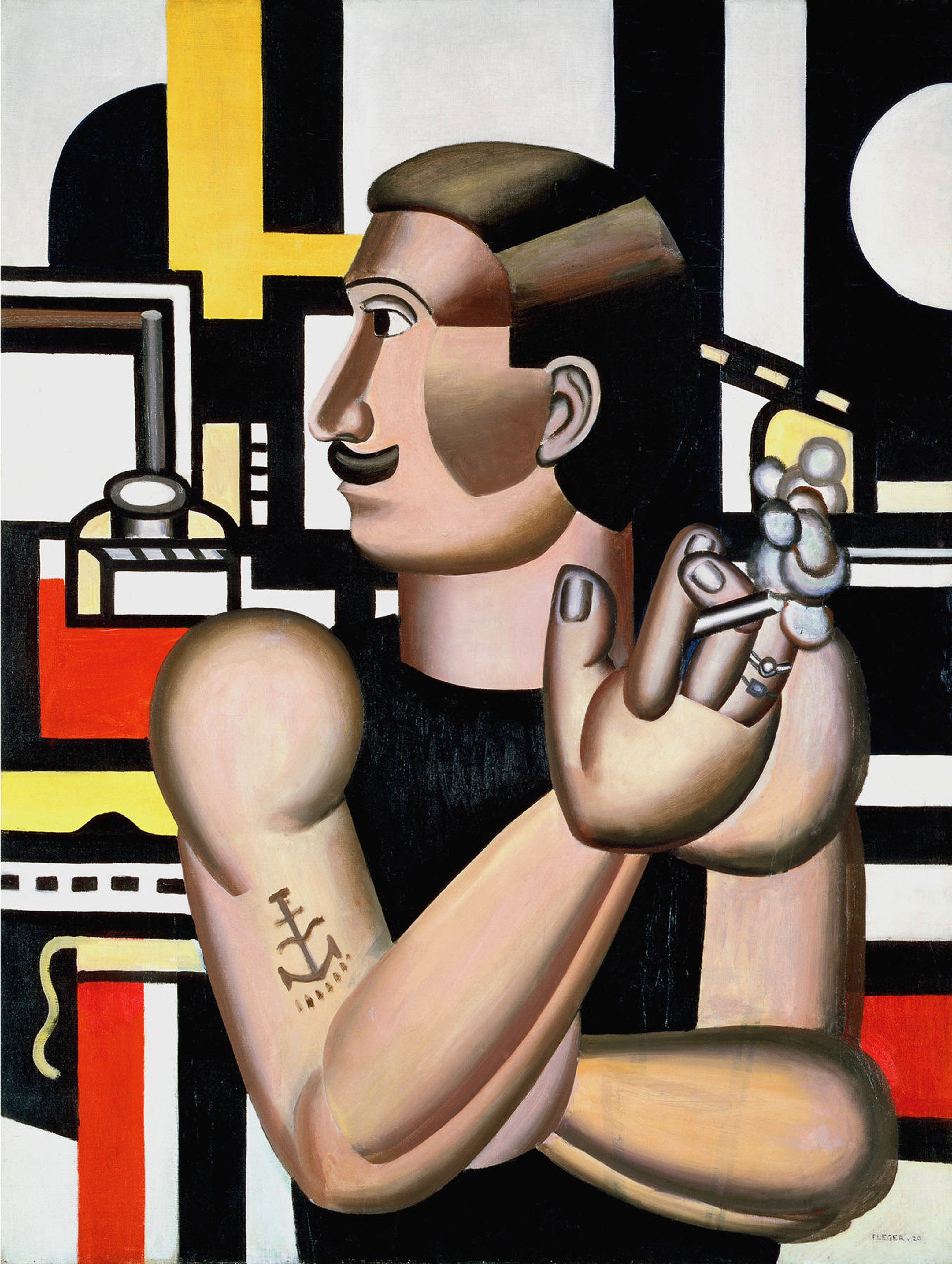
Cubism was hailed throughout the world as a symbol for all that was truly advanced and modern in art. For years, all kinds of modern painting were labeled Cubist simply because they did not concern themselves with representing real objects in the external world.
Expressionism
was a movement in the early 1900’s that emphasized strong emotional content. Like the Romantic movement of the 1800’s, Expressionism valued personal vision and spiritual revelation. Matisse’s use of color to evoke feelings in the viewer is a type of Expressionism. His use of color connected him with artists of the previous generation such as Vincent van Gogh and Edvard Munch. All three artists were influential figures in Germany during the early 1900’s, where Expressionism developed.
What is usually called German Expressionism consists of two groups of artists who worked in Germany between 1905 and 1914. One was called Die Brucke (The Bridge), and the other was Der Blaue Reiter (The Blue Rider).
The Bridge group formed in 1905 in Dresden. It gained its name from the group’s goal of bridging all the revolutionary elements of culture. The Bridge conceived of itself as both a return to the cooperative craft guilds of the Middle Ages and as a modern approach to making art. The Bridge artists included Ernst Ludwig Kirchner, Karl Schmidt-Rottluff, Erich Heckel, and Emil Nolde. These artists sought to be honest, direct, and interested in spiritual things. They were influenced by the Fauves as well as the art of African peoples, Pacific Islanders, and American Indians.
Kirchner was the leader of The Bridge. His painting is typical of the group’s work in its combination of heightened emotional intensity, symbolism, and decorative patterns. Kirchner’s Friedrichstrasse, Berlin shows a dependency on French art in the choice of color and composition. However, the picture contains an emotional vitality characteristic of German Expressionism.
Another painting by Kirchner, Street, Dresden is a further example of the emotional intensity of the German Expressionist style. Kirchner employed jarring contrasts of color, jagged brushstrokes, and deliberate distortion of the figures. These elements combine to achieve a new and transformed vision of the subject matter.
While The Bridge developed in Dresden, another highly influential movement of German painting developed in 1911 in Munich in The Blue Rider. The artists in the group included the Russian-born Wassily Kandinsky, Gabriele Munter, Franz Marc, and the American-born Lyonel Feininger. The Bridge sought to evoke emotional intensity through distorted figures and thick paint. The artists who formed the Blue Rider movement stressed the spiritual and symbolic properties of both natural and abstract forms.
The artistic goals of The Blue Rider artists involved expressing a general disillusionment with the values of society. The group sought a marriage of spiritual and symbolic values in nature. Franz Marc used animal themes. In his painting The Large Blue Horses, Marc tried to portray his religious feelings through animal forms. For Marc, the animals he depicted were heroic alternatives to what he believed were the spiritually weakened men and women of his society.
Wassily Kandinsky was the guiding personality of The Blue Rider. He spent several years before 1911 painting works filled with vivid colors influenced by the Fauves. Gradually, Kandinsky’s works became abstract. He created an artistic vocabulary of forms and colors that are expressive but do not refer to anything in the physical world. In his Black Lines, there is no longer any form that viewers can recognize as resembling objects in the external world. This type of work is called nonobjective. Another example of this artist’s nonobjective style is titled Calm, No. 357. 
Nonobjective painting in Russia.
Perhaps the most durable legacy of Cubism was its impact on entirely nonobjective art. Such art first appeared between 1910 and 1920, mainly in Russia and then the Netherlands. Russia’s Kandinsky had been the first artist to introduce a completely nonobjective style. With the beginning of World War I in 1914, Kandinsky left Germany and returned to Russia, bringing the most advanced ideas from Western Europe with him.
The prewar period in Russia is notable for the number and quality of women painters. Natalia Goncharova worked closely with artist Mikhail Larionov in a style they called Rayonism. It developed as a colorful, highly personal version of Cubism, but one that remained largely abstract. Liubov Popova was a Russian Cubist who worked in France during the prewar years and became one of the strongest followers of Picasso and Braque. Her Cubist paintings were more dramatic and energetic than the French version.
Kasimir Malevich became a leader of Russian nonobjective art. He found what he believed was the logical and inevitable conclusion toward which European art was moving. “I fled to the form of the Square,” Malevich wrote, “to free art from the [weight] of the objective world.”
Malevich’s focus on the square resulted in a style called Suprematism. Malevich’s paintings assemble plane forms together to create floating images. In one painting from his Suprematist Painting series, a black rectangle is poised over a red rectangle. For Malevich, four-sided figures represented the most profound images in art. Malevich believed such shapes replaced the commonplace objects of the everyday world to form an artistic “blueprint” for an ideal world and for superior expression.
Malevich’s purely geometric abstract style was at the heart of a nonobjective art movement that swept westward from Russia after World War I ended in 1918. It combined with the principles of a Dutch group called De Stijl to influence generations of artists throughout the remainder of the 1900’s.
De Stijl
(The Style) developed in the Netherlands at the same time as Russian nonobjective art and worked toward the same conclusions. Like the Russian artists, artists in De Stijl tried to produce a legitimate response to the chaos of World War I. The primary spokesperson for the movement was Piet Mondrian. Like many artists of his time, he spent several years in Paris absorbing the lessons of Cubism. Mondrian returned to the Netherlands briefly during the war. There he met fellow painters Theo van Doesburg and Bart van der Leck, with whom he formed De Stijl. Architect J. J. P. Oud and designer Gerrit Rietveld joined later.
De Stijl sought the collaboration of artists in the related fields of painting, sculpture, architecture, and industrial and graphic design. The movement emphasized the need for “abstraction and simplification.” Almost immediately, De Stijl painters began exhibiting simplified compositions in the form of rectangles and straight lines. They restricted their palette to the primary colors of red, blue, and yellow.

In Composition, Mondrian removed the depth-producing devices that even the Cubists used, such as shading, modeling, and perspective. In this painting, Mondrian was no longer concerned with producing the illusion of depth. His composition forces the eye to move from side to side, from the center of the canvas to the edge.
Dadaism.
In the years following World War I, many artists saw even Cubism as too tame and too rational for a world left in turmoil by the war’s destruction. The movement called Dada was born in Zurich, Switzerland, though it later flourished in New York City and Paris. The Dada movement was an expression of irrationality directed at a world the Dadaists believed had lost all reason and concern for human values. Yet, through its self-imposed irrationality, Dada opened a new world of creative impulse. It developed guidelines that would encourage the use of chance occurrences and the conscious mind in creating art. Early members of the group included Jean Arp and Marcel Janco.
Dada originated in 1916 in the Cabaret Voltaire in Zurich. The members of the group selected the word randomly from a French dictionary. Early in its history, Dada was primarily a literary movement in which poetry was created from a random selection of words. To create a Dada work of art, Arp used a similar technique. He placed torn pieces of paper into a box, and after shaking the box, he allowed the scraps to spill out onto a sheet of paper. He then pasted the pieces down according to the pattern in which they fell. He allowed randomness and chance to dictate the final composition of the picture.
Arp’s German colleague Kurt Schwitters also adopted an unconventional approach to making art. Schwitters’s work developed out of the Synthetic Cubism style, but he was even more aggressive in incorporating everyday objects into his works. Schwitters incorporated actual trash, including a button and a used envelope, in this composition. By using identifiable rubbish, Schwitters raised questions about the difference between art and nonart.
Surrealism.
The artists who became the Surrealists gathered around poet Andre Breton in Paris in the 1920’s. The first Surrealist Manifesto was published in 1924, declaring the artistic goals of the organization, especially as conceived by Breton. For Breton, Surrealism was a creative method that employed many of the ideas of Sigmund Freud, the Austrian physician who developed psychoanalysis as a method of treating mental illness. The basic strategy for Breton was automatism, a process for tapping the unconscious by writing in a trancelike state and recording the involuntary images that emerged. Taking his cue from the writings of Freud, Breton believed that dreams were the natural expression of the unconscious mind. Automatism, irrational thought associations, hallucinations, and the recollection of dream images offered a way to liberate the creative mind from the bonds of logic and reason.
Surrealism, like Dada, began primarily as a literary movement. However, artists did organize themselves under the name of Surrealism and staged a series of exhibitions. Gradually, the artists moved away from the influence of Breton and developed a broader appeal to artists and viewers alike.
Two branches of Surrealist painting developed in Paris in the mid-1920’s. Abstract Surrealism included the work of Andre Masson of France and Joan Miró of Spain. Illusionistic Surrealism included the work of Salvador Dalí of Spain, Max Ernst of Germany, Yves Tanguy of France, and Paul Delvaux and René Magritte of Belgium.
The most important of the Abstract Surrealists was Joan Miró. He was born in the Catalonia region of Spain but moved to Paris in 1919. He resisted joining the Surrealism movement officially, but even his earliest works exhibit a closeness to the Surrealist style. Miró’s paintings typically combine folk tales, humor, and absurdity. In Carnival of Harlequin, he developed an art of both abstraction and fantasy in a painting populated by strange and fantastic shapes that suggest living forms. Miró claimed that he generated his forms without preparation or planning, allowing his mind and his hand to wander playfully across the surface of the picture.
The work of the Illusionistic Surrealists contains highly realistic representations of dream states or hallucinations. Salvador Dalí’s The Persistence of Memory is an example of what the artist called “hand-painted dream photographs.” Works like these brought a new level of realism to painting. The Illusionistic Surrealists believed that realism, if pressed to extreme detail, could undercut the viewer’s sense of reality, resulting in something almost ridiculous. There is a theatrical flavor to these works, particularly in Dalí’s paintings, where watches droop and a jellyfish walks on the land. The Illusionistic Surrealists hoped that by demonstrating the absurdity they saw in worldly existence they could awaken others to the irrational within themselves.
With the outbreak of World War II in 1939, many Surrealist artists immigrated to New York City. This influx of European artists to the United States proved to be an enormous inspiration to young American artists, who suddenly found themselves in the company of great European masters.
The 1900’s in North America
The new approaches to painting that developed in Europe did not make a great impact in the United States during the first years of the 1900’s. Continuing a tradition developed after the end of the American Civil War in 1865, ambitious American artists went to Europe for advanced academic training. Lacking a strong artistic tradition in the United States, these artists relied upon Europe for inspiration as well as education.
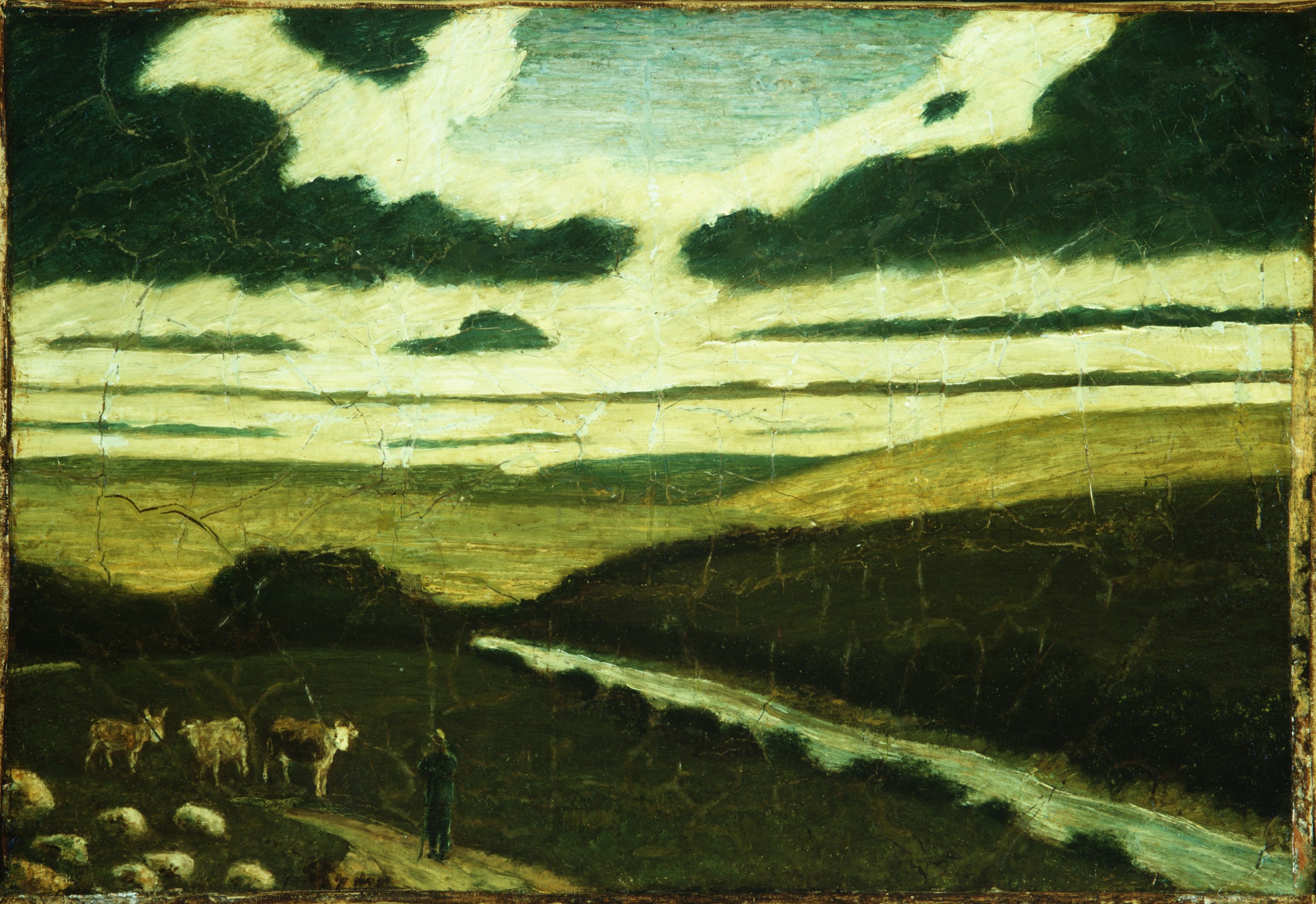
Stieglitz and “291.”
The individual most responsible for bringing new styles of painting to the United States was photographer Alfred Stieglitz. He became the leader of the Photo-Secession movement, which championed photography as an art form. In furthering the movement’s aims, he opened a gallery in New York City. It was located at 291 Fifth Avenue and was commonly called “291.”
Stieglitz exhibited more than photographs at “291.” The gallery became the first in the United States to exhibit paintings by such European masters as Cézanne, Matisse, and Picasso. Gradually, Stieglitz became less interested in European art and more concerned with establishing a new art movement on American soil. He provided an exhibition space for several young American artists. He supported these artists not only by exhibiting and selling their work, but also by providing encouragement, reviews, and publicity. The artists Stieglitz exhibited at “291” included such important American painters as Charles Demuth, Arthur Dove, Marsden Hartley, and Georgia O’Keeffe.
Precisionism
was the first new style of the 1900’s to emerge in the United States. It originated in the 1920’s with Charles Demuth and Charles Sheeler as its leaders. Precisionism merged with Cubism and realism into a distinctly American style. Precisionism eliminated the complexities of Analytic Cubism but made something more abstract and angular of its realistic themes. The subject matter of Precisionist painting consisted largely of views of the buildings and industrial structures typical of the American landscape. For example, Demuth’s My Egypt portrays a grain elevator in Lancaster, Pennsylvania.
Georgia O’Keeffe
came to represent the new American approach to art. O’Keeffe, who was married to Alfred Stieglitz, spent her career painting particularly American subjects in realistic detail. She created dozens of abstract paintings, but she is perhaps best known for her carefully observed paintings of simple objects, such as shells, rocks, and flowers. In such works as Black Iris, O’Keeffe combined precise observation with a keen sense of design.
Regionalism.
Stieglitz and such artists as Demuth and O’Keeffe were important because they forged a unique American identity out of European art of the 1900’s. But some American artists rejected the art principles of Europe in favor of a vision of homespun Americanism. In the late 1920’s, many American artists became strongly anti-European. They developed an approach to painting called regionalism.

During the 1930’s, Benton attempted to move the center of the American art world away from New York City to the heartland of the country, the Midwest. Benton and other regionalists cultivated a nostalgic interest in the local scenes of American life that were disappearing. As the spokesperson for regionalism, Benton attacked European art and the international character of New York-based artists, especially those associated with Alfred Stieglitz.
To counteract European art, Benton developed a monumental style that found its expression in many large murals in public buildings. Benton’s mature style can be seen in murals he painted for the State Capitol in Jefferson City, Missouri, in 1936. In such works, Benton referred to Renaissance painting for stylistic influences. His figures, with their bulging, muscular bodies, resemble those seen in the paintings by Michelangelo.
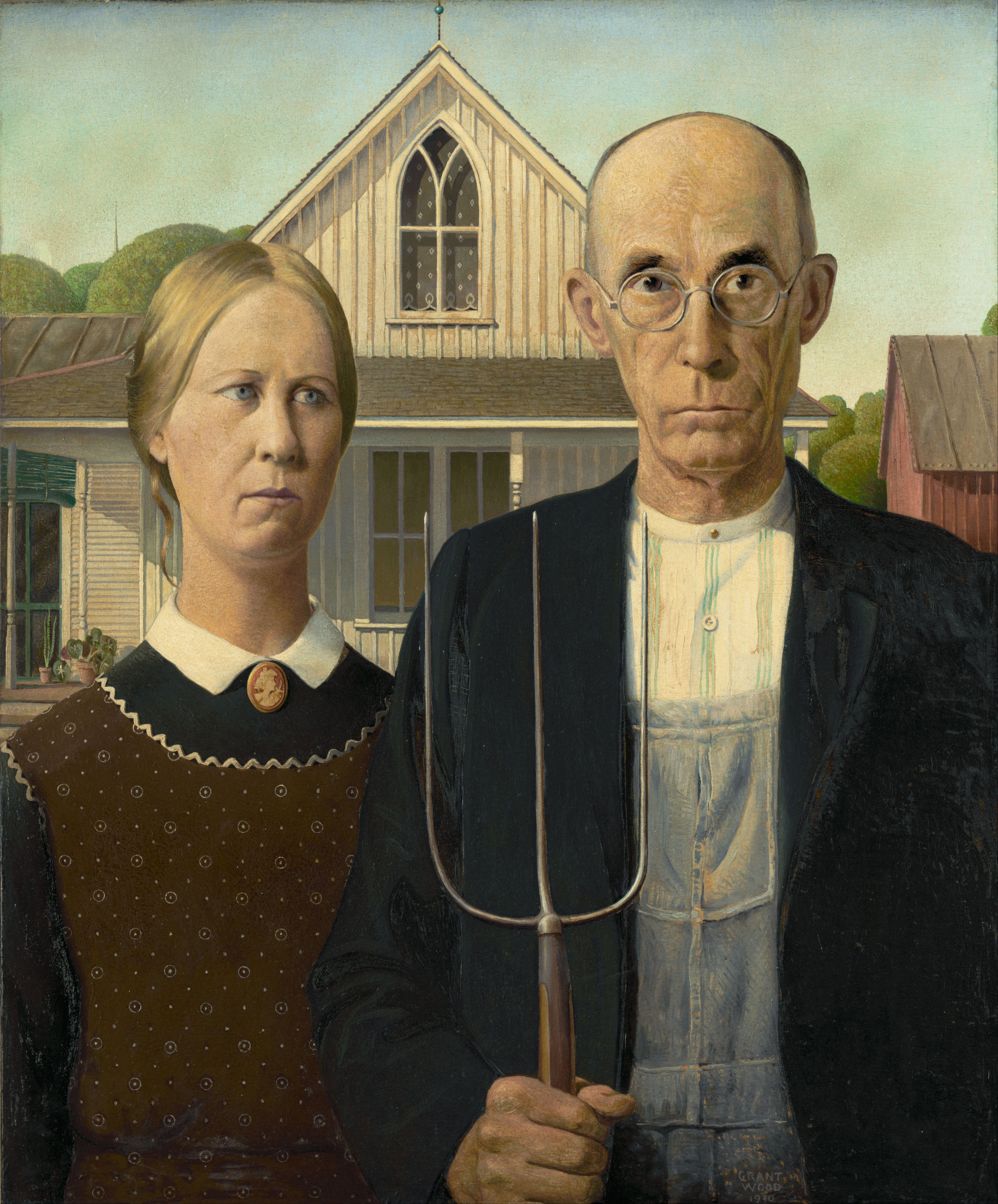
Like Benton and Wood, Curry gained recognition for painting scenes of Midwestern life, such as a religious baptism and a farm family fleeing an approaching tornado.
Modern Mexican painting.
There were two major challenges to the regionalist hold on American painting during the 1930’s and 1940’s. The first came from the arrival of mural painters from Mexico.
The Mexican muralists were Diego Rivera, José Orozco, and David Siqueiros. Rivera, perhaps the best known of the three, received several major mural commissions in the United States during the 1930’s. His most significant commission was the Detroit Industry murals executed at the Detroit Institute of Arts. 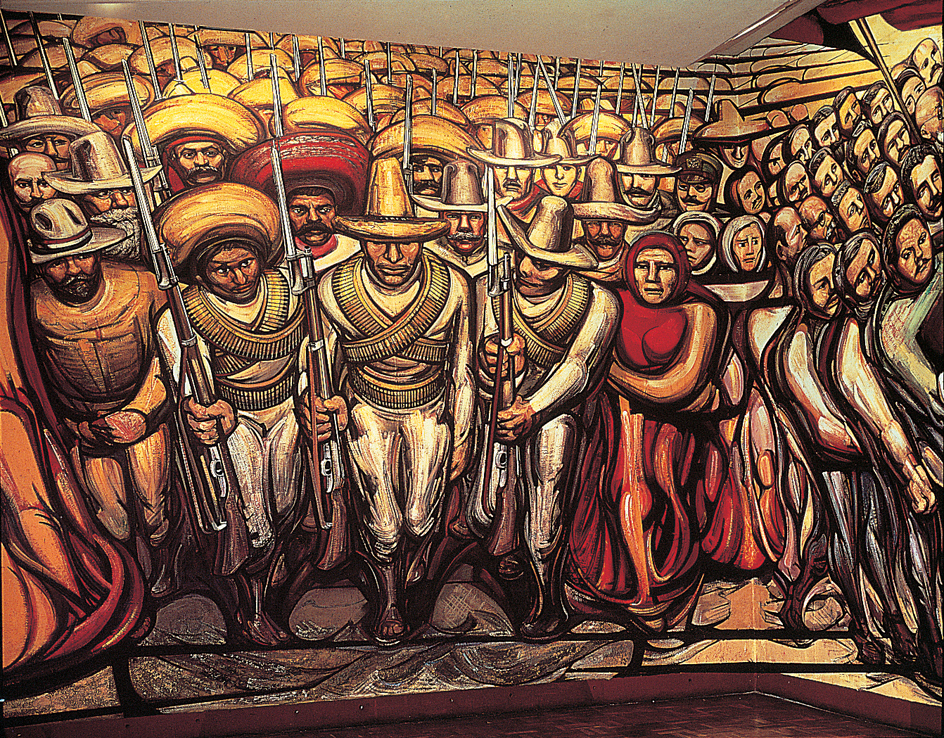
Rivera worked toward creating a national Mexican style that reflected the history of the Mexican people as well as the socialist spirit of the Mexican Revolution of the early 1900’s. Rivera’s mural style influenced artists in both Mexico and the United States. It combined decorative folklore elements of the Mexican art tradition with dramatic realism.

Another influential Mexican painter of the 1930’s was Frida Kahlo, who was married to Diego Rivera. Kahlo’s paintings were largely autobiographical in subject matter. She produced many self-portraits depicting herself in different psychological states. Stylistically, she was interested in the kinds of heroic representation produced by her husband. However, more than Rivera, she was firmly rooted in the traditions of Mexico and almost always portrayed herself in traditional Mexican costumes. Her subject matter is also concerned with traditional Mexican culture. In Self-Portrait with Thorn Necklace and Hummingbird, Kahlo wears a thorn necklace that draws blood from her neck, referring to the ritual bloodletting practiced by Aztec priests in ancient Mexico.
Europeans in America.
The second major challenge to regionalism came from the arrival of many leading European artists who settled as refugees in the United States during World War II. One such artist was Piet Mondrian, who arrived in New York City in 1940 and died there in 1944. Most of the important Surrealists also came to the United States. They included Andre Breton, Max Ernst, Yves Tanguy, and Andre Masson, as well as Marcel Duchamp, who was close to both the Surrealists and Dadaists.
With the presence of many European painters, as well as Mexican muralists, New York City became a painting center unsurpassed anywhere in the world. The presence of so many important artists provided a framework for the formation of a new American style. The Europeans were a powerful influence on the first important American art movement of the postwar period, Abstract Expressionism.
Abstract Expressionism
was a loosely organized movement. The pictures of the Abstract Expressionists did not resemble one another’s in most cases, but they all shared a desire to create an important American tradition of painting. Although the Abstract Expressionists developed diverse styles, they still worked to make something genuinely expressive from the abstract tradition they inherited from Europe.

Perhaps the most renowned of the Abstract Expressionist painters was Jackson Pollock. Pollock radically altered the traditional techniques of painting when he poured his paint onto canvases that were tacked to the floor. The results were compositions made up of tangles of poured paint. The lines formed by the fluid reflected the movements of the artist’s arm as he dripped the paint onto the canvas. Pollock produced several mural-sized canvases filled with dense, dripping lines that became a kind of automatic writing related to the technique that was practiced by the Surrealists. The character of each of Pollock’s “drip” paintings differs in their inventive patterns, rhythms, densities, and textures.
In general, the early Abstract Expressionists favored untraditional materials applied in new ways. For example, both Pollock and de Kooning used car enamels and house paints when they wanted their paintings to have an especially raw look.
The quickness and energy of de Kooning’s brushstrokes and Pollock’s drip paintings are evident in the finished works, leading to the term action painting to describe the painting process. Another group of Abstract Expressionists emerged later than the action painters. They were called field painters and included Barnett Newman, Mark Rothko, and Clyfford Still.
Newman painted large canvases that often consist of one strong color, sometimes divided by horizontal or vertical stripes. Rothko eliminated subject matter in his paintings around 1947 and adopted washes of color that seem to drift across the canvas. For Rothko, color takes over for the gestures of Pollock and de Kooning in works like Number 8. Rothko meant his paintings to be perceived at once, as a whole. Similar concerns can be seen in Clyfford Still’s work. Still’s expanses of color are less transparent than Rothko’s. Instead, Still constructed his paintings from thickly applied paint. The compositions evoke images of prehistoric landscapes. Areas of color are joined with craggy fissures of paint that lend themselves to symbolic associations with the earth and its textures.
Color-field painting.
A group of artists emerged during the 1950’s and 1960’s who moved away from both subject matter and the outward emotionalism found in Abstract Expressionism. They tried to reduce painting to the purity of color on a flat plane. These artists became known as color-field painters and included Helen Frankenthaler, Morris Louis, Kenneth Noland, and Jules Olitski.
The color-field painters abandoned the brush marks that had been so vital to many Abstract Expressionists. Instead, they introduced a technique in which thinned paint was poured onto unprimed canvas and allowed to soak into the canvas in abstract designs. Helen Frankenthaler was the first artist to use this technique effectively in her landmark painting Mountains and Sea. Frankenthaler was influenced by the poured paintings of Jackson Pollock. She attempted to work automatically as Pollock had done, capitalizing on accidents and spills to create the painting’s composition.
Morris Louis and Kenneth Noland saw Mountains and Sea almost immediately after its completion and began experimenting with the same technique. They were soon producing mural-sized paintings filled with translucent color. Their works eliminated subject matter and drawing in favor of pure color.
The revival of subject matter.
During the postwar period, some artists tried to restore subject matter to painting. During the mid-1950’s, Robert Rauschenberg and Jasper Johns believed that art could be changed through addition rather than reduction. To this end, they adopted the collage technique, adding paper, cloth, and other objects to the surface of their canvases. Gradually, the work became more sculptural. Objects as diverse as stuffed birds and inflated tires became part of their art. Both Rauschenberg and Johns looked to the work of Dada artists, such as Kurt Schwitters, as a model for creating their work.
In Rauschenberg’s Bed, the artist combined sheets, a pillow, and a quilt as the components of his construction. He forced the cloth elements to function as a kind of canvas as he smeared the surface with paint. This type of construction has been called an assemblage, referring to the act of gathering materials and combining them to build images.
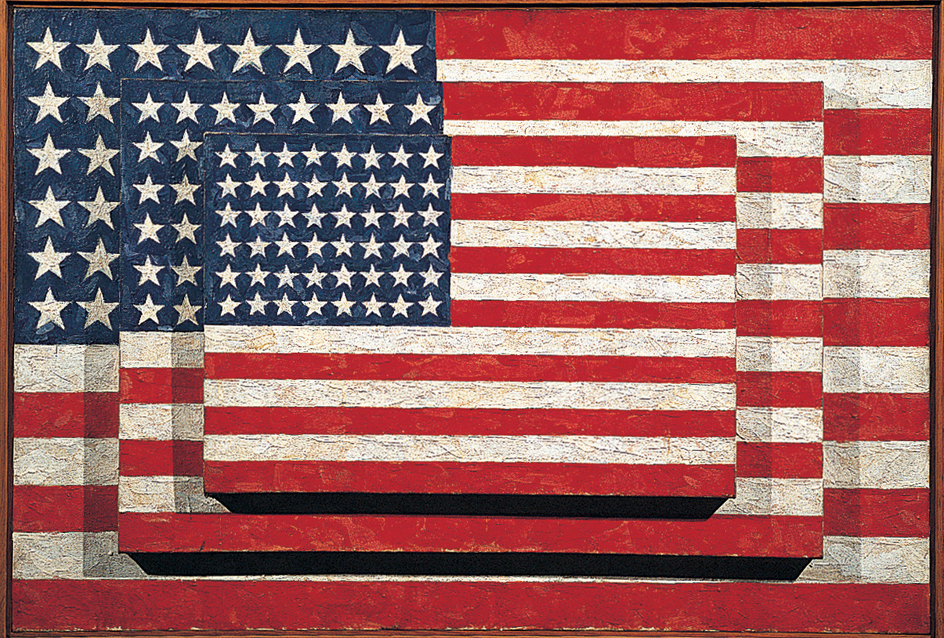
Pop Art.
The work of Rauschenberg and Johns became enormously important in the development of Pop Art during the 1960’s. Pop Art took its themes from subjects not previously associated with fine art. These subjects included comic strips, motion pictures, and especially advertising and other types of commercial art. The chief Pop artists were Jim Dine, Roy Lichtenstein, James Rosenquist, and Andy Warhol.
Pop Art challenged the fine arts tradition in more than just its subject matter. Pop artists used many of the techniques of commercial artists to achieve new effects. For example, in many of his paintings, Lichtenstein used tiny benday dots of color he created with a perforated metal screen and a toothbrush. Benday dots make up the images in color comics. The dots are used in the right half of Lichtenstein’s Whaam! 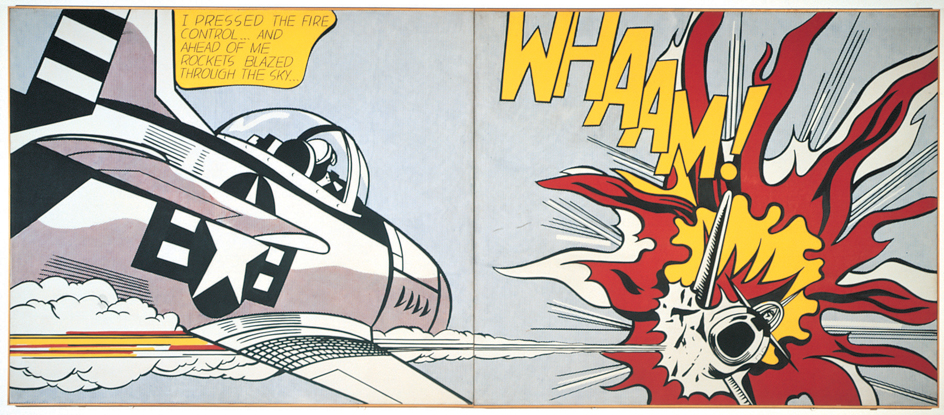
Many viewers considered Pop Art to be playful and trivial. However, Pop artists were serious about their work. They rejected the sense of superiority they saw in postwar abstraction and favored an art that would appeal to a broader segment of society.
Andy Warhol exploited commercial silk-screen techniques, making paintings by forcing ink or paint through a piece of silk onto canvas. The silk-screen process allowed Warhol to use any available printed image as a source for his painting. Additionally, with the silk-screen, Warhol could reproduce his images over and over in virtually identical copies. In the Marilyn Monroe Diptych, he used the same screen to repeat the movie star’s image across the length of the canvas. He could also use the same screen to reproduce additional canvases. Many of Warhol’s works were multiple images of newspaper photos, soup cans, and automobile accidents.
Minimalism
was an abstract style that appeared particularly in the United States during the 1960’s. Minimalist painters, such as Agnes Martin and Frank Stella, concentrated on color, line, and shape. Most Minimalist works have a unified composition and emphasize geometric abstraction.
New image painting.
In 1978, the Whitney Museum of American Art in New York City presented a group of artists in an exhibition called “New Image Painting.” The new imagists included Jennifer Bartlett, Neil Jenney, and Susan Rothenberg. The group shared a revived interest in figurative painting, which depicts human figures and other recognizable subjects. They believed in the potential of painting that was more openly communicative than the styles that had preceded them.
Susan Rothenberg painted canvases that combined an interest in figurative subject matter with an interest in the more formal properties of design. In the mid-1970’s, the flat silhouette of a horse appeared in her paintings. Eventually, the horse yielded to the human figure in her work. In her later paintings, Rothenberg’s figures float in a submarine world of fluid brushwork, the figures silhouetted against shimmering luminous paint. An example of this phase of her work is Mondrian Dancing.
Recent painting
During the late 1900’s and early 2000’s, many painters returned to traditional techniques and subject matter. Some artists developed a new strain of figurative painting. Other painters continued to create abstract works.
Neoexpressionism.
German artists were in the lead during the 1980’s in reviving subject matter after the dominance of abstraction during the previous few decades. The works of Anselm Kiefer and Gerhard Richter showed a new tendency toward Expressionism. By 1980, their paintings were referred to as Neoexpressionism. The term since has been broadened to include works by American, British, and Italian artists.
Kiefer produced paintings in which he explores memories of Nazi Germany and of the Holocaust, the mass murder of European Jews and others by the Nazis. Kiefer painted several symbolic landscapes, such as Märkischer Sand (March Sand) Kiefer presents a vast panoramic field with furrowed lines sweeping majestically toward the horizon. The field is labeled with the names of German towns. As if to emphasize the unchanging character of the land, Kiefer mixed sand into the paint. He also added sand in other landscapes, as well as grass, straw, and twigs.

Richter has worked in a broad variety of styles, including Neoexpressionism. Some of his paintings are richly colored abstractions, but he has also worked in a figurative style. Some of Richter’s works combine painting with photographic sources.
American versions of Neoexpressionism have been far less political than the German variety. Such artists as Julian Schnabel and Jean-Michel Basquiat produced canvases that featured prominent brushwork meant to lure the viewer into the picture. Schnabel’s work from the early 1980’s features broken crockery that has been glued to the surface of the painting. These pieces of broken plates act as an extension of the brushstrokes, adding shape, color, and texture to the painting.

Basquiat was born into a Haitian-Puerto Rican family, and the subject matter of his paintings reflects his cultural background. His canvases combine many verbal elements—names, titles, phrases, and poetry—with an odd assortment of forms. These forms included masks and skulls, as well as cartoonlike figures that resembled robots.
Basquiat’s career straddled Neoexpressionism and the graffiti movement. Graffiti artists, led by the American artist Keith Haring, painted or scratched words or drawings on the walls of public places.
Postmodernism
has so many meanings that a single definition is impossible. In general, Postmodernist painters selected and used what seemed best from a variety of sources. Several painters explored Postmodern ideas in their works, including the American artists Eric Fischl, Deborah Kass, Sherrie Levine, and David Salle.
Fischl painted figurative works, many with disturbing sexual overtones. Kass absorbed the work of Andy Warhol in a series of paintings that examine his celebrity portraits while exploring Kass’s own feminist concerns. Levine became known for her graphite and water-color reproductions of works by such modern masters as Kasimir Malevich and Piet Mondrian.
Salle’s work uses different elements, both words and images, and combines them in surprising ways. Salle allows his images to overlap, forcing the viewer to search for possible meanings and connections among the visual elements.
Postmodern artists often took elements from both high and popular culture, frequently blending them in the same work. The Japanese artist Takashi Murakami pioneered a style he called “superflat,” which combined American Pop Art with influences from a form of Japanese animation called anime and other elements of Japanese pop culture.
Abstract artists

The American artist Brice Marden continued the development of abstract painting influenced by the drip-and-pour style of Jackson Pollock and by Chinese calligraphy. In The Propitious Garden of Plane Image, Second Version (2000-2006), Marden painted vivid arrangements of rhythmic lines against six colored panels.
Fresh approaches.
By the end of the 1900’s, many painters looked to the past for styles and influences. Artists turned to such earlier styles as German Expressionism and Pop Art, plus art of the Renaissance and Baroque periods. Artists explored the human figure with an excitement unseen for several decades. Leading artists included John Currin and Lisa Yuskavage of the United States, Luc Tuymans of Belgium, and Chris Ofili and Jenny Saville of the United Kingdom.
Saville examined the female body from a variety of viewpoints and angles. She sometimes broke up her nudes into fragments of body parts, recalling the experimentation of Cubism.
